

Baltic Transport
bimonthly-daily companion
BLUE SUPPLY CHAINS
The hydrogen blueprint
Rivers reimagined
Where sea meets rail
MARITIME
The twists and turns of fate. Interview with Kimmo Naski
Protecting subsea cables in the Baltic – and beyond
Safeguarding the maritime domain in the Baltic – militarily & commercially TECHNOLOGY
A call for rigorously scrutinising the green credentials of future fuels
The Port of Opportunities
The Port of HaminaKotka is a multipurpose seaport serving trade and industry. This major Finnish port is an important hub in Europe and in the Baltic Sea region.
Welcome to the Port of HaminaKotka!
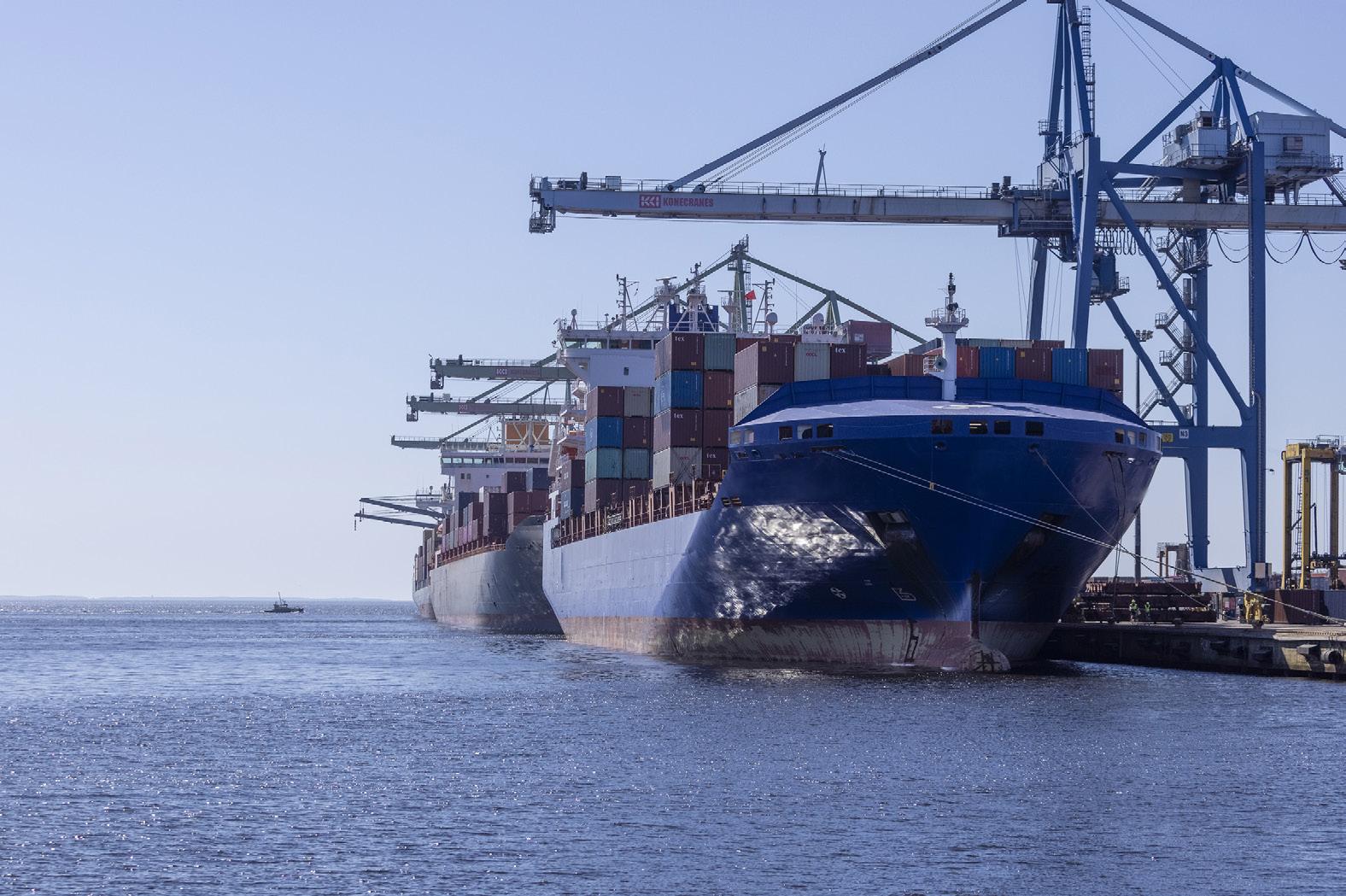
Dear Readers,

Afew letters sponsor this autumn’s issue, manifestly M as in military. First, you’ll read about the security of subsea infrastructure (or rather the lack thereof…), a matter of national/regional/EU importance, hence an increasingly important task for the armed forces. As such, another article is about safeguarding the maritime domain in the Baltic (militarily & commercially); not with fighter planes sent to shoot down makeshift drones (which is highly effective but not sustainable, say, like squishing a mosquito with a shotgun blast…) but with un-crewed drones that can patrol our precious sea for months on end at the fraction of the cost of a destroyer. Be prepared to see more of these as you ferry across our region. Third, even the finished vehicle logistics is concerned with military issues, as was pronounced during the latest gathering of the industry in Amsterdam this October – markedly with the presence of NATO. Last, at this year’s Baltic Ports Conference (BPC), the agenda of which we had the satisfaction to craft, the letter M was also there – and double so as in military mobility, including the EU funds the transport & logistics business would like to tap into in order to help make Europe prepared in a better way (but first the block needs to kick the budget into high gear in this area). Though, when asked about their feelings on the prospect of gearing their premises with military stuff, ports and terminals were somewhat sceptical; they would rather prefer some kind of tech/digital means of neutralising hostile drones instead of projectiles flying over the head and littering the quays and yards with debris, unexploded shells, and whatnot. That sentiment is understandable, though it seems NATO has a lot of catching up to do in the hybrid warfare race. During the above BPC, the Ukrainian Sea Ports Administration shared footage and experiences of what it means to carry out port operations when one’s quays and yards turn into rubble with exploding ordnance…
In a more heartening manner, the remainder of the issue is composed with all your good ol’ Ses, Ts, and Ms. The Sustainability column puts the spotlight on offshore wind energy, warms you with a cuppa coffee (and what you, i.e. the transportation business, can do with used grounds to warm yourself even more – and help the planet, plus your ESG score, as a bonus), draws the critical limits to wind-assisted propulsion in the form of modern rotor sails likewise uncovers the emission-reduction potential of clean hulls, and more. Speaking of propulsion, Technology is big on nuclear ships, while also reasonably sceptical about the green credentials of future fuels (as they are marketed now).
MARITIME STARTS WITH THE END; THE END OF A LONG AND FRUITFUL CAREER OF ONE OF OUR DEAREST FRIENDS, THE PORT OF HAMINAKOTKA’S KIMMO NASKI, WHO WILL RETIRE BEFORE LONG. WE HAD THE PLEASURE OF PICKING KIMMO’S BRAINS ABOUT HIS POST-WORK PLANS, PLUS GETTING SEVERAL INSIGHTS INTO THE WORLD OF TRANSPORT & LOGISTICS. THANKS, KIMMO, IT HAS BEEN A GENUINE DELIGHT TO MEET YOU! SIR, YOU WILL BE SORELY MISSED! PLEASE WRITE THIS GOLDEN CHAPTER OF YOUR LIFE WITH NOTHING BUT TASTEFUL ADVENTURES – AT HOME AND ABROAD. KIPPIS!
Finally, a special column highlights the Blue Supply Chains project, featuring reads on making Umeå a hub for future energy carriers, e-revitalising the Lithuanian inland waterways for cargo, and (re)fitting Germany-Sweden rail ferries into the EU green landscape.
Baltic Transport Journal
Publisher
BALTIC PRESS SP. Z O.O. Address: Aleja Zwycięstwa 96/98 81-451 Gdynia, Poland office@baltictransportjournal.com
www.baltictransportjournal.com www.europeantransportmaps.com
President of the Board BOGDAN OŁDAKOWSKI
Managing Director
PRZEMYSŁAW OPŁOCKI
Editor-in-Chief
PRZEMYSŁAW MYSZKA przemek@baltictransportjournal.com
Roving Editor MAREK BŁUŚ marek@baltictransportjournal.com
Proofreading Editor EWA KOCHAŃSKA
Contributing Writers
KRISTĪNE CARJOVA, NICK COWLEY, MATTEO DI MAIO, IAIN GRAINGER, ALEXA IVY, BAHEZ KARIM, JANNE KOJO, AMIT KUMAR, MARKO MÄENPÄÄ, ROB MORTIMER, JOHN MUSTIN, NITESH RANVAH, MONIKA ROGO, IRENE ROSBERG, FITZWILLIAM SCOTT, JUKKA SUVANTO, ANDRZEJ URBAŚ
Art Director/DTP DANUTA SAWICKA
Head of Marketing & Sales PRZEMYSŁAW OPŁOCKI po@baltictransportjournal.com
If you wish to share your feedback or have information for us, do not hesitate to contact us at: editorial@baltictransportjournal.com
Contact us: PRZEMYSŁAW OPŁOCKI tel.: +48 603 520 020

Przemysław Myszka

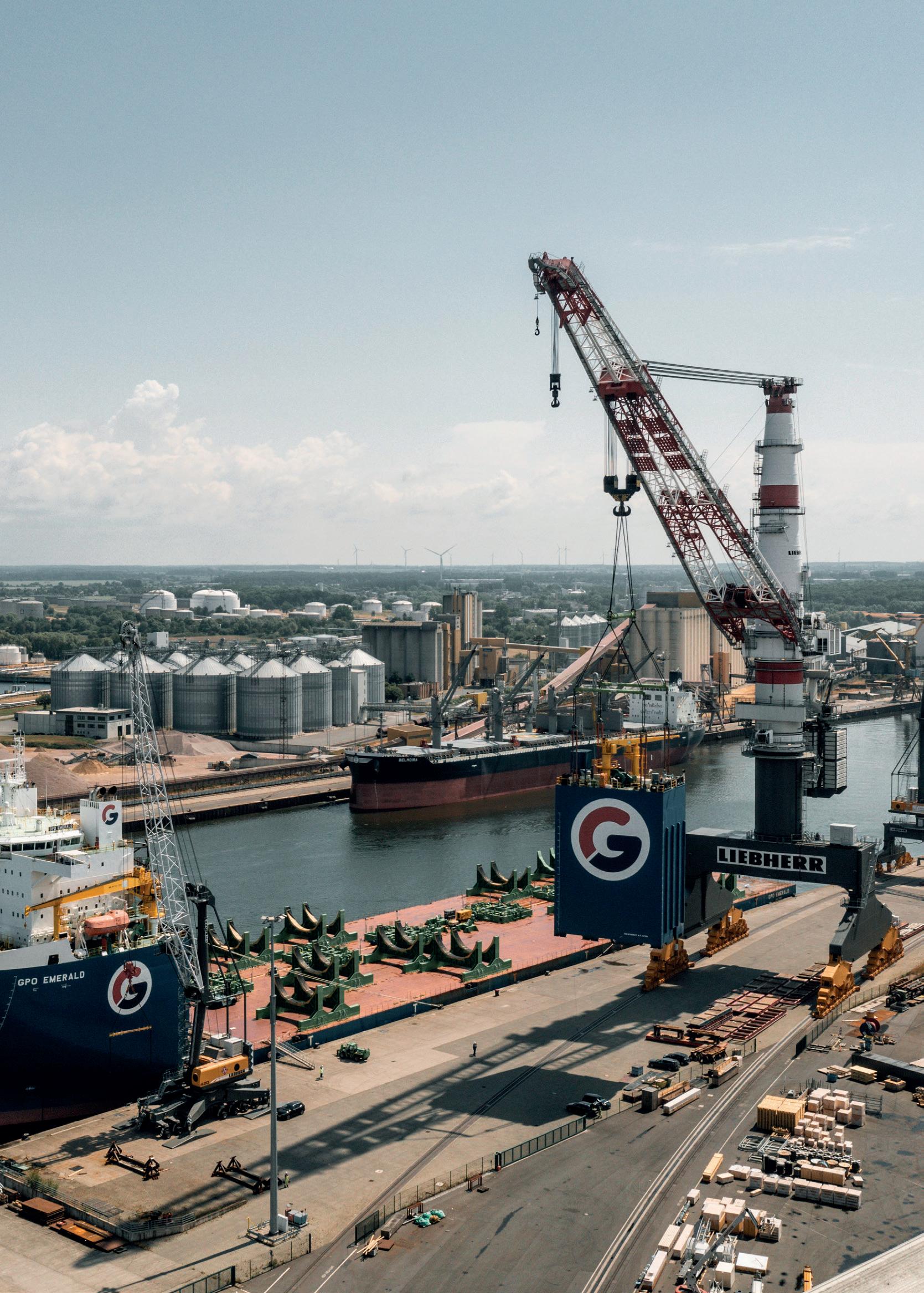
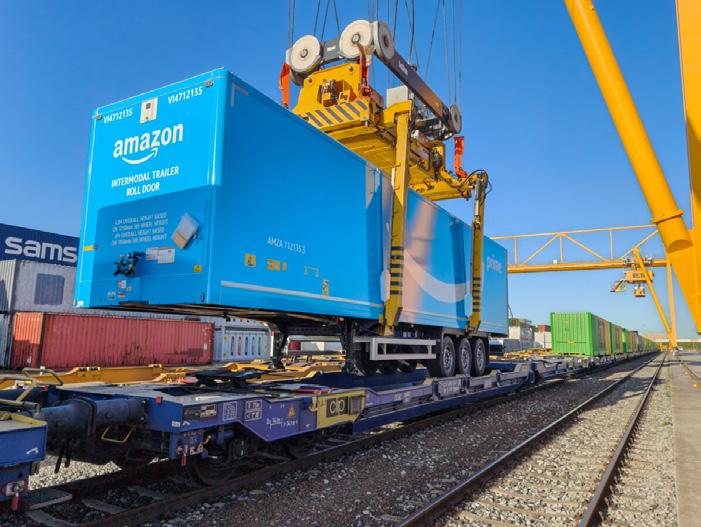
3 REGULAR COLUMNS
3 Editorial
8 BTJ calendar of events
10 Safety news by TT Club
12 Market SMS
14 What’s new?
16 Map news
18 Venture forth
20 What’s in the Cabinet
21 Chart of the issue: Journey towards (ammonia & methanol) technology tipping point in shipping
64 Events: The new (car) world order?
– ECG Conference 2025, 16-17 October, Amsterdam by Przemysław Myszka
66 Who is who
22 BLUE SUPPLY CHAINS
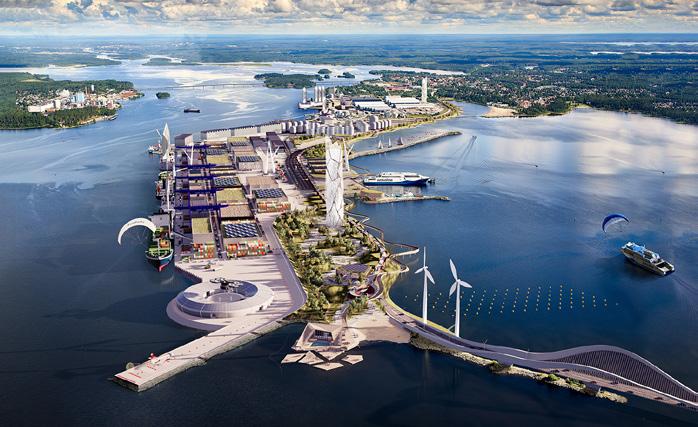
22 The hydrogen blueprint
– Key takeaways from Blue Supply Chain’s Umeå Roadmap by Ewa Kochańska
24 Rivers reimagined
– Key takeaways from Blue Supply Chain’s Lithuanian Roadmap by Ewa Kochańska
26 Where sea meets rail
– Blue Supply Chains on the Rostock-Trelleborg shortcut to cleaner trade by Ewa Kochańska

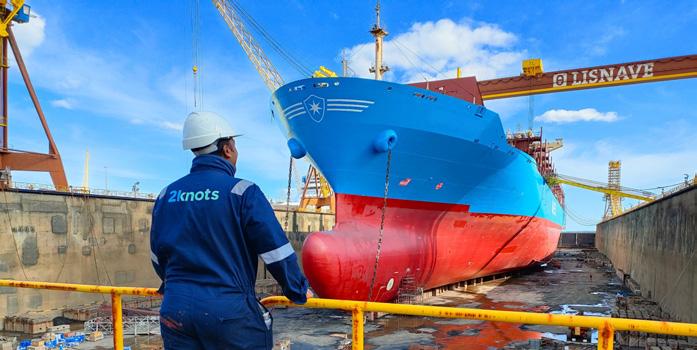
28 SUSTAINABILITY
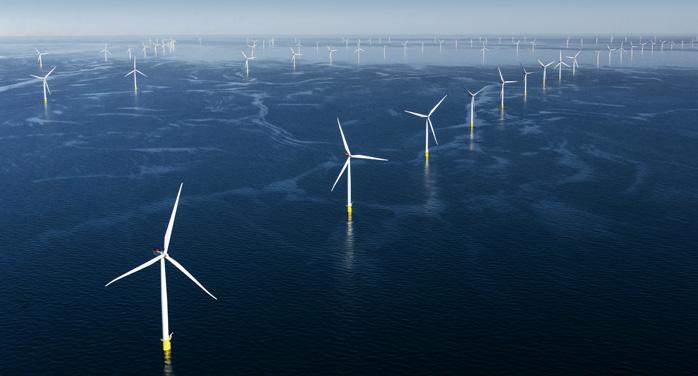
28 The 128-gigawatt tug – Insights from the Development of OWE in the Baltic Sea report by Andrzej Urbaś
30 A hot new life – From coffee to waste to burning logs by Bahez Karim
32 Critical limits –
Key takeaways from TalTech’s Economic Feasibility and Operational Performance of Rotor Sails in Maritime Transport by Kristīne Carjova
34 Clean hulls = clear gains
– Biofouling’s (untapped) decarbonisation potential by Nick Cowley
36 The (interwoven) propulsion crossroads
– Navigating the choices for ships of today and tomorrow by Nitesh Ranvah, and Amit Kumar
38 Turning the volume down
– How to lower underwater radiated noise (already at the ship design phase) by Jukka Suvanto

Big news. We’re getting bigger. And better. The Port of Oxelösund is growing. With expanded capacity for 10.5 million tons of goods every year, we are now growing to be Sweden’s largest port for bulk handling.
This marks new opportunities for our present and future clients. Higher capacity and smoother logistics from ship to shore. A new quay, expanded storage areas and modernized yards. Smarter systems and 24-hour operations. It’s all part of Oxchange, our transformation journey that’s redefining our role in Baltic logistics.
Discover how our port can become your platform for growth.

oxhamn.se


40 MARITIME
40 The twists and turns of fate
– Interview with Kimmo Naski, CEO & Satamaneuvos | Port Counsellor, the Port of HaminaKotka by Przemysław Myszka
43 A new chapter
– The new Port Reform Toolkit helps build resilience in uncertain times by Ewa Kochańska
46 The right blend
– Evolving maritime leadership in the Baltic Sea region by Irene Rosberg
48 A lot of joy
– How NemaX grabs gains for VLI – in productivity, maintenance, and safety by Fitzwilliam Scott
50 Tolerate uncertainty – go forward
– How changes in the operating environment have impacted the Finnish port sector by Janne Kojo, and Marko Mäenpää
52 Fragile lifelines
– Protecting subsea cables in the Baltic – and beyond by Iain Grainger
54 You cannot defend what you cannot see
– Safeguarding the maritime domain in the Baltic – militarily & commercially by John Mustin
56 Quality – wherever the work takes us
– Rethinking retrofit execution for high-demand vessels by Matteo Di Maio

58 Baltic ports gathered in Gdańsk to define the future of regional maritime cooperation by Monika Rogo

60 TECHNOLOGY
60 The (zero-emission) prize at the end of the (long) race – Tech & regulatory developments towards nuclear ship propulsion by Alexa Ivy
62 Cure worse than illness?
– A call for rigorously scrutinising the green credentials of future fuels by Rob Mortimer


TransLogistica Poland , 4-6/11/25, PL/Warsaw, translogistica.pl/en
TransLogistica Poland is a place where shippers and cargo owners can find comprehensive and highest quality logistics services for their goods. The exhibition is also perfect for showcasing a variety of telematics and fleet-management solutions to transport companies, including local and international carriers.
Baltic Ports for Climate Conference 2025, 19-20/11/25, PL/Gdynia, bpoports.com/baltic-ports-for-climate-conference-2025
The Baltic Ports Organization’s event, hosted by the Port of Gdynia, will tackle some of the most pressing environmental and sustainable development issues, including EU Port Strategy vs climate policies, green port strategies, investing in future energy, and decarbonisation of port operations & supply chains (featuring insights from the Blue Supply Chains project).

Offshore Energy Exhibition & Conference (OEEC), 25-26/11/25, NL/Amsterdam, oeec.biz
TOEEC is a leading international event in the offshore energy industry (wind, hydrogen, oil & gas and marine energy) held each year in Amsterdam that serves as an essential gathering point for professionals, experts, and companies active in the offshore energy sector and beyond.


































SAFETY AND SHIPPING REVIEW 2025 – PUBLISHED
The fast-changing geopolitical landscape is creating additional risks and challenges for an industry already juggling the energy transition and the legacy of the coronavirus pandemic, according to Allianz Commercial ’s newest Safety and Shipping Review “The industry faces an increasingly volatile and complex operating environment, marked by attacks against shipping, vessel detentions, sanctions, as well as the fallout from incidents involving damage to critical sub-sea cables. Furthermore, the ripple effect of increasing protectionism and tariffs threatens to remake supply chains and shake up established trade relations,” the insurer underlined in a press brief. Fires, collisions, and groundings are still the primary drivers for total losses of large vessels. That said, whereas in the 1990s the global fleet was losing 200+ vessels a year, this total had halved 10 years ago and is now down to a record low of 27 as of the end of 2024 (from 35 in 2023). The Review also brings forth the shadow fleet. “Today, around 17% of the world tanker fleet is thought to belong to the shadow fleet: estimates indicate there are close to 600 tankers trading Russian oil alone. Shadow fleet vessels have been involved in tens of incidents around the world, including fires, collisions, and oil spills.” Next, “large vessel fires are still a major concern for hull and cargo insurers,” noted Allianz. There were seven total losses reported across all vessel types during 2024 (like the year before). The number of incidents overall was up year-on-year to a decade high of 250 (across all vessel types). Around 30% of these fire incidents occurred on either container, ro-ro, or other general cargo freighters (69). Altogether, over 100 total vessel losses have been caused by fires in the past decade. “Efforts to mitigate these risks are underway, with regulatory changes and technological advancements aimed at addressing mis-declared cargo, a primary contributor to such fires. This is critical as the electrification of the global economy poses further challenges given the growing number of lithium-ion batteries and battery energy storage systems being transported,” commented Allianz.

NEW LIGHT ON CONTAINER LOSSES AT SEA
The World Shipping Council reported in June this year that 576 containers were lost at sea in 2024 (out of the approximately 250 million). It was more than in 2023, when 221 boxes flew overboard, but still below the 10-year average of 1,274. A major driver for the 2024 rise in incidents was a 191% increase in container ship transits around the Cape of Good Hope, an area characterised by severe weather, such as many consecutive days with high waves, to avoid Red Sea attacks. According to a May 2025-published analysis (nine cases in 2011-22 involving the loss of 484 containers) by the International Maritime Organization (IMO), high waves and high winds were the prevailing external factors that led to the incidents. Commenting on the publication, TT Club highlighted in one of its TT Talks, “The analysis found that container loss or damage commonly occurred at ships’ sterns due to a combination of hydrodynamic forces, ship motion, and structural stresses. IMO said that structural flexing of the hull at the stern increases the stress on twist locks and lashings, which increases the likelihood of failure. Parametric rolling (a potentially violent combination of pitching and rolling), resonance effects, and sudden course changes also amplify these risks, making the stern particularly vulnerable to container losses in bad weather.” TT Club also brought forward the findings from the 3.5-year-long TopTier: Securing Container Safety project the insurer partook in. After analysing 44 incidents over the past two decades, involving the loss of nearly 10,000 containers, parametric rolling was found to be the most likely cause of large incidents. The TopTier report also found that single-bay losses often resulted from local failures and stack resonance. Surveys and interviews with 1,500+ sea and shore personnel revealed further challenges – in overseeing the container stowage plan execution and its validation, predicting vessel response to certain weather conditions, and the inconsistent use of navigation software tools. Key recommendations from the project include implementing operational guidance for proactive avoidance of off-design conditions such as parametric rolling; harmonising performance and functional standards for onboard lashing software; improving inspections of lashing gear and containers; recognising the use of onboard lashing software in rules and regulations; including multi-bay stack resonance effects in container securing computations; addressing uncertainty in container stowage positions; and improving the enforcement of verified gross mass requirements. “Each incident is a stark reminder to everyone in the transport and logistics sector of the need to take steps to prevent such losses, recognising that every lost container can have major environmental, financial, and reputational impacts for supply chain actors,” TT Club cautioned.
CARGO SAFETY PROGRAM – LAUNCHED
The World Shipping Council ( WSC ) has kicked off its Cargo Safety Program, an industry-led initiative to detect mis- and undeclared dangerous goods to prevent ship fires, as well as to protect crews, vessels, customers’ cargo, and the marine environment. A digital cargo screening tool powered by the National Cargo Bureau ’s technology sits at the solution’s heart. It scans millions of bookings in real time using keyword searches, trade pattern recognition, and AI-driven algorithms to identify potential risks. Alerts are reviewed by carriers and, when needed, verified through targeted physical inspections. The Program also establishes common inspection standards for verifying shipments and an incident feedback loop to ensure lessons from real-world cases strengthen prevention. At launch, carriers representing over 70% of global TEU capacity have joined the Program. “By working together and using the best available tools, we can identify risks early, act quickly, and prevent accidents before they happen,” Joe Kramek , President & CEO of WSC, said. “The Cargo Safety Program is a powerful new layer of protection, but it does not replace the fundamental obligation shippers have to declare dangerous goods accurately. That is the starting point for safety, and it is required under international law,” he added.

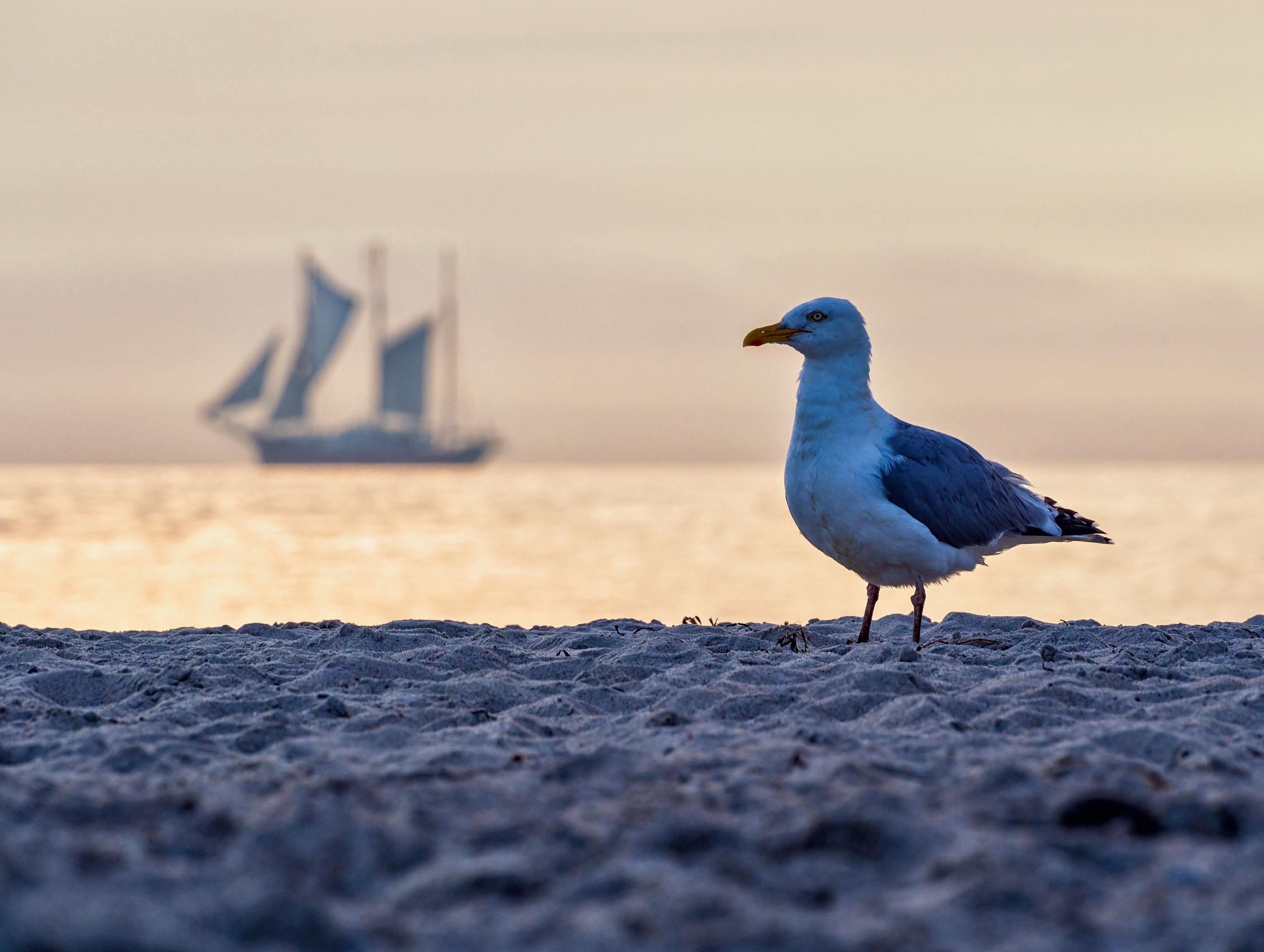
The Port of Gothenburg:
470 thousand TEUs handled in H1 2025 (+0.4% yoy)
Container rail traffic totalled 260k TEUs, up 4.4% on the H1 2024 result. “Repositioning empty containers between ports is necessary for the logistics system to function, but ideally it should be kept to a minimum. The fact that we are handling more loaded containers while managing fewer empties reflects greater efficiency across the entire logistics chain,” highlighted Claes Sundmark, Vice President Sales and Marketing at the Port of Gothenburg. The Swedish seaport also noted in a press release, “APM Terminals, which operates the port’s container terminal, reported its best month ever in July [2025] with 47,805 TEUs handled […]” Also, more ro-ro cargo units went through Gothenburg’s quays, up 0.7% year-on-year to 272,000. The finished vehicle logistics segment saw a decrease of 6.8% yoy to 124,000 new cars. Less liquid and dry bulk were taken care of, too, 9.4 million tonnes (-13.8% yoy) and 155 thousand tonnes (-43.2% yoy), respectively. On the other hand, passenger traffic grew by 126% yoy to 579 thousand ferry & cruise travellers.
The Port of Södertälje: 2,783 ro-ro cargo units handled in H1 2025 (+3,253% yoy)
Measured in tonnes, wheeled (ro-ro) cargo going via the Swedish seaport totted up to 57 thousand (+2,750% year-on-year) – of the total of 544kt handled (+15.5% yoy). Södertälje also saw 36,106 vehicles (+40.4% yoy; that’s 71kt, +47.9% yoy) and 4,272 TEUs (-10.5% yoy; 51kt, -5.6% yoy) going over its quays. Additionally, the Swedish port took care of 202kt of liquid bulk (+14.1% yoy), 116kt of forest products (-27.5% yoy), 27kt of dry bulk (-10% yoy), and 20kt of goods classified as ‘other’ (break-bulk; no handling in H1 2024).
The Port of Pietarsaari: 778.7 thousand tonnes handled in H1 2025 (+55.5% yoy)
Whereas domestic freight traffic lost 10.9% year-over-year, down to 20.2 thousand tonnes, international cargo trade going via the Finnish seaport gained 58.7% yoy to 758.5kt. Container traffic increased by 603% from 159 to 1,117 TEUs. Pietarsaari also saw more ro-ro cargo units, up 63.7% yoy to 902.

The Port of Hanko: 100,084 ro-ro cargo units handled in H1 2025 (+33.1% yoy)
The Finnish seaport also took care of more containers, up 4.8% yearon-year to 29,268 TEUs. The Port of Hanko altogether handled 2.73 million tonnes over this year’s first half (+32.1% yoy), of which international cargo traffic accounted for 2.64mt (+31.4% yoy) and domestic for the remaining 83.7kt (+58.1% yoy). The port also welcomed more passengers travelling by sea – 969 vs 58 in H1 2024.
The Port of Liepāja:
3.43 million tonnes handled in H1 2025 (-7.2% yoy)
The first half of this year proved to be a mixed bag for the Latvian seaport: while the turnover of liquid bulk advanced by 23.5% year-on-year to 160.3 thousand tonnes, the handling of dry bulk and general cargo both contracted. Dry bulk totalled 2.26mt (-7.6% yoy), including 1.38mt of grains & cereal products (-18% yoy), 393kt of building materials (+42.5% yoy), and 181.8kt of woodchips (-27.8% yoy). Turnover of general cargo totted up to 1.02mt (-10% yoy), comprising, among many, 811.6kt of wheeled (ferry) cargo (-7.8% yoy), 162.6kt of timber (-25.3% yoy), and 42.4kt of goods in containers (+61.8% yoy). With 39,658 ferry travellers, Liepāja’s passenger traffic was down 7.6% on the H1 2024 result.
The Port of Kaskinen: 341.2 thousand tonnes handled in H1 2025 (+12.6% yoy)
Apart from 337.4kt made in international cargo traffic (+11.3% year-onyear), the Finnish seaport also took care of 3.8kt in domestic seaborne trade. Kaskinen’s H1 2025 ro-ro traffic advanced by 412% vs the corresponding period last year to altogether 1,235 units.

The Port of Klaipėda:
692,159 TEUs handled in H1 2025 (+28.8% yoy)
Ro-ro traffic also advanced in the reported period – by 3.2% year-onyear to 125,046 cargo units. Overall, the Lithuanian seaport took care of 19.07 million tonnes over 2025’s first half, up 16.8% on the result from the corresponding period last year. Passenger traffic also noted an increase, +5.1% yoy to 172.5 thousand travellers, of which ferries brought 143.6k (-2.2% yoy) and cruisers 28.9k (+66.1% yoy). Also, ferries serving Klaipėda transported 43,862 private vehicles (+5.9% yoy).
The Port of Oxelösund:
2.5 million tonnes handled in H1 2025 (+7.6% yoy)
The growth noted by the Swedish seaport was driven by goods classified as other dry bulk, which totalled nearly 1.88 million tonnes over 2025’s first half (+14% year-on-year). Trade labelled as ‘other’ (break-bulk) also rose – to 60 thousand tonnes (no handling in H1 2024). Oxelösund also took care of 398kt of ores & steel products (-13.9% yoy), 93kt of wheeled (ro-ro) cargo (-13.1% yoy), 39kt of forest products (-20.4% yoy), 25kt of containerised freight (-52.8% yoy), and 9.0kt of liquid bulk (+50% yoy). The port’s container traffic totted up to 2,177 TEUs (-51.2% yoy), while ro-ro to 2,675 cargo units (-20.8% yoy).

Photo: VRT Finland
Photo: Port of Kaskinen
The Port of Aalborg: 1.21 million tonnes handled in H1 2025 (+10.4% yoy)
Whereas the handling of liquid bulk contracted by 4.1% year-on-year to 305 thousand tonnes, the turnover of dry bulk rose by 19.8% yoy to 749kt. The remaining 159kt (+1.9% yoy) comprised general cargo goods.

The Port of Aarhus: 4.85 million tonnes handled in H1 2025 (+5.3% yoy)
Whereas the handling of both liquid and dry bulk contracted, by 16.4% year-over-year to 510 thousand tonnes and by 6.5% yoy to 1.39 million tonnes, respectively, general cargo advanced by 17.6% yoy to 2.95mt. Out of the last one, containerised freight totalled 2.75mt (+19% yoy). On the passenger side, the Danish seaport served nearly 1.5 million ferry travellers (on the domestic routes with Odden and Sælvig), up 0.6% on the H1 2024 result. The services’ ferries also transported 637,305 private vehicles (+2.4% yoy) and 4,269 ro-ro cargo units (-2.1% yoy).

HHLA: 3.17 million TEUs handled by the company’s sea container terminals in H1 2025 (+7.9% yoy)
HHLA’s facilities in Hamburg took care of 3,006 thousand TEUs, an advance of 6.9% on the H1 2024 result, while its terminals outside Germany handled 165 thousand TEUs altogether (+28.7% year-on-year). HHLA’s intermodal business grew by 19.6% yoy to 997k TEUs, including 863k carried by rail (+20.2% yoy) and 133k by road (+16% yoy).
BTJ’s on issuu.

Photo: Port of Aarhus
Photo: Port of Aalborg
The Riga-based manufacturer of heavy-lifting equipment has installed a second rail-mounted gantry (RMG) for container operations at First Dry Port Terminal in Tashkent. Having a 10.8-metre cantilever length, 7.0 m of operating outreach and 17.1 m span between the legs, each sister RMG can lift up to 41 tonnes. The cranes are equipped with advanced control systems for maximum performance, reliability, and energy efficiency. “The development of the First Dry Port Terminal’s infrastructure, located on the historic Great Silk Road, holds strategic importance for regional economic development and enhanced trade connectivity between Asia and Europe. The terminal spans 22 hectares and features eight railway tracks with a total length of 5,300 meters, a covered customs warehouse, an open customs area, a customs control zone, and loading/ unloading platforms,” RIKON highlighted in a press brief.
Meyer Turku to build further Icons

BLG’s new mobile harbour crane
The Royal Caribbean Group has secured the right to construct vessels at the Finnish shipyard through 2036, confirming the order of Icon 5 plus an option for two other Icon-class cruise ships. Meyer Turku already delivered Icon of the Seas and Star of the Seas (364.75 by 48.47 metres, gross tonnage of nearly 249 thousand, room for 7,600 passengers), the world’s largest cruisers, with Legend of the Seas to follow next year. Icon 4 is in production, slated for delivery in 2027, with Icon 5 joining Royal’s fleet in 2028. “With the framework agreement now signed, we announce our common plan for the next decade in cooperation with the Royal Caribbean Group and other key partners to build more Icon-class ships and drive the future of shipbuilding over the next decade. I am extremely proud of the recognition that these orders bring to the skilled personnel at Meyer Turku and to the Finnish maritime industry expertise,” said Casimir Lindholm, CEO, Meyer Turku. Petteri Orpo, Prime Minister of Finland, also commented on the occasion, “This new framework agreement is excellent news for Finland. The longstanding collaboration between the Royal Caribbean Group and Meyer Turku will continue to have a significant positive impact on Finland’s economy, creating jobs across the country and energizing our unique maritime ecosystem.”
BCT Gdynia orders RTGs from Konecranes
The eight hybrid (battery/diesel) rubber-tyred gantry (RTG) cranes, manufactured in Poland, will come with several safety & performance features, such as stack collision prevention, auto-TOS reporting, and auto-steering. The European Union’s NextGenerationEU is funding the purchase as part of the National Recovery Plan in Poland. “We chose the Konecranes RTGs because they offer the best combination of performance and lower emissions. They met our requirements in terms of the technical solution, warranty, value for the investment, and delivery time. This investment fits perfectly with our goal of improving handling capacity while reducing our environmental footprint,” commented Maciej Maliszewski, Technical Director at Baltic Container Terminal (BCT) Gdynia. Heikki Kreku, Director of RTGs, Port Solutions, Konecranes, added, “More than 225 Konecranes hybrid RTGs are now in operation worldwide, with this latest order reflecting their growing popularity in Europe, too. The fact that our 3,000 th RTG will be built in Poland for BCT makes this delivery a milestone. Our manufacturing network in Poland has been a fundamental part of our global success with RTGs.”
AutoTerminal Bremerhaven saw the deployment of a Liebherr LHM 550, with a tower extension of 4.8 metres, reach of 54 m, and a loading capacity of 154 tonnes (in a two-rope configuration). “With 10 driven axles, it can be used flexibly on site and can be operated with shore power. The LHM 550 can therefore potentially make a contribution to low-emission port logistics and thus supports BLG’s goal of reducing emissions,” Liebherr-Rostock added in a press release. Before the end of 2025, another Liebherr mobile harbour crane will start supporting BLG LOGISTICS’ operations in Bremen (joining an LHM 320 and an LHM 550; there is also an LHM 400 in Bremerhaven). “The new LHM 550 takes us to a new level in heavy-duty cargo handling and is a clear commitment to the further development of the site,” commented Axel Krichel, Member of the Executive Board and COO of the BLG Group. Andreas Ritschel, General Manager Sales Mobile Harbour Cranes at LiebherrRostock, also said, “Delivering a crane to a terminal of this size [295 hectares] requires not only knowledge of the technical requirements but also of the entire logistical environment. This LHM 550 was developed to support Bremerhaven in its role as a high-volume, future-proof port.”
Langh Ship’s eco-feeder programme – completed
PaxOcean Zhoushan has delivered Martta , the last in the series of three 150 by 27 metres, 1A Ice Class, 1,200-TEU (290 reefer plugs) container ships for the shipping company from the Finnish Piikkiö. Each vessel is equipped with a hybrid scrubber system developed by the sister firm Langh Tech, which is also ready for installing an onboard carbon capture system (also made by Langh Tech and said to deliver proven CO2 -emission reduction of up to 50%). Martta ’s sisters, Ingrid and Lene, were delivered earlier this year. “By commissioning a full series with integrated scrubber and carbon capture systems, Langh Ship demonstrates how owners can move beyond compliance and take decisive steps toward net zero,” Langh Ship underscored in a press release. The company’s CEO, Laura LanghLagerlöf, added, “With this vessel series, we had a vision of pushing the energy efficiency and emission reduction further than before. PaxOcean Shipyard has been a valuable partner in achieving this, their shipbuilding expertise resulting in technologically advanced vessels that make an outstanding addition to our fleet. We are pleased to now have all three vessels soon in operation.”

Photo: RIKON
Rauanheimo enters Sweden via a steel-port deal
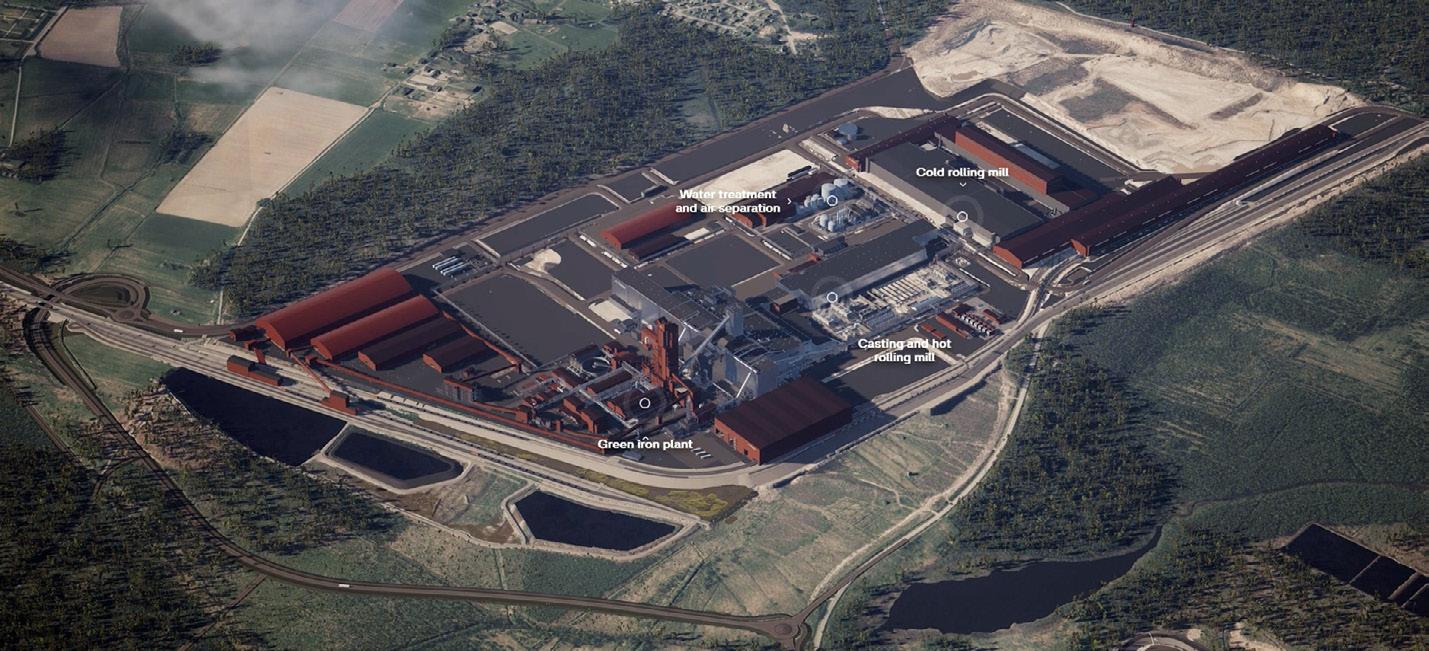
Stegra, whose green steel plant is under construction in the Swedish town of Boden, has entrusted the Finnish company with receiving & managing scrap in the Port of Umeå and with steel coil exports through the seaport in Skellefteå. “The Port of Skellefteå has for some time been working on an ambitious development plan that aligns well with an industrial investment such as Stegra. We value the customer-oriented and solution-driven commercial dialogue with the port in Skellefteå and the operator Rauanheimo, which has quickly led to this agreement securing the export of our steel products from Boden during the first years,” commented Jenny Marin, Head of Logistics at Stegra. Rauanheimo’s CEO, Tero Kosonen, also underscored, “We are very enthusiastic about the opportunity to expand our operations to Sweden. The agreement with Stegra is a historic milestone for us and an important step in our internationalization. We want to thank Stegra for the trust and the opportunity to be part of building the steel industry of the future. We look forward to collaborating with Stegra and the ports of Skellefteå and Umeå.” Stegra’s 270-hectare-big facility in Boden – said to be Europe’s first greenfield steel mill in 50 years – is expected to start production in 2026. “We will do things differently and produce green steel in a fully integrated production process, using end-to-end digitalization, electricity from renewable sources, and green hydrogen [from a 700-megawatt plant next to the mill]. By replacing coal with green hydrogen and electrifying the steelmaking process, we will be able to cut CO2 emissions by up to 95% compared to traditional steelmaking. Moving forward, we will continue to reduce emissions even more – getting closer and closer to zero – year by year,” reads Stegra’s website.
HES finalises its Gdynia grain investment
The Polish branch of HES International has commissioned three silos with a combined storage capacity of 21,000 tonnes, adding them to the May 2025-completed flat warehouse of 64,000 tonnes. The new facility, sitting on the Silesian Quay in the Port of Gdynia, offers 85,000 tonnes of automated grain intake and dispatch capacity, a fully integrated conveyor system connecting storage, handling and vessel loading operations, four separate compartments in the flat warehouse together with three vertical silos for simultaneous storage of different grain types, and truck and railcar loading/ discharge point stations with bottom-discharge technology. Capable of serving Panamax and Capesize vessels and offering now a total storage capacity of 240,000 tonnes, HES Gdynia’s throughput rose to 1.5 million tonnes of cereals per year.


Photo: HES Gdyni
Photo: Stegra
Stena Line takes over Terrabalt…
The Swedish ferry company will acquire all shares in the Liepāja-based port operator, becoming responsible for ro-ro, bulk, and other general cargo handling at Terrabalt’s terminal in the Latvian seaport. “Our investment in Liepāja means that we continue to be a long-term partner to Latvia and contribute to the further development of the country’s competitiveness and growth. We believe in a prosperous future for the Baltic Sea region, where investments in infrastructure and increased cooperation between the countries are key to strengthening trade and resilience throughout the region,” commented Niclas Mårtensson, CEO of Stena Line. The company’s COO Ports & Terminals and Head of Group Strategy, Carl-Johan Hellner, added, “Trade and supply chain resilience requires a long-term perspective, and in close partnership with the Latvian State, Liepāja Special Economic Zone, and not least our customers, we continue to build for the future.” The acquisition needs approval from the Latvian competition authority and other institutions. Until then, the current owners will continue running the business. Stena Line has been operating the Liepāja-Travemünde ferry service for a number of years, most recently with the sister ships Stena Flavia and Stena Livia (each offering room for 800 passengers and 2,255 lane metres for cargo). Since May 2023, the Swedish company has also been performing port operations in another Latvian seaport, Ventspils (from which it plies to and from Norvik in Sweden).
…signs a 50-year deal with Frederikshavn…
The Swedish ferry line and the Danish municipality have signed an agreement, thanks to which the former will operate the ferry part of the Port of Frederikshavn for the next half a century. “The new agreement expands Stena Line’s operating rights within the ferry port and establishes the company as the negotiating partner for other external customers requiring port services,” the shipping company said in a press release. Its COO Ports & Terminals and Head of Group Strategy, Carl-Johan Hellner, also highlighted, “Through an excellent dialogue with the Municipality and Port of Frederikshavn, we are continuing to build on our historically strong relationship to create a stable and prosperous future together. This long-term commitment enables us to establish infrastructure that supports sustainable trade, growth, and resilience.” Mayor Karsten Thomsen of Frederikshavn commented, “ I am delighted that we have reached a 50-year agreement with Stena Line. This creates security and long-term opportunities not only for the port but for the entire City of Frederikshavn. It sends a strong signal of trust and shared ambitions.” The Frederikshavn-Gothenburg crossing is served by Stena Line’s ferries Stena Danica (room for 2,274 passengers and 1,640 lane metres for cargo) and Stena Jutlandica (1,500 & 2,100), with three to four daily round trips.
…and wins Gdynia’s tender
The Swedish ferry line, present in the Polish seaport for 30 years now, has won a new contract that secures its operations at the Port of Gdynia’s Public Ferry Terminal in 2026-32. The deal will see Stena Line implementing several future-proof solutions, including 24/7 freight handling, automated drop & collect systems, and hybrid electrification of shipping. “The outcome of the tender secures the continuity of our strategic Gdynia-Karlskrona service, which is one of the most important ferry connections in the Baltic Sea. It also holds the status of a Motorway of the Sea within the EU transport network. This decision confirms the shared commitment of Stena Line and the Port of Gdynia to long-term development, investment stability, and sustainable shipping in our region,” Marek Kiersnowski, Trade Director for the Stena Line Gdynia-Karlskrona route, commented. The company’s CEO, Niclas Mårtensson, added, “Our uninterrupted presence at the Public Ferry Terminal in Gdynia means further developing its role as a modern, environmentally friendly, and integrated logistics hub. By continuing our cooperation with the Port of Gdynia, we reaffirm our long-term commitment to innovation, sustainability, and providing reliable services for both passengers and freight customers.” Stena Line has been calling to the new Public Ferry Terminal since June 2022. Over the past three decades, the company has served more than 12 million passengers and carried 2.5 million ro-ro cargo units between Gdynia and Karlskrona.
Lakeway Link upgrades its Gdynia-Södertälje ro-ro service
At the beginning of November 2025, Lakeway Express will be joined by her sister ship Mistral on the 22-hour route in question, enabling round-trip Monday-through-Friday departures. The 153-metre long Mistral, time-chartered from Godby Shipping, offers 1,624 lane metres for wheeled cargo, including high & heavy and project shipments. Godby Shipping shared that the charter will last until January 2026, after which “[…] Mistral will go to Remontowa shipyard in Poland for installation of new propeller blades, a new bulb, and some other routine dock jobs. The new blades and propeller are expected to give a fuel saving of at least 35% at speeds up to 13 knots.” Göran Söderdahl, CEO of Lakeway Link, also commented, “We are very pleased to meet our customers’ requests for daily sailings between Gdynia and Södertälje. The addition of Mistral strengthens our service offering and allows us to provide reliable, efficient ro-ro transport for both existing and new customers across the Baltic Sea.” He furthered, “This expansion represents an important step in our long-term strategy to develop sustainable short sea shipping. By increasing frequency and capacity, we can offer our customers greater flexibility while shifting more cargo from road to sea, reducing CO2 emissions and easing congestion on European highways.”
Albatros enters the Baltic
MSC has added Baltic Hub to the weekly service that links Northern Europe (Bremerhaven) with the US East Coast (Charleston & New York). The inaugural departure from the container terminal located in the Port of Gdańsk was made by MSC Berangere on 14 August 2025, a 366-metre-long and 51-m-wide carrier that offers room for 15,500 TEUs.


Photo: Baltic Hub
More runs on CLIP Intermodal’s Poland-Spain
rail link
Thanks to an extended co-op with Amazon, the company has increased the number of weekly round-trips on the Swarzędz-Barcelona Setemar Can Tunis route to four. According to CLIP, dispatching a trailer by rail over road between Swarzędz and Barcelona reduces CO2 emissions by up to 90%. The company also underlined that its rail connection is the first in Europe to serve Amazon’s intermodal units. “Expanding our cooperation with Amazon is an important moment for us as it shows that intermodality not only pays off but also genuinely supports our partners’ climate goals. We are thrilled to be building more responsible logistics together,” commented Marcin Uczciwek, Director of CLIP Group’s Sales Department.
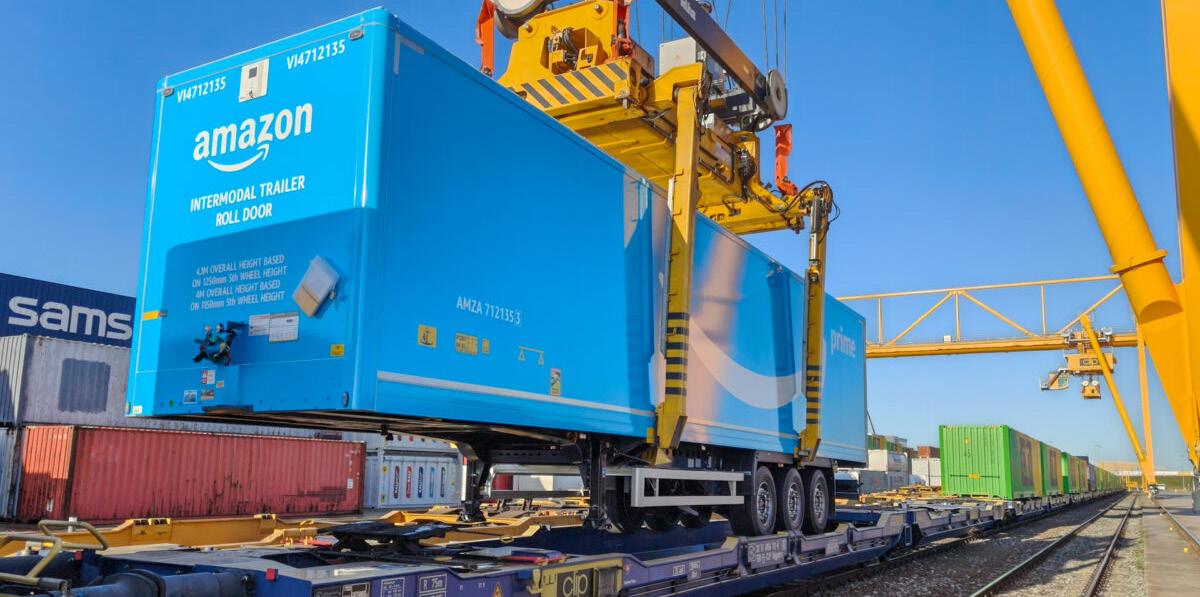
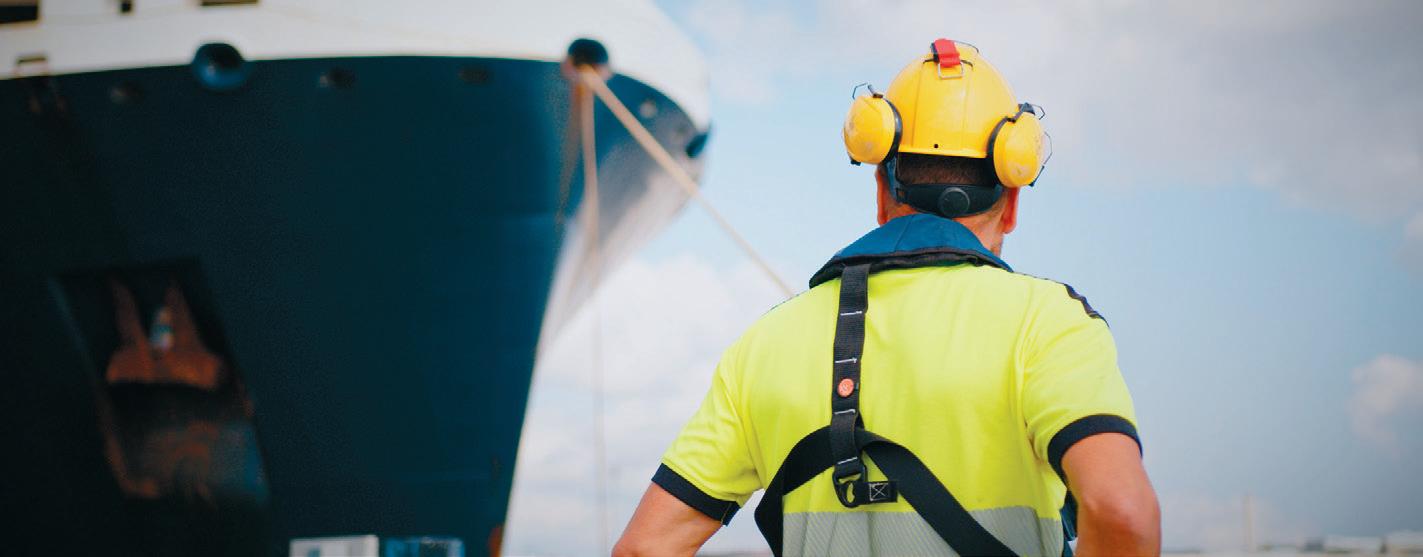
BECAUSE TIME MATTERS
Port of Turku offers fast and frequent connections to Scandinavia and Central Europe, with sufficient capacity and a diverse fleet for all kinds of sea transport.
Regular liner services provide a shortcut for freight traffic to European markets and, through ocean lines, to more distant countries. These ensure flexibility in transport schedules, offering competitive and cost-effective solutions for import and export transportation for trade and industry.
In addition to unitised cargo, the port has expertise in handling project cargo that requires special attention. The transit time for cargo is short, allowing vehicles bringing and picking up cargo to get back on the road quickly.
www.portofturku.fi

Photo: CLIP Group
VIKING LINE UPS ITS BIOLNG GAME…
• This autumn, the ferry company increased its purchases of the bio version of liquefied natural gas (bioLNG) sixfold, from around 600 tonnes last year to 3,800. The bunker, delivered by Gasum and made from food and agricultural waste, powered the Viking Glory and Viking Grace cruise ferries on the Stockholm-Turku crossing (with standard LNG used as a complement). For an additional fee, passengers, conference guests, and cargo customers were able to make their journeys fossil-free. Viking Line expects the LNG-tobioLNG switch to axe its greenhouse gas emissions by 17,000 tonnes. “We have worked with others to create the market for biogas. Supply has now increased to a level that enables the use of renewable fuel to a significant extent. We have now been able to agree on our purchases through to October, and our goal is to continue at the same level. Moreover, the amount of bioLNG used will increase thanks to the fossil-free maritime journeys that our customers purchase,” commented Dani Lindberg, Head of Sustainability at Viking Line. He furthered, “In the 2025 survey for Finnish maritime transport, carried out by EPSI Rating, 45% of respondents indicated that they will make more sustainable choices in the future when
they travel. These alternatives will become a reality only through longterm development work, bold investments, and good collaboration. For example, the increased use of biofuel and the resulting decrease in total emissions have been made possible thanks to the company’s €450-million investment in Viking Glory and Viking Grace.” Jan Hanses, Viking Line’s CEO, also noted, “We want to be among the pioneers when Finnish maritime transport shows the way to a fossil-free future for the rest of the world. Major investments in sustainable solutions require predictability in operations and good collaboration both throughout the maritime cluster and with public sector actors.” Jacob Granqvist, Vice President Maritime at Gasum, said, “By running on biogas, Viking Line contributes to emission reductions in Gasum’s pooling service for FuelEU Maritime compliance, which is used by vessels that cannot use biofuel themselves. Viking Line thus helps the entire maritime transport sector to reduce emissions. Starting on 1 January 2025, vessels must reduce their emissions by 2.0%, but required reductions will increase all the way to 80% by 2050. We therefore need trailblazers like Viking Line, which can pave the way for others.” •
…SO DOES FURETANK…
• The Swedish tanker company will be operating its EU-based fleet on biogas, having secured a large-scale mass-balanced biomethane agreement with Cargill and Titan Clean Fuels. “Accessing biogas in large volumes has long been a bottleneck for Furetank and other shipping companies that chose gas propulsion as the fastest route towards renewable fuels,” the shipping line from Donsö said in a press brief. It added, “With the FuelEU Maritime Regulation, in force since the start of this year, it is now possible to account for mass-balanced biogas –meaning certified biogas can be injected into one end of the European gas grid and withdrawn at the other, just as has long been done with green electricity. Furetank has now signed an agreement securing all the biogas required to operate all wholly and partly owned gaspropelled vessels trading in the EU during 2025. Most vessels have now been bunkered, and the transition is taking place.” Viktoria Höglund, Sustainability Strategist at Furetank, also underscored, “This was our target when we converted our first vessel to gas propulsion in 2015. It is remarkable that we have finally reached the point we have worked for and talked about for so long. At last, the right incentives are in place to make the business case possible. We have found partners who can deliver the volume and quality of gas we have been looking for, with a very significant CO2 reduction.” The purchased biomethane provides a 150-200% reduction in greenhouse gas emissions on a well-to-wake basis. Biomethane produced from feedstock such as manure, “[…] prevents the potent greenhouse gas methane from being released into the atmosphere during natural decomposition of waste, while also replacing fossil fuels in vessel operations. In addition, residues from the biogas process return carbon to the soil as organic fertiliser, avoiding
emissions from the production of synthetic fertilisers,” Furetank explained. “What makes this agreement stand out is its scale. Furetank has secured significant volumes, becoming one of the first movers in this market. The FuelEU legislation is set to drive meaningful change, and we are only seeing the beginning of LBM [liquefied biomethane] in shipping as one of the most accessible compliance solutions for shipping, requiring no engine modifications in LNG-fuelled vessels,” said Willem Olde Kalter, responsible for Biogas and FuelEU at Cargill, which will produce the biogas from waste. Lana Sissing, Client Manager at Titan Clean Fuels, which will liquefy and deliver the end product, added, “This is a perfect demonstration of all players in the supply chain working together to make a pioneering deal happen. The security of this product, with end-to-end transparency, as the gas is produced in Europe, means the entire production chain can be verified and certified. The demand for bioLNG is accelerating quickly and will only keep increasing.” A small share of Furetank’s vessel operations, about 10% of total fuel consumption, cannot be powered by biomethane. Part of this is the small amount of pilot fuel (traditionally marine gas oil, MGO) injected into the gas engine to initiate combustion. As such, Furetank’s trialled replacing MGO with HVO100 renewable diesel (supplied by ScanOcean). The last part of propulsion involves operating the energy-intensive cargo pumps, which can now be operated via shore power connection on all Furetank vessels concerned (provided that ports offer the possibility). “This means we have done everything currently possible to enter the fossil-free era. In this way, we demonstrate that the 2050 targets are within reach in the immediate future, through the incentives put into force,” Höglund summed up. •
…AND WALLENIUS SOL
• A s of October 2025, the ro-ros Baltic Enabler and Botnia Enabler run on the bio instead of the traditional version of liquefied natural gas (LNG). The supplied bioLNG is produced from Nordic residual streams (agriculture and food production), certified under RED III, and traceable via ISCC. The switch is part of Wallenius SOL’s Climate Roadmap, a pathway to operate entirely on renewable fuels by 2035, towards no harmful environmental impact a decade later. “The transition from LNG to bioLNG is an important milestone for Wallenius SOL. It shows that renewable fuels are not a distant solution but something we can use here and now. Switching to bioLNG for the Enablers is clear proof that our Roadmap is delivering, and that we are investing in our customers’ climate goals,” underscored Rebecca Tagaeus, Sustainability Officer at Wallenius SOL. Gasum supplies the
bio-bunker under a pooling arrangement. “By aggregating demand from several customers, the arrangement helps scale up supply and build stability in the market. For Wallenius SOL, it provides access to consistent volumes of bioLNG and ensures that the fuel can be introduced in regular operations,” the Swedish shipping line added in a press brief. Gasum’s Vice President Maritime, Jacob Granqvist, also commented, “We are very excited that Wallenius SOL has decided to join our FuelEU Maritime pool, as this collaboration enables us to open even more regulation surplus to shipowners. The window for securing compliance for 2025 is closing rapidly, and the available capacity may run out before the year’s end. Pooling is a brilliant and easy opportunity for all maritime actors to join forces in lowering emissions from the industry together.” •

ESTONIA & FINLAND KICK OFF DIGIMARIS
• The €2.9-million project, funded by the EU Interreg Central Baltic Programme, will see the development of smart surface vessels equipped with pollution detection sensors. These small units, designed to operate in the Gulf of Finland, will “[…] eventually be able to operate autonomously or support larger pollution response operations, improving monitoring capabilities and response speed,” the Estonian State Fleet said in a press brief. Its Director of the Development Service, Hannes Ojangu, detailed, “In the project’s first phase, existing pollution detection technologies will be mapped, and the most suitable solutions selected for the project. New equipment will be tested in a trial basin in Finland and then in Estonian waters to verify their performance in real conditions.” He furthered, “The project will also create a unified service concept and data processing platform that enables real-time
monitoring and effective cooperation between different parties.” Ojangu also underlined, “This is a significant step in cross-border environmental cooperation between Estonia and Finland and a contribution to strengthening pollution response capabilities across the Baltic Sea region. At the end of the project, guidelines and technical documentation will be produced to enable the developed solutions to be used elsewhere.” The partner team of DIGIMARIS includes the Kotka Maritime Research Centre (lead partner), the Estonian State Fleet, SouthEastern Finland University of Applied Sciences (Xamk), Kymenlaakso Rescue Services, and TalTech’s Estonian Maritime Academy. Additionally, the Estonian Navy and the Estonian Rescue Services Agency’s experts will guide pollution control. The September 2025-started project will last for 30 months, concluding in the spring of 2028. •
OMOQO GOES ONLINE IN LÜBECK
• In the start-up’s first commercial development partnership, its terminal operating system, designed for small and mid-sized terminals, has been implemented at Lehmann Group’s Cargo-Terminal Lehmann (CTL) in the Port of Lübeck. The cloud-based, modular platform (comprising Terminal Operating Modules, TOM) is used by CTL for digitalising core operational workflows in daily container activities.
“The implementation at CTL was completed within eight weeks.
The company reported that onboarding and training caused minimal disruption, and early results showed measurable improvements in data quality and process visibility. The stated objective is to gradually replace manual tasks and fragmented tools with TOM,”
omoqo underscored in a press release. Alexander Berg, CTL’s Head of Operations, commented, “We were looking for a solution that wouldn’t require a massive system overhaul but could still deliver real operational impact. With TOM, we’ve been able to improve transparency and reduce manual workload without disrupting our day-to-day business.” To this, Niko Kaufmann, Managing Director of omoqo, added, “With TOM, we aren’t offering a finished product. We’re building a new standard together with the industry. Cargo-Terminal Lehmann is our first commercial development partner. Alongside CTL, there are further co-creators helping us shape a solution that is intuitive, transparent, and ready to grow with their needs.” •


Photo: Lehmann Group
WHAT’S IN THE CABINET
Guidelines on Cooperation between Customs and Port Authorities – updated
The International Association of Ports and Harbors and the World Customs Organization (WCO) have released the updated version of the Guidelines in question, including input from the World Shipping Council (WSC). Launched in 2023, the set of guides serves as a practical tool to foster closer collaboration, better data sharing, and enhanced risk management between customs and port authorities. Key WSC recommendations include establishing robust consultation mechanisms with port stakeholders when introducing new data or regulatory frameworks, ensuring that business realities are considered. Shipping lines also emphasise the importance of timely, accurate data exchange – covering vessel, crew, and cargo information – in alignment with international standards (such as IMO FAL.14(46)). The new section also recommends and supports the adoption of single window environments to simplify and harmonise data submission, reducing duplication while enhancing security and compliance. The contribution also highlights the need for trusted public-private partnerships to tackle illicit trade, drawing on lessons from cross-border, multi-stakeholder global operations (like Operation TIN CAN that resulted in 43 arrests and 158 drug seizures of nearly 100 tonnes of narcotics in 2022). Finally, WSC calls for clear international practices to address abandoned and uncleared containers, which pose both safety and security risks. “This joint document reflects evolving priorities, including digitalization, coordinated risk management, and joint enforcement efforts. The guidance it contains reaffirms our commitment to strengthening collaboration at the border in an increasingly complex and data-driven trade environment,” commented Ian Saunders, WCO’s Secretary General.
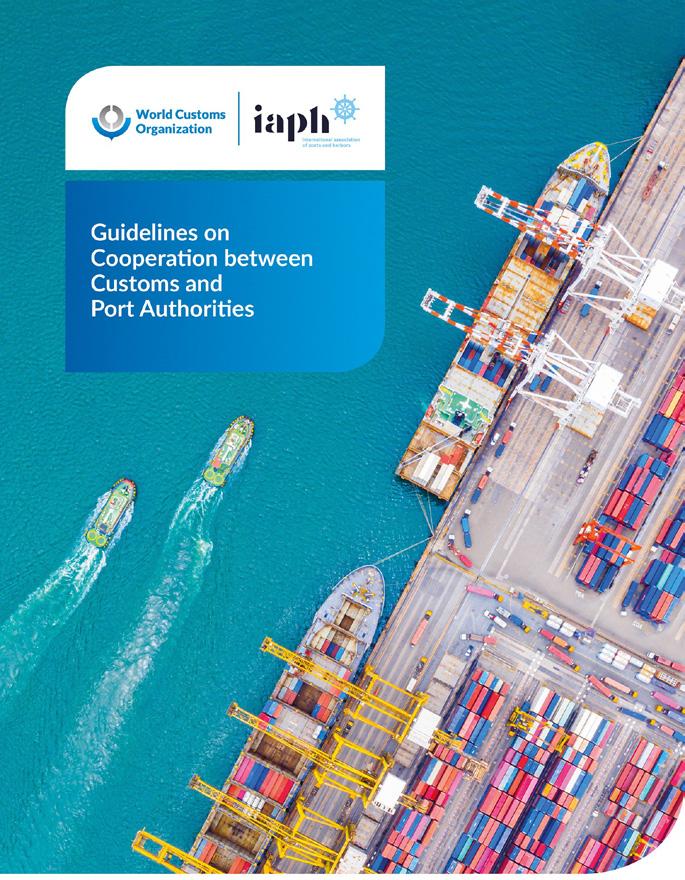
BPO on the next MFF
The European Commission’s proposal for the EU Multiannual Financial Framework (MFF) 2028-34 includes the European Competitiveness Fund (€409 billion; €451b with the Innovation Fund), among which also sits the Connecting Europe Facility in its third edition (€81.4b, of which €51.5b for transport and military mobility). “While CEF III is vastly ‘bigger’ than its predecessors, it does not automatically mean that maritime transport-related projects will finally enjoy increased success in being accepted for funding. Questions remain over whether port-related infrastructure projects are automatically classified as ‘cross-border,’ a matter requiring clarification. Furthermore, the European Maritime Space and TEN-T Ports have been listed as one entry in the ‘Indicative list of projects of common interest with cross-border dimension,’ the significance of which is as of now unclear and will also require further clarification,” the Baltic Ports Organization (BPO) said in a press brief. The Organization furthered, “Climate-related investments must be implemented without undermining the overall competitiveness of the EU maritime transport sector. Ports operate in a global environment where international competition is fierce, and the EU budget should ensure that environmental ambitions are pursued in parallel with measures safeguarding efficiency, affordability, and competitiveness.” BPO’s Secretary General, Bogdan Ołdakowski, also commented, “The strategic importance of ports as essential nodes of trade, energy transition, and security for the EU needs to be understood and considered at every step and reflected in access to sufficient financing support. The budgetary decision-making process should be as transparent as possible. We hope that the recently proposed EU Ports Strategy will be taken into consideration during the planning of the budget.”
IMO NZF – delayed
The much-awaited Extraordinary Session of the International Maritime Organization’s (IMO) Marine Environment Protection Committee (MEPC) in mid-October 2025 ended without adopting the Net Zero Framework (NZF) policy measures agreed upon in principle in April 2025 (essentially, the world’s first legally binding global carbon price for any sector and a fund for distributing revenues). A vote called by Saudi Arabia to adjourn the meeting for one year resulted in 57 countries accepting the motion, forming a majority of those present and voting, and the meeting was subsequently put off. “A number of countries changed their positions relative to that vote, providing evidence that well-publicised threats from the United States, including tariffs and reprisals for any country that supported the Framework, and related pressure, were effective at changing positions,” wrote the UCL Shipping and Oceans Research Group in a commentary. Its Professor of Energy and Transport, Dr Tristan Smith, commented, “This is catastrophic for confidence, and therefore also for the equitable and ambitious decarbonisation we need. We will now have to double down on other means to drive shipping GHG [greenhouse gas] reduction and energy transition. Climate science tells us that the challenge of decarbonisation does not go away; it gets harder. This delay, therefore, means those with the means must step up and lead more than ever, until this multilateral process can regain its composure.” UCL also stressed that the postponement does not override or change the foundation of the GHG Reduction Strategy that was adopted at MEPC 80 in 2023 (GHG emission reduction of 20-30% in 2030 and 70-80% in 2040 towards net-zero emissions by/around 2050). “As long as that is the stated strategy, the IMO should, in theory, make progress toward adopting regulations in line with it. However, the outcome at IMO means further work on regional and national regulation of international shipping has now been vindicated, making current regulations such as those in the EU likely to be prolonged. We could now see more regions taking similar action.” Work on the underpinning NZF guidelines can continue, UCL underlines, to specify definitions, calculations, and methods for determining how the policy incentivises and evaluates different technology and fuel options needed for decarbonisation, how the fund will be set up and run, and how its key parameters will be revised on an ongoing basis.

JOURNEY TOWARDS (AMMONIA & METHANOL) TECHNOLOGY TIPPING POINT IN SHIPPING

Key takeaways from Blue Supply Chain’s Umeå Roadmap
The hydrogen blueprint
by Ewa Kochańska
The Roadmap of Local Green Hydrogen-Based Fuels in the Umeå Region, report of the EU-backed Blue Supply Chains project, outlines an ambitious yet balanced strategy to decarbonise port and industrial activities. Led by the goal of achieving climate neutrality by 2040, the Roadmap details a framework for developing a localised electro-fuel production framework centred on green hydrogen. The proposed multifaceted approach – infrastructure readiness, fuel compatibility, environmental regulations, and financial responsibility – provides a flexible methodology that other port regions in the Baltic can, too, utilise.
The shipping industry is under pressure to reduce its heavy reliance on fossil fuels, which still account for almost all of its energy use –far behind other sectors in decarbonisation efforts. As global shipping is still responsible for nearly 3% of all greenhouse gas (GHG) emissions, this lag could seriously undermine international climate targets. Ports have a vital role to play in this shift – not just as logistics hubs but as key drivers of change by supporting the adoption of alternative fuels and green technologies across the maritime sector.
The Umeå region is particularly wellpositioned to become a northern European epicentre for green hydrogen-derived fuels. Substantial, dependable supplies of renewable electricity, particularly hydropower, dominate the area’s energy profile. In addition, Umeå has access to clean water for electrolysis, bio-based carbon dioxide suitable for synthetic fuel production, and a welldeveloped industrial base. Designated as the primary site for fuel production in the region is the Dåva Eco-Industrial Park. Equipped with district heating infrastructure and situated near robust rail & road networks, Dåva’s location makes it convenient for both domestic use and export opportunities. Umeå has already been taking an active
role in renewable energy projects (e-methanol), showing its consistent resolve to environmental sustainability.
Becoming climate neutral in six steps
The foundation of the Umeå Roadmap is a six-step methodology. First, define the objective and timeframe; second, map the present; third, assess the future; fourth, understand technological developments; fifth, explore pathways, actors, and measures; finally, plan for realisation, followup, and evaluation.
The process begins with picking strategic goals – such as that by 2040 Umeå aims to produce enough green electro-fuels for maritime and port activities to cut GHG emissions throughout the logistics chain. Next, the report takes a snapshot of the current situation, including strengths and weaknesses in Umeå’s energy, transport, and industrial infrastructure. For example, the Port of Umeå currently hosts over 800 ship calls annually and supports significant freight operations but lacks the refuelling and support systems necessary for hydrogen-based fuels. Still, the presence of industrial emitters producing biogenic CO2 and a stable energy grid form a solid foundation to continue with the next steps.
Central to the goal of Umeå being climate neutral before long are the future fuel supply and demand projections. The Roadmap estimates the Dåva site could support the production of up to 110,000 tonnes of e-methanol annually. This fuel, alongside hydrogen and ammonia, has emerged as a leading candidate for maritime decarbonisation due to its energy density and growing market availability. The transitional pathway described in the Roadmap illustrates milestones such as constructing hydrogen infrastructure, implementing carbon capture, and retrofitting port operations and vessels with fuel-flexible or zero-emission tech solutions.
Technology-wise, the Roadmap emphasises that there’s no single one-size-fits-all fuel or technology. Instead, a diverse mix – including hydrogen, methanol, ammonia, batteries, and wind-assisted propulsion – must be deployed concurrently. This is because of the complexity of the maritime sector, where different vessel types and travel routes demand different energy solutions. In terms of the economics of alternative fuels, the report offers detailed comparative cost analyses. At the moment, hydrogen, methanol, and ammonia are more expensive to produce and distribute

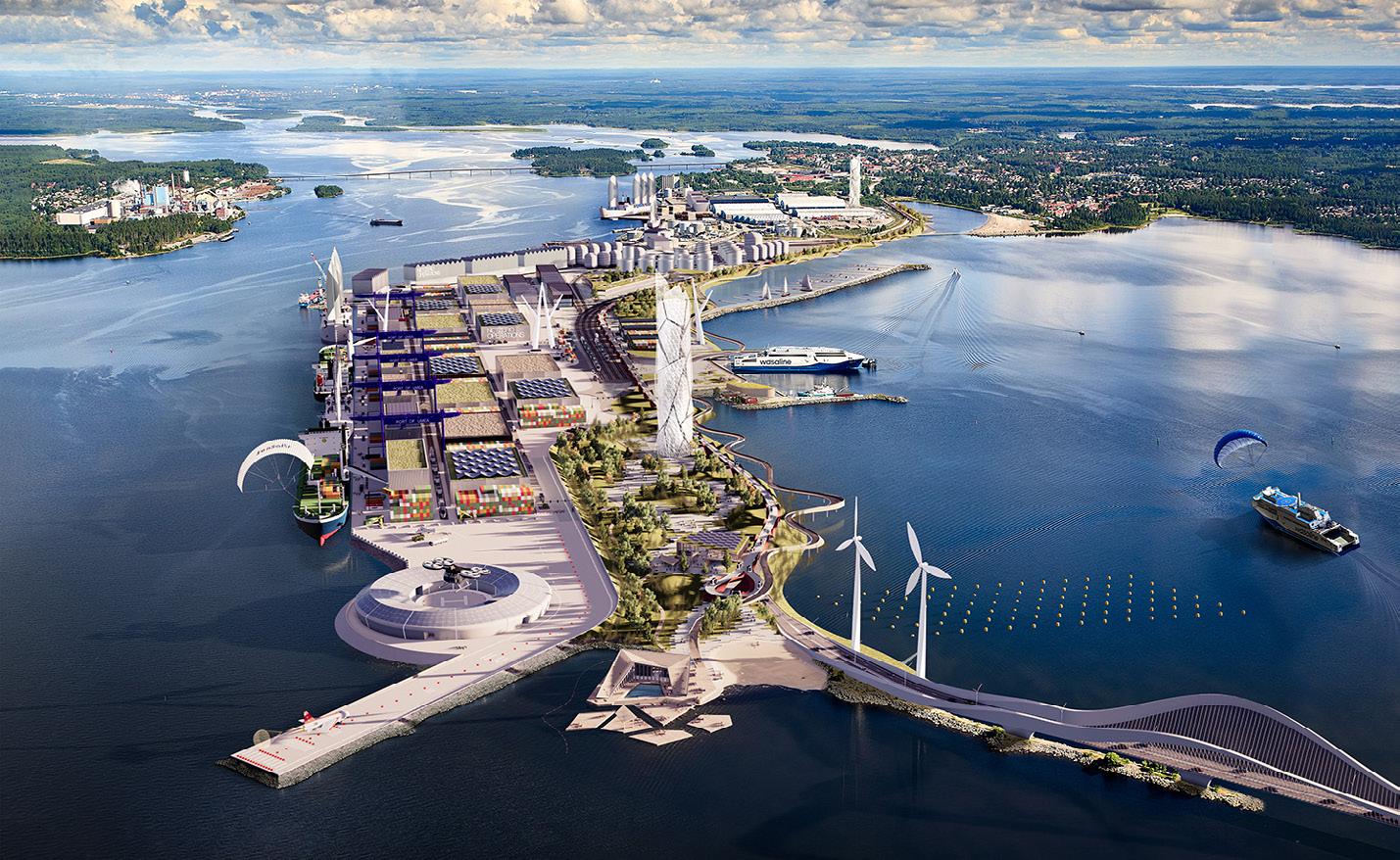
– largely because electrolysis requires heavy investment while supply chains are still developing. That said, falling costs in electrolyser technology, increasing system efficiencies, and the expanding carbon pricing regimes in the EU are projected to significantly close the gap by 2030-40. Green hydrogen costs, currently estimated at $4.0-9.0 per kg, are expected to decline to $1.0-3.0/kg through technological advancement and economies of scale.
Collaborative & cross-sectoral
The report also stresses the role of EU policies (FuelEU Maritime and the Alternative Fuels Infrastructure Regulation) that incentivise/mandate the use of renewable fuels in shipping and port operations. Sweden’s national policy is also moving towards aligning with the block’s climate targets, although not without some regulatory uncertainty – particularly around hydrogen storage, fuel classification, and CO2 capture and storage permits. The Roadmap identifies these gaps and calls for harmonised standards to facilitate market development.
The governance structure proposed in the Roadmap is collaborative and crosssectoral, bringing together municipal bodies, energy providers, port authorities, private companies, and logistics operators.
The Municipality of Umeå and the Port of Umeå are tasked with steering coordination efforts supported by commercial stakeholders, including Umeå Energy, Liquid Wind, and INAB. Implementation is tracked through a dedicated oversight system that includes performance indicators, pilot project evaluations, and adaptive strategy reviews. This governance model ensures that institutional momentum is maintained over the long timeframe required for full transition while allowing flexibility to incorporate new technologies or policy changes.
Blueprint for a green future
The Roadmap of Local Green HydrogenBased Fuels in the Umeå Region also outlines an integrated system that leverages existing infrastructure whilst preparing for new investment. The Dåva facility is envisioned as a production and distribution hub, using excess renewable electricity for electrolysis, captured biogenic CO2 from local industries, and thermal integration with the district heating grid to increase overall energy efficiency.
Green hydrogen is expected to serve both as a direct fuel and a feedstock for methanol synthesis, with planned port storage and bunkering facilities. Additional seaport upgrades – such as shore power systems, ammonia-compatible fuelling stations, and
rail-port connectors – will align with the broader digital and environmental modernisation of logistics systems.
Additionally, ‘trickle-down’ economic and regional benefits are forecasted. The development of green hydrogen and e-fuel capacity is expected to spur job creation, innovation, and regional competitiveness. Synergies with other future-oriented industries in northern Sweden – like battery production and green steel manufacturing – enhance the region’s appeal as a centre for sustainable industrial growth. The export potential of e-fuels, particularly as global shipping regulations tighten, positions Umeå as a strategic player in the international maritime decarbonisation sector.
The charted Roadmap represents a comprehensive blueprint for transforming Umeå into a model region for green hydrogen-based fuel production and utilisation. Through detailed analysis of economic, technical, policy, and governance dimensions, the report outlines a clear path towards a zero-emission maritime future. By capitalising on local strengths – renewable energy, industrial readiness, and political will – Umeå is set to lead Sweden and the wider Baltic region in implementing a sustainable and economically viable energy transition.

Photo: Belatchew
Key takeaways from Blue Supply Chain’s Lithuanian Roadmap
Rivers reimagined
by Ewa Kochańska
The Greening Lithuania’s Transport Chain report, by the EU-supported Blue Supply Chains project , reviewed the Baltic State’s ongoing project tasked with shifting road traffic onto inland waterways – along the Nemunas River. At the core of the initiative is the electrification of pushboats operating between Klaipėda and Kaunas, supported by a public tender that has attracted domestic and international stakeholders. The project not only advances the country’s environmental agenda but also establishes Lithuania as a test site for green transport solutions.
Lithuania’s road-to-river strategy is consistent with broader maritime aims in the EU. Because the shipping sector still relies almost entirely on fossil fuels for energy (and contributes nearly 3% of worldwide greenhouse gas emissions), (sea & river) ports that quickly develop low-carbon solutions and infrastructure can gain a lasting competitive advantage. Further, the EU’s Fit for 55 package, which extends carbon pricing to shipping and sets binding targets for alternative fuels, makes early action particularly valuable.
Taking advantage of Europe’s sustainability push, Lithuania is positioning its rivers at the centre of a modern logistics strategy. By utilising inland waterways, the state intends to reduce road congestion, lower emissions, and enhance sustainable transport.
The revival
What had begun under the Project EMMA developed into a flagship programme of the Lithuania Inland Waterways Authority (LIWA) to revive the Nemunas and the E41 waterway as viable commercial routes. Between 2019 and 2023, €27 million was invested to restore the latter (plus some €300,000 spent on light and GPS-equipped buoys). The first field test in 2021 showcased the potential of the project when a barge carried a 164.5-tonne General Electric transformer from Klaipėda to Kaunas. By 2022, over 200t of freight had been transported, showing that it is both practical and sustainable to move goods from highways to rivers.
Modernisation and infrastructure development around the Nemunas River have been necessary to ensure that this early success could continue. Over 550 groynes were built to regulate water flow and manage sedimentation and erosion. As part of the EU TEN-T upgrades, these improvements guaranteed the Nemunas is fit for commercial navigation. Moreover, E41 was upgraded to ensure year-round operation to transport at least 100,000t/year. In the second half of 2023, regular deliveries were underway on the Nemunas River, and from 2024, LIWA started bulk cargo transports (grain and rubble). Each barge trip replaces about 106 trucks, reducing CO2 emissions by 21t.
Powering the progress
The next phase of the programme focuses on innovation. In partnership with the European Investment Bank, LIWA completed a feasibility study for electrifying its fleet. The research looked at market demand, vessel needs, river conditions, port infrastructure, and alternative energy systems (including hydrogen, methanol-electric, and battery-electric options). The results show that battery-electric vessels are most viable at the moment. Supported by €14.6m in grants, the initiative includes ordering six pushers, 12 barges, and 27 battery containers to be introduced over six years. The transition to rivers enabled by these assets could replace around 49,000 truck journeys annually.
A resilient charging network is essential to provide enough power for this brand-new
tonnage. The initial grid connections provided only 350kW, insufficient for pushboats, so a dual-link system was introduced, raising capacity to 750kW per vessel. But more is needed, thus charging points are being set up at three key locations: Klaipėda (as the hub), Jurbarkas (mid-route charging and battery exchange stop), and at the Kaunas Marvelė Port (multi-purpose energy centre supporting both vessels and heavy-duty trucks). The last offers specific advantages, including direct access to a nearby high-capacity transformer. Under a long-term agreement, the Lithuanian government has pledged €500,000 to enhance the grid, while the port operator will cover 10% of the expenses and set the electricity rate at €3.0/kW.
Peeling the layers of complexity
Another key finding from the report is that while electrification is moving along swiftly in road transport, the same cannot be said about maritime, where charging infrastructure is scarce. Only a few European ports are able to provide a large-scale alternative energy supply. Establishing hubs like Klaipėda and Kaunas with long-term, stable grid connections is instrumental in enabling the maritime sector to decarbonise.
However, deploying high-power charging technology is still a tall order. The commercially available solutions at the required scale are insufficient. Thus, a phased method has been adopted in the Lithuania project to allow for infrastructure improvements as new systems become available.

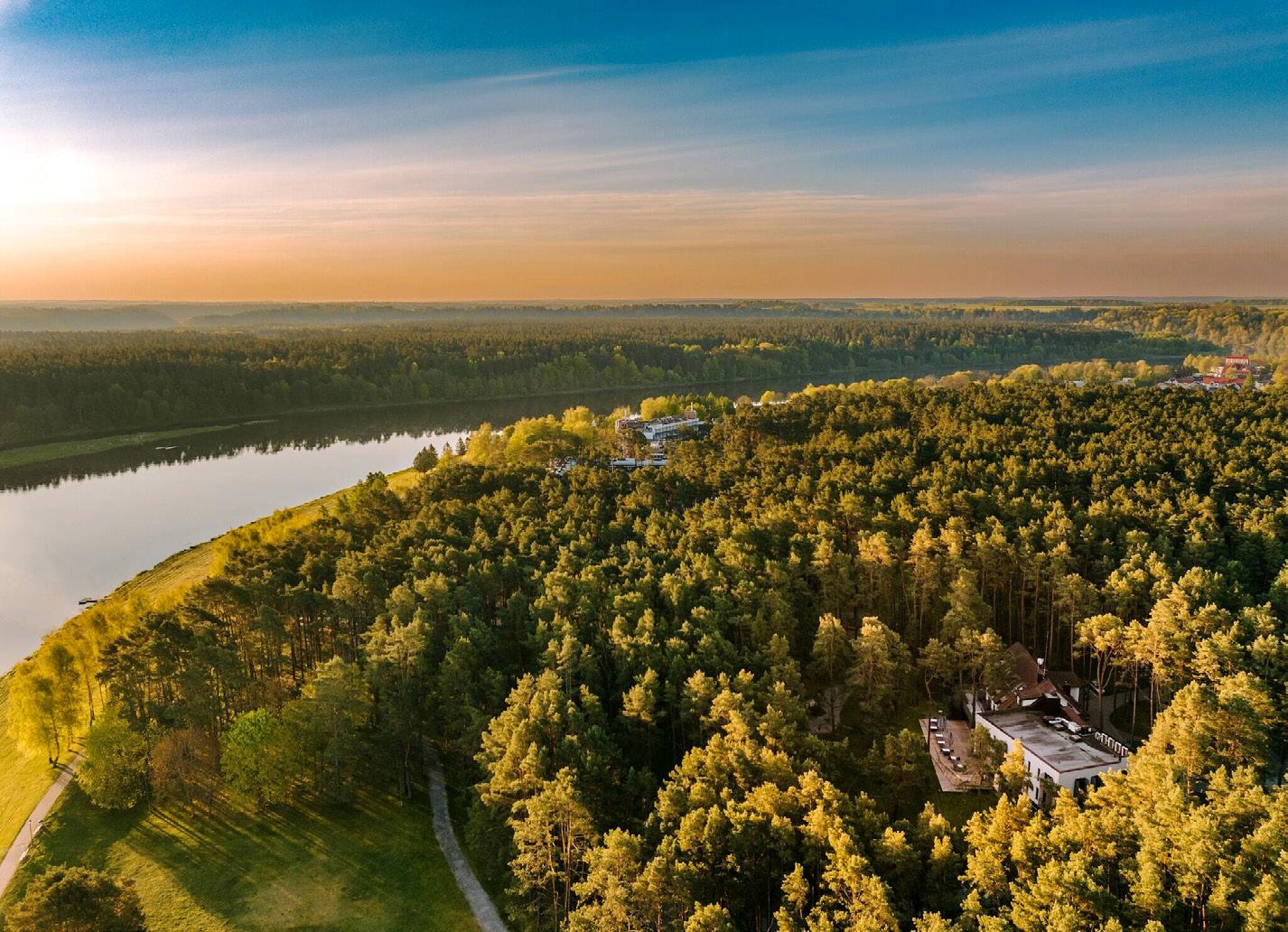
There are also constraints on energy supply within urban areas, e.g., at Marvelė, on-site renewable generation is restricted, so the port must rely on the national grid. Here, long-term planning and fixed-rate contracts with energy providers are critical to ensure a stable, cost-effective supply.
Battery logistics adds another layer of complexity. Each container weighs about 30t, which requires strong docks, special cranes, and improved storage areas to manage safe and efficient exchanges. A second charging point in the Port of Klaipėda is also being considered to meet growing demand, which involves talks with local operators and energy suppliers to get both power and space.
That said, to enhance operational flexibility even further, floating ‘battery barges’ are being considered as mobile power units to keep vessels running without interruption. Also, fixed-rate energy contracts will help control electricity costs, while close coordination between government, industry, and energy providers is helping develop the E41 into a scalable, zero-emission inland waterway system.
With infrastructure plans in place, the focus has shifted to vessel design. A blueprint for electric pushers has been completed, tailored to the Nemunas River and fit to work with high-capacity batteries. Trials with diesel-electric hybrids, methanol-electric systems, hydrogen fuel cells, and battery-electric vessels have already provided important data that shapes the final specifications.
The project is currently in the implementation stage, with standards of production, regulatory approvals, and procurement underway. A 2024 public tender invited international building companies and technology providers to deliver the pushboats to the needed performance and sustainability criteria. At the same time, the Kaunas Marvelė Port is expanding its capacity to 2.5MW, which will enable three battery containers to charge at 750kW each.
Charge up!
Clearly, the success of Lithuania’s inland waterway electrification depends on a robust charging network. With the dual-connection system, which delivers the necessary 750kW/ vessel, the network fits into the European
combined charging system standard but remains demand-scalable. Kaunas’s proximity to a high-capacity transformer reduces grid extension costs, while a public-private financing model ensures stable pricing. Yet, challenges remain – from the limited availability of ultra-high-power charging equipment to reliance on the national grid due to zoning restrictions, as well as the need for heavy-duty cranes and reinforced docks to handle 30t battery modules.
To overcome these obstacles, solutions such as battery barges and fixed-rate energy contracts have been under discussion. Meanwhile, improvements to the infrastructure at the Kaunas Marvelė Port and the public tender for e-pushboats highlight Lithuania’s capacity for extensive implementation. Thanks to robust collaboration among the government, the private sector, and the EU, the project is progressing despite market volatility and competition from road transport. The initiative’s benefits go beyond logistics, reinforcing environmental targets, supporting economic growth, and positioning Lithuania as a regional leader in sustainable (inland) shipping.

Photo: Lithuania Inland Waterways
Blue Supply Chains on the Rostock-Trelleborg shortcut to cleaner trade
Where sea meets rail
by Ewa Kochańska
Decarbonising freight transport across Europe requires not only cleaner and smarter technologies but also an innovative use of existing corridors. The reports Role of port authorities in the set-up of green transport chains , Set-up of Green Transport Chains Rail Ferry Case Rostock-Trelleborg, and Improved green transport chains through demonstrated cooperation between port authority and operator, from the Blue Supply Chains project, analysed the Rostock-Trelleborg rail ferry link as an example of how ports can support the creation of greener supply chains by combining sea and rail. This type of solution eases congestion on the roads and diversifies access between countries and cities. The analysis showed that the Rostock-Trelleborg service has long-term potential to support both climate targets and resilience strategies as long as investments in rail capacity, digitalisation, and alternative fuels keep pace with demand.
Besides new fuels and innovative digital tools, decarbonisation of freight transport across Europe also demands a rethinking of how existing corridors are utilised. The Rostock-Trelleborg rail ferry, the last train ferry connection between Germany and Sweden and a vital link in the ScandinavianMediterranean (ScanMed) TEN-T Core Corridor, serves as a perfect example of this. Once seen simply as a niche service, it is now being repositioned as a model for green logistics, with security and geopolitical implications, at the centre of Europe’s transport network.
From polluters to pioneers
Ports have long been the engines of trade, just as they have long been major polluters. As Europe accelerates its Green Deal ambitions, seaports are under pressure not only to cut
their own emissions but also to lead the energy transition, helping the entire transport sector decarbonise. The Rostock-Trelleborg partnership demonstrates how ports can assume this role: by modernising facilities, investing in alternative fuels infrastructure, and supporting sea-rail solutions that reduce truck traffic and diversify supply chains.
Trelleborg, Sweden’s busiest ro-ro port, is already consolidating intermodal operations to reduce internal driving distances, renewing equipment with electric tug masters and hydrogen shunting locomotives, and expanding shore power connections for ferries. Meanwhile, Rostock is building up its combined transport terminal with new storage, additional 680-metre tracks, and is testing e-tug masters to cut emissions from port operations.
Stena Line operates the rail ferry between the two. The company’s existing vessels, about
26-28 years old (expected to run for up to four decades), are being retrofitted with silicone hull coatings (one ferry so far), upgraded propellers, and AI-assisted navigation tools to reduce drag and optimise routes. Additionally, terminal time is being optimised to reduce fuel burn, and vessel machinery is being renewed to prepare for biofuels. Methanol conversion and hybrid propulsion are being explored, following Stena Line’s earlier introduction of the world’s first methanol-powered ferry. The strategy is twofold: extend the life of the current fleet while laying the foundation for fossil-free operations in the coming decades.
In terms of digitalisation, the KV4.0 Data Hub is a new machine-to-machine data exchange system, able to provide realtime visibility across intermodal terminals, allowing users to track shipments, optimise truck arrivals, and better allocate resources. This level of transparency

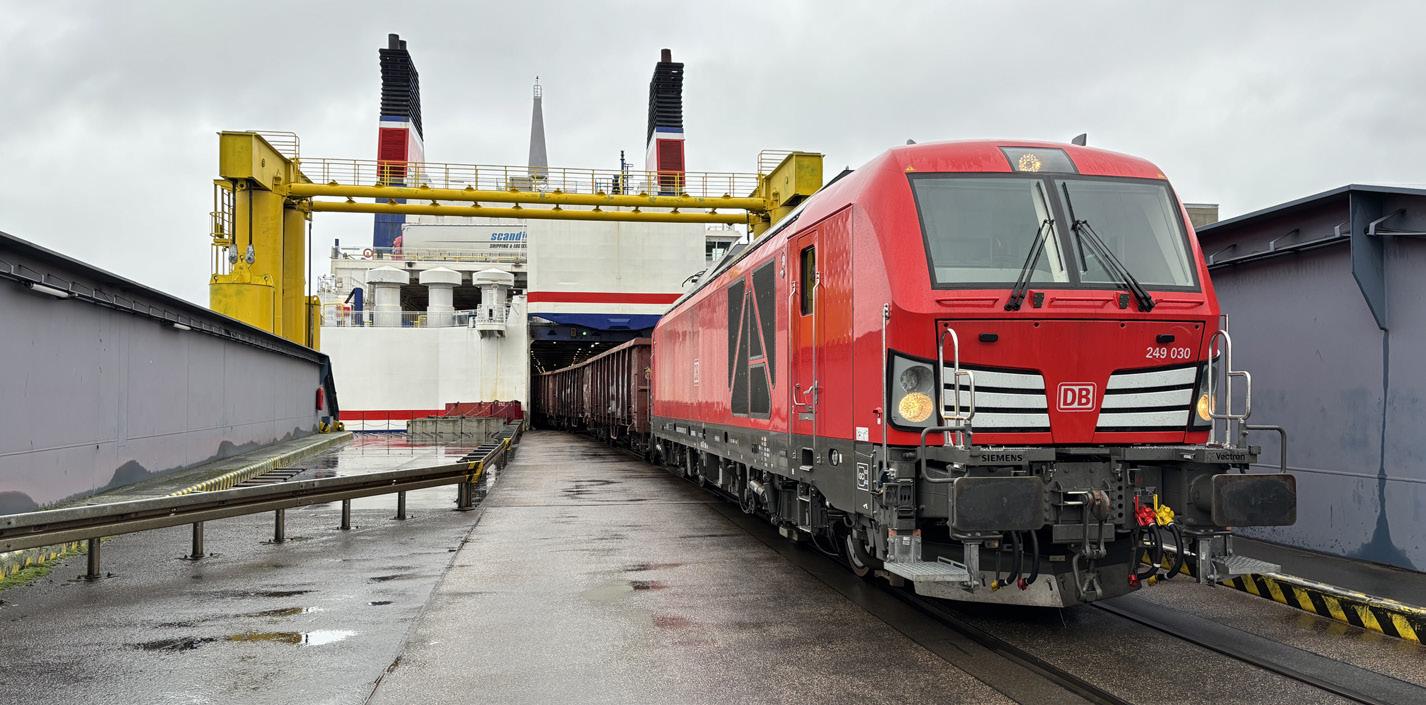
reduces congestion and makes combined transport more attractive, particularly for smaller operators who previously found intermodal logistics too complex.
The strategic shortcut
The Rostock-Trelleborg link also plays a strategic role in Europe’s economy and security. It provides an alternative to infrastructure such as the Öresund Bridge when congestion, pandemics, or political upheaval threaten supply chains. Past disruptions have shown how fragile a singlecorridor system can be, and policymakers in Germany and Sweden now emphasise a ‘two-corridor strategy’ as a security issue.
Geopolitical developments have only reinforced this point. The Russian aggression against Ukraine as well as Sweden and Finland’s NATO accession highlight the corridor’s importance for civil protection and military mobility. The ferries can carry entire trains, locomotives, and heavy equipment unsuited for roads due to axle load and clearance limits, and and is approved for the transport of dangerous and critical goods, underlining the link’s twofold role in trade and defence logistics.
Demand is expected to climb steadily for the connection. Northern Sweden’s industrial plans in areas of green steel, batteries, and raw materials will create new freight flows southwards; yet, inland rail remains congested. In the country’s south, the Skåne network is already stretched, and while upgrades, such as the Lund-Hässleholm double track, will certainly help, they will not meet
long-term demand. It has been forecasted that daily rail traffic through Trelleborg could double by 2045. Without investment in tracks and yards, road haulage could end up absorbing the additional volumes, undermining EU climate goals. Germany, meanwhile, offers a stronger base as Rostock’s facilities were originally built for far higher traffic. Technical barriers (e.g., incompatible wagon couplings) are being addressed through EU initiatives like digital automatic coupling, which will simplify cross-border operations and improve efficiency.
Risks and rewards
However, the corridor is not without its unique challenges. In Rostock, there is currently only one rail-enabled berth; an investment in a second one requires recognition of the ferry’s strategic importance at the federal level. While Sweden is already including the route in its longterm transport planning, Germany has yet to formally recognise its strategic role. Without this recognition, access to national funding is limited. At the EU level, inclusion in frameworks like the Connecting Europe Facility and the Military Mobility programme could secure resources and planning security, but only if Germany and Sweden coordinate. The vessels themselves also need a clear investment path for future replacements. Purchasing specialised, rail-capable ferries is costly and carries high risks for operators unless public policy helps lessen that financial burden.
Despite the challenges, for customers, the Rostock-Trelleborg service is already a reliable alternative. Six daily departures provide flexibility, and punctuality rates average 98% – something land routes rarely match. The six-hour crossing is shorter than the road trip through Denmark and is unaffected by traffic in southern Sweden. Therefore, booking the rail ferry gives shippers an ‘almost’ certainty that their cargo will move on time. Operationally, the service is efficient and safe. Entire trains roll on and off in a single move, avoiding the risks and delays of craning trailers individually. Ports in both Rostock and Trelleborg are equipped with large shunting yards, allowing wagons to be reordered and new train sets formed before departure. This reduces handling time, minimises the risk of cargo damage, and enhances planning security for operators.
Future decided now
The Blue Supply Chains project has highlighted that the key to the success of the Rostock-Trelleborg link lies in stakeholder engagement. Workshops, roadshows, and advocacy have helped with understanding that the ferry has the potential to be a key part of Europe’s transport network.
The Rostock-Trelleborg train ferry has already been proving itself, as it has reduced road congestion and emissions – likewise improved Europe’s resilience to disruptive events. But its future will be decided by choices made now. The political recognition of its strategic role must match investment in inland rail, port infrastructure, and vessel modernisation.

Photo: Stena Line
The 128-gigawatt tug
by Andrzej Urbaś, External Consultant, Actia Forum
In J.M.W. Turner’s painting, The Fighting Temeraire , a venerable warship, a symbol of a fading era, is being towed to its dismantling yard by a diminutive, yet powerful, steam-driven tugboat. One can view it as a parallel to the energy transition considered by some to be on the verge of sweeping the Baltic Sea. Can the tugboat of renewable development haul the entire region toward a significant shift in maritime logistics, port investment, and environmental stewardship?
To navigate this shift, industry stakeholders require clarity and context. The comprehensive analysis, Development of OWE in the Baltic Sea , published by Actia Forum, provides essential insights, charting the course of development across the region’s EU nations.
The report maps the disparity between current operational capacity and the staggering scale of planned projects, confirming the rather ambitious nature of the challenge faced by the EU Baltic Sea region – to achieve the estimated offshore wind energy (OWE) potential of about 93 gigawatts (if not more!).
The framework
The sheer volume of OWE development is guided by a high-level political consensus across Europe. The momentum is underpinned by strategic agreements, including the Marienborg Declaration (31 August 2022) and the Vilnius Declaration (10 April 2024). These political milestones led to the formalization of regional commitment under the Baltic Energy Market Interconnection Plan offshore grids (BEMIP).
In December 2024, the ministries of energy of the respective EU Member States reached non-binding agreements on updated goals for offshore renewable
energy deployment, establishing intermediate objectives through 2050. Under the BEMIP framework, the eight participating countries have established collective generation targets for the BEMIP priority corridor: 20.2GW in 2030, 41GW a decade later, and 57.7GW by mid-century. These collective targets establish a regional baseline, yet individual national ambitions often exceed these figures, underscoring the political drive for energy sovereignty and climate targets across the region.
Reality vs aspirations vs concrete work
The report highlights a crucial industrial reality: the vast majority of capacity remains purely aspirational. The total fully operational OWE capacity across all surveyed Baltic nations stands at a relatively modest 3,534MW, with Germany accounting for 1,800MW and Denmark for 1,500MW (compare this with Sweden’s installed OWE capacity, which sits at 161.7MW, while Finland’s – 44MW). Crucially, the other markets – Estonia, Latvia, Lithuania, and Poland – currently report zero fully operational OWE capacity, signifying the industrial challenge ahead in the eastern Baltic (though after many years of neglected promises, Poland is finally erecting its very first OWE farm, the 1.1GW Baltic Power, expected to come online in 2026).
In stark contrast to the existing operational base, the total OWE capacity currently planned across the eight nations reaches a monumental 128.7GW. This pipeline reveals where future investment, maritime logistics contracts, and port activity could concentrate. Sweden leads the under-development pipeline with 61.5GW, followed by Finland (28.5GW), Poland (18GW), and Estonia (15.5GW). This immense scale places immediate pressure on the maritime supply chain to deliver specialized vessels and components capable of supporting these deployment rates.
The report details how individual nations are translating the BEMIP goals into concrete, capital-intensive road maps, often driven by specific national policies and logistical planning. Poland’s Energy Policy until 2040 aims for 5.9GW by 2030 and expects 18GW in OWE by 2040, aligning closely with BEMIP targets. The total technical OWE potential is estimated at 33 GW. Apart from the above Baltic Power, Baltica 2, Bałtyk II, and Bałtyk III are in the pre-construction phase.
The Estonian government is highly ambitious, expecting 7.0GW installed by 2030 (based on the National Energy and Climate Plan) against a potential of 17GW. Estonia has faced the complex issue of overlapping OWE applications, which public superficies licence auctions have been

working to settle by mid-2025. The Saare project (1.4GW) is the most advanced one, having secured a construction permit and aiming for commissioning by 2030/31. The logistical backbone is already being built, with the marshaling terminal in the Port of Tallinn’s Paldiski South Harbour scheduled to launch in early 2026.
Lithuania expects 0.7GW installed by 2030, leveraging a potential that could reach 3.3GW. Its main project is Curonian Nord (0.7GW), and the commissioning of the marshaling terminal in the Port of Klaipėda is expected to take place next year.
Latvia intends to develop the cross-border ELWIND project (1.0GW by 2035) and estimates a total potential of 4.0GW (though the Latvian Wind Energy Association speaks of 15.5GW). It is also developing sea terminals in Liepāja (online in mid-2027) and researching one in Ventspils.
While the development pipeline boasts an impressive 128.7GW, the report cautions that many of these projects remain at the concept or early planning stage. This is particularly true for the massive pipelines reported by Sweden (61.5GW) and Finland (28.5GW), where the future of most
proposed OWE projects is highly uncertain, and overlapping areas exist.
The response to this uncertainty is robust regulatory action and infrastructure investment. Some nations are urgently revising their technical plans. For instance, Sweden’s Agency for Marine and Water Management proposed changes in January 2025 to increase the total OWE potential, though national security concerns have reportedly restricted new areas in the central Baltic Sea (others quote politically motivated opposition against wind energy, plus the need to rewrite the concession system so that Sweden can benefit financially from seabed infrastructure erected in its waters). Finland is revising its Maritime Spatial Plan 2030, with updates expected by 2027, and recently introduced a new, transparent auction system for OWE areas to replace the previous developer-led model.
The widespread, active construction of marshaling terminals across Poland, Lithuania, Latvia, and Estonia – countries currently lacking operational capacity –indicates a clear, strategic regional commitment to preparing the essential maritime
logistical foundation for future installation campaigns, mitigating the risk associated with these massive development pipelines.
The (new) industrial dawn?
Just as the smoke of the early industrial tugboat in Turner’s painting heralded the end of the age of sail, the synchronized development of OWE terminals and the regulatory push across the Baltic Sea may very well mark the industrial dawn of the wind era. This transition is defined by the contrast between immense potential and the practical challenges of converting conceptual projects into commissioned assets.
The successful navigation of consent, construction, and supply chain logistics will ultimately determine how much of this pipeline reaches full commission, validating the ambitious BEMIP goals. For those managing the supply chain, designing the vessels, or financing the projects, understanding the current state of affairs on the Baltic OWE scene is critical for strategic decision-making. The Development of OWE in the Baltic Sea report can be your tugboat, helping to navigate these uncertain waters.


From coffee to waste to burning logs
A hot new life
by Bahez Karim, Founder, Paahtu
The Baltic Sea is probably the heaviest coffee-drinking region in the world. Apart from trade, however, this demand also produces a lot of waste. Sure, it can be composted or turned into homemade skinbeauty peeling – but it can also be upcycled and gain a hot new life. Enter Kahviklapi, a firelog made from used coffee grounds, designed as a sustainable alternative to traditional wood-based logs. But why on earth are you reading this in a publication devoted to transport & logistics? All because Tallink & Silja Line’s Silja Serenade is already seeing its used coffee transformed into a sought-after resource!
Paahtu was ignited by the idea of creating value from waste, and we have been on this path for over a year. We believe we are becoming an important part of local circularity systems by challenging traditional waste practices and contributing to reduced deforestation and pollution. For example, a company that consumes 500 cups of coffee per day produces 3,120 kg of coffee ground waste yearly. That’s about 15 trees saved per year if, instead of disposing of it, this stream lands with us. Kahviklapi burns 45% hotter, lasts almost twice as long, and takes 40% less space than wood. The logs can be used in saunas, hot tubs (“palju” in Finnish), and fireplaces.
Concrete sustainability action
There is plenty of coffee waste to collect, and we have been pleasantly surprised by the eagerness of companies to have their coffee grounds collected by Paahtu. With a forward-thinking partner, Tallink & Silja Line, we collect around 300 liters of coffee grounds every week from Silja Serenade, which cruises between Helsinki and Stockholm. That sums up to 10 tonnes annually, or as the Estonian ferry company puts it, concrete action that has an impact and is an essential part of their sustainability work. From Paahtu’s perspective, even this seemingly small waste stream makes a significant difference in
our effort to offer sustainable alternatives to essential consumer goods. On top of that, suppliers benefit by saving on biowaste disposal fees and by receiving data on waste collected and trees saved.
Our cooperation with Tallink & Silja Line demonstrates how shipping companies can integrate circular economy solutions into their sustainability strategies. A cruise ship is essentially a floating town, generating significant waste streams but also presenting unique opportunities to close the loop. Coffee waste is just one of many materials that can be repurposed. By collecting and transforming it, we reduce disposal costs, contribute to sustainability, and showcase tangible results to passengers and stakeholders.
Other companies are noticing the opportunity, too. For example, Paahtu was approached by a US retailer operating near a busy harbour. Together, we see not only the potential of Kahviklapi in the over-thepond market, but also the possibility of local production near ports where coffee waste is abundant (and certainly the Baltic’s ~200 ports could lay the ground!).
Expectations – exceeded
At the same time, we have a long list of excited suppliers from hotels to office buildings and cruise ships, and we can’t wait to bring them on board. For now, we are focusing on larger suppliers, but in the
future, we plan to include smaller waste producers, such as cafés. Our logistics are fairly straightforward: Tallink & Silja Line collects its coffee grounds in buckets provided by Paahtu, and we collect and replace them once a week.
The excitement is not limited to suppliers: consumer and retailer interest has exceeded our expectations, counting 120+ pre-orders (and an additional 250 on the waiting list). Indeed, we have temporarily closed our online store because of overwhelming demand that exceeds our current production capacity. That’s also where we arrive at the missing part of our circular equation: we have enthusiastic suppliers, plenty of raw material, and eager customers, but we cannot produce enough logs to meet demand.
Currently, Paahtu’s production line is highly manual, but it still allows us to deliver our pre-orders. Right now, it takes us over five days to make 100 bags, which is enough to collect valuable feedback from our first customers (cleaner burning, less ash, and easy storage). However, our current retailers alone would require a minimum of 2,600 bags per month. In other words, everything is ready to begin sales and scaling, but to meet demand, we need an investor to help build a proper production line.
Like our logistics, the production process itself is quite simple: drying, mixing, and pressing. While industrial production often

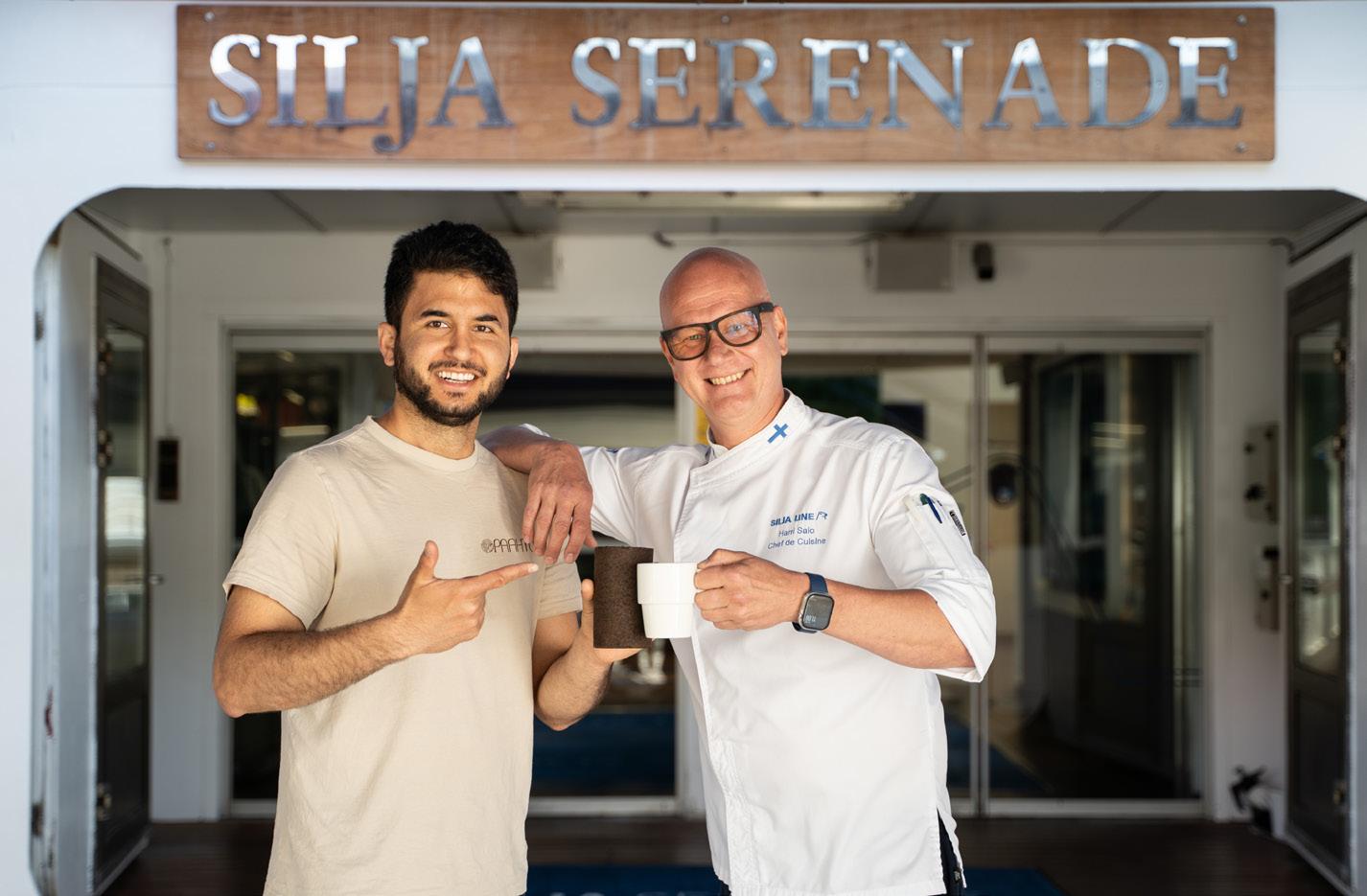


seems costly, with a €500k pre-seed investment, we can establish an efficient production line and expand logistics to serve both current and near-future demand.
We also know how to maximise our resources: Paahtu has grown from an idea into a lab-tested product with pre-orders and supplier contracts on just €20k in equity funding and €40k in soft funding. Now we are ready to scale.
As for our long-term vision, we aim to become experts in the waste-to-value business and a significant supplier of ecofriendly products. Our potential extends beyond Kahviklapi, and we have multiple products in our R&D pipeline, such as fire
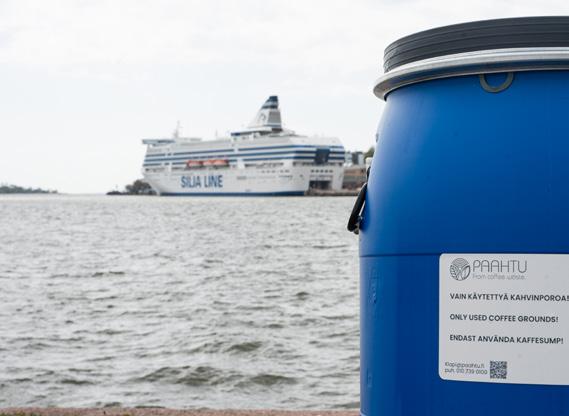
starters and logs with special features. In the future, we’ll expand into local waste streams (ports & shipping lines, can you hear that?) and other coffee-ground applications beyond heat generation.
Stay warm!
A circular dream is close to becoming reality. It is a win–win scenario for all

stakeholders – from investors to nature – but we need initial support to scale our operations. Our team works hard every day to make Paahtu a global phenomenon, and we welcome comments, thoughts, or collaboration ideas this article may inspire. Meanwhile, enjoy a warm cuppa coffee and follow our journey on social media!
Paahtu is a Finnish circular economy start-up transforming coffee waste into sustainable, bio-based products. Our flagship innovation, the Kahviklapi coffee log, is made from used coffee grounds and offers a cleaner, hotter, and longer-lasting burn than traditional firewood. Designed for saunas, hot tubs, and fireplaces, it provides a more sustainable and efficient alternative that reduces waste as well as helps prevent deforestation and pollution. Visit paahtu.fi to learn more (and support!).

Photos: Anita Lindberg/Paahtu
Critical limits
by Kristīne Carjova, Dr.sc.ing., Senior Researcher, TalTech Estonian Maritime Academy
It may seem ironic that in an era of nuclear power, autonomous electric vessels, and emerging hydrogen technologies, the shipping industry is once again looking to the wind. Yet, there is nothing surprising in this return to sails. The sea has a long memory, and shipowners have never forgotten the allure of free, inexhaustible energy.
Long ago, when steamships were rapidly displacing traditional sail, owners of large trading vessels resisted abandoning the wind entirely. Their response was the creation of windjammers – large steel-hulled sailing ships fitted with up to seven masts. Advances in metallurgy and machinery made them possible – steel hulls allowed greater size and lighter weight, while steam winches eased sail handling and cargo work. The result was vessels that could compete with steam on cost. Windjammers averaged 15 knots and sometimes exceeded 21, outpacing many cargo steamers of their era, which typically managed 14 knots.
Nowadays, instead of racing to ever-higher speeds, ship operators deliberately slow down. Slow steaming has become the industry norm, sacrificing time for fuel savings. Could today’s wind-assisted ships challenge that logic, helping vessels be both energy-efficient and fast?
The International Maritime Organization (IMO) is raising ambition for greenhouse gas reduction, and shipowners are exploring alternatives. Wind-assisted ship propulsion has re-entered the cluster in several forms — rotor sails, hard sails, suction wings, kites, and soft sails. What follows focuses on rotor sails, the option now seeing the broadest commercial deployment.
What matters (and why size not necessarily)
Rotor sails have now moved beyond the experimental status and are operating on a growing number of commercial ships. Over the past 15 years, at least 25 confirmed installations have taken place, ranging from ferries and ro-ros to tankers and bulk carriers. Performance figures vary from single-digit fuel savings to peaks of 25%; overall reductions are in the 4-15% range (with occasional higher values on routes with particularly favourable winds).
Our century’s rotor sail installations began with Enercon’s E-Ship 1, launched in 2010. It remained the company’s only vessel equipped with rotors, but nonetheless demonstrated reductions of around 25%. Maersk Tankers’ Pelican (later Timberwolf ) recorded 8.2% fuel savings on voyages between the Middle East and the Far East. Installation on the ro-ro SC Connector was reported to achieve fuel savings of up to 25%, while also showing advances in design by using tiltable rotors to pass under bridges.
Fuel savings from rotor sails do not scale linearly with installed thrust. Ships with more or bigger rotors do not automatically achieve proportionally higher efficiency, while vessels with one smallest rotor on windy routes can perform just as well. For example,
the very large ore carriers Sohar Max, 360 meters long and equipped with about 1,750 kN of rotor thrust, and the 340-m Sea Zhoushan with 875 kN of thrust, are both reported to achieve around 6-8% savings. Mid-size bulkers, such as Chinook Oldendorff (235-m, 525 kN) and TR Lady (229-m, 540 kN), reach 10-15%, while the Kamsarmax bulker Afros (200-m, 700 kN) reported 12.5% of savings. The ship’s overall length is therefore used as a practical comparison metric in the analysis we carried out at TalTech – since detailed loading conditions by voyage are rarely disclosed.
Widely cited studies, including those used by the European Maritime Safety Agency and the IMO, derive “typical” savings by grouping ships into broad bands of deadweight or displacement and applying average fuel consumption figures, while excluding some ship categories altogether. Such simplifications may serve reporting purposes, but to understand the true contribution of rotor sails, ship size, type, operational profile, and other technical parameters must all be considered.
Also, terminology matters. Across case reports, the same savings are expressed in very different ways: as percentages of fuel consumption, as reductions in energy demand, as tonnes of fuel or kilograms of CO2 avoided, or as the share of propulsion provided by rotors. Thus, the figures are not directly comparable. One project may report a 10% saving in fuel use, another a similar figure in emissions, and a third in terms of energy efficiency, but these are not interchangeable metrics. For shipowners, inconsistency creates uncertainty. Investment decisions require a clear understanding of what is being saved and how it is measured.
Wind economics
If performance outcomes are difficult to compare, the economic case is even less transparent. Published data on costs are scarce, and when disclosed, figures vary widely depending on vessel type, retrofit conditions, and contractual arrangements. Several manufacturers reportedly developed rotor sails over the past two decades, but only two players control today’s commercial market by actively delivering installations.
We constructed a simulation model drawing on verified performance data and a range of economic scenarios. The model was not intended to reproduce exact operating conditions for individual ships. Instead, it tested the investment case under varying assumptions of fuel price, CO2 cost, and financing. The analysis focuses on outputs

– how quickly rotor sails can pay back their cost under different regulatory and market environments. The results indicate that with current fuel prices and a CO2 allowance cost of around €85 per tonne under the EU Emissions Trading System (EU ETS), rotor sails can deliver a payback period of three to six years. In trades outside the EU ETS, the payback period can sometimes lengthen beyond a decade.
A Monte Carlo analysis confirmed the sensitivity of results to market conditions: fluctuations in fuel prices and carbon pricing dominate the outcome, while other assumptions, such as interest rates or installation, costs have a secondary effect.
Opportunities over constraints
The windjammers’ story did not end because their crews forgot how to sail. Constraints and logistics set critical limits then and now. The constraints are challenging – rotor efficiency declines in persistent headwinds, aerodynamic interference can reduce performance when multiple units are installed, and deck space or air-draft restrictions constrain applications on some ship types (particularly container vessels). Information on costs and long-term operational performance is still incomplete, and the economics remain highly sensitive to fuel prices and carbon regulation (although under the right conditions, rotor sails consistently deliver verifiable savings). While rotor sails will not make every vessel on every route faster, they can provide reductions in fuel consumption and emissions that are both immediate and measurable.

The Estonian Maritime Academy, a structural unit of the Tallinn University of Technology (TalTech), provides multi-level education and carries out professional research in marine sciences and fields related to them, making it the only competence centre of its kind in Estonia. Sail to taltech.ee/en/estonian-maritime-academy to discover more.

Tab. 1. Rotor sail installations across vessel types – in aplhabetical order
Clean hulls = clear gains
by Nick Cowley, President, Cathelco
Ask most shipowners what comes to mind when they hear “biofouling,” and the answers are predictable: drydock headaches, hull cleaning costs, and operational delays. What is less recognised is that the same issue also represents one of the most immediate levers for improving efficiency, cutting bunker consumption, and reducing emissions. A ship’s hull coated in marine growth can consume 20-85% more fuel than a clean one, making biofouling among the most significant contributors to unnecessary emissions. Unlike many decarbonisation measures, it is a problem with readily available solutions; yet, it is still widely regarded as routine upkeep rather than a climate strategy. It is high time to shift biofouling out of the margins of fleet management and into the mainstream of environmental strategy!
At the 83rd session of the International Maritime Organization’s (IMO) Marine Environment Protection Committee (MEPC) in April this year, the headlines understandably focused on progress towards reducing greenhouse gas emissions. But another decision of equal significance emerged: the IMO’s agreement to begin work on a legally binding international convention on the control and management of ship biofouling. This marks the first time biofouling has been formally recognised not only as an invasive-species issue but also as a material driver of fuel consumption and emissions.
Adoption will not begin until 2026, with a convention unlikely to be finalised before 2029 – and entering into force several years later. But the direction of travel is clear. For vessel owners, the question is whether to wait for enforcement – or to act now and capture operational and environmental benefits that are already within reach, without waiting for regulation to catch up.
Substantial and avoidable
The numbers speak for themselves: unmanaged hull fouling can increase fuel consumption by 20% with light slime, and by up to 85% with heavy calcareous fouling, according to DNV. By all means, this is not a marginal gain issue! Instead, it’s a substantial and avoidable driver of emissions, particularly when compared with the significant investments being made in clean technology solutions that often deliver only single-digit fuel savings.
Despite its clear impact, biofouling has long lacked regulatory urgency, falling behind EU and IMO decarbonisation measures. The result has been a widespread perception of biofouling as an operational nuisance or niche maintenance concern, rather than a climate solution.
Another key risk associated with unmanaged biofouling is the transfer of invasive species. Organisms carried on hulls can detach and establish themselves in nonnative ecosystems, with damaging effects on biodiversity. For example, invasive species are recognised by the International Union for Conservation of Nature as one of the main direct drivers of global biodiversity loss after habitat destruction, with shipping responsible for 55-70% of established coastal and estuarine invasive species globally.
Effective biofouling management therefore delivers a dual benefit: it directly reduces emissions and protects fragile marine environments. By preventing species transfer at the source, operators contribute to ecosystem resilience while also aligning with tightening sustainability expectations from regulators, investors, and charterers.
Some regions have led the way. Australia and New Zealand, for example, enforce strict biofouling rules to prevent the spread of invasive species, imposing heavy compliance obligations on vessels in their waters. In the semi-enclosed, ecologically sensitive Baltic Sea, biofouling management is supported by EU-backed initiatives such as the COMPLETE project, which has developed harmonised biofouling strategies, decision tools, and surveillance protocols tailored to the region’s conditions. HELCOM and OSPAR coordinate further policy alignment via their Joint Ballast & Biofouling Task Group.
These initiatives have proven effective –but they remain limited in scope. Without a consistent global framework, shipowners are left to navigate a fragmented patchwork of regional obligations, uneven enforcement, and inconsistent access to approved in-water cleaning facilities.
With less cost and disruption
Clean hulls are not simply a compliance issue – they are a performance strategy. Effective biofouling control reduces drag, improves fuel efficiency, lowers costs, extends drydock intervals, and enhances sustainability metrics. It also protects critical internal seawater systems, which are vulnerable to marine growth and can cause costly operational disruptions if left unmanaged.
The key point is that biofouling management delivers a return on investment today. Owners who act early gain immediate operational advantages while positioning themselves to meet future compliance demands with less cost and disruption. In an industry facing rising fuel expenses and tightening environmental scrutiny, biofouling management is not maintenance – it is an enabler of competitiveness.
Current approaches to biofouling management range from hull coatings to inwater cleaning and manual inspection. While these methods are widely used, they have notable limitations. Coatings degrade over time and can lose effectiveness in harsh operating environments. In-water cleaning is constrained by local regulations, the availability of facilities, and concerns over the release of removed organisms. Traditional approaches to protecting seawater pipework are often reactive, requiring intervention only after blockages occur.
This is why proactive, integrated systems are increasingly necessary. For example, Cathelco’s Marine Growth Prevention Systems and our patented Ultrasonic USP DragGone technology address biofouling at the source. The former protect seawater pipework and cooling systems, preventing blockages before they disrupt operations. The latter uses ultrasonic technology

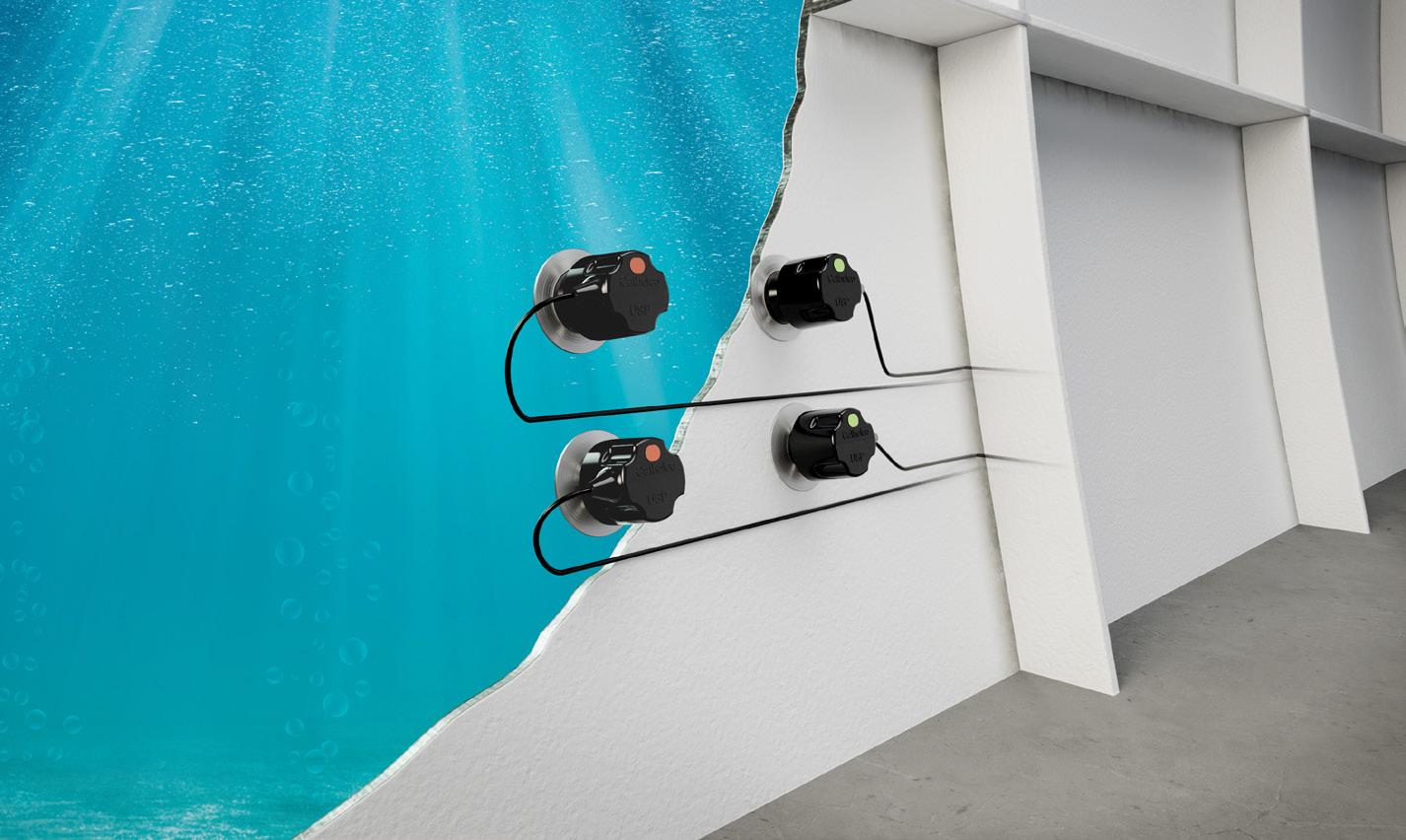
to prevent biofilm and hard fouling from attaching to hulls, improving hydrodynamic efficiency and achieving fuel savings of up to 13%. These technologies are designed to be cost-effective, low-maintenance, and compatible with vessel life cycles, enabling operators to achieve measurable gains above and below the waterline. By preventing growth rather than reacting to it, these solutions reduce reliance on disruptive cleaning cycles, extend coating performance, and minimise the risk of invasive species transfer – a critical advantage as scrutiny on marine biodiversity protection intensifies.
Clean & sharp teeth (of competitiveness)
The IMO’s existing biofouling guidelines have served as a useful starting point – but they remain voluntary and lack the enforcement teeth to drive consistent global action. The forthcoming convention offers a chance to establish clear expectations, define performance benchmarks, and underpin them with compliance measures that create a level playing field.
But regulation alone will not deliver the needed change. Incentive mechanisms –like recognising biofouling management in vessel efficiency ratings or offering port fee discounts for verified clean hulls – could accelerate adoption and reward proactive
owners. The objective should be a framework that recognises biofouling control as both an environmental responsibility and a business advantage.
The rollout of ballast water regulation offers a cautionary precedent. The IMO’s Ballast Water Management Convention took 13 years to enter into force (in 2017), delayed by a lack of industry clarity, limited availability of approved systems, and high compliance costs (particularly for operators in developing regions). Many owners deferred action, resulting in years of operational disruption, uncertainty, and uneven market conditions.
To avoid repeating that experience, regulators and industry stakeholders must start now – well before the convention is finalised – to ensure biofouling solutions are widely available, affordable, and supported by practical, evidence-based protocols. The IMO’s GloFouling Partnerships project (developed with the United Nations Development Programme and the Global Environment Facility to protect marine ecosystems from the negative effects of invasive

species) shows what can be achieved with clear objectives and shared commitment. Against fragmented efforts, a binding convention could provide the platform to scale these successes globally.
Finally, a successful biofouling strategy cannot be built in isolation. Collaboration between shipowners, ports, regulators, academia, and tech providers is essential to speed up innovation, improve data sharing, and establish best practices.
No excuse!
MEPC 83 has opened the door. The industry now has a narrow but critical window to step through – not in 2029, but today. For a sector facing mounting sustainability, regulatory, and commercial pressures, biofouling management offers one of the rare solutions that delivers immediate wins above and below the waterline.
The IMO’s convention will take years to reach enforcement – but that is no excuse for inaction! The technology already exists, the benefits are proven, and the commercial incentives are clear.
Part of the Evac Group, Cathelco safeguards your fleet by managing biofouling, ensuring corrosion protection, and generating freshwater. Our DragGone Ultrasonic Antifouling eco-friendly system utilises patented technology to prevent biofouling, while the Marine Growth Prevention Systems protect the engine cooling system pipework against blockages caused by barnacles and mussels. Head to evac.com/cathelco to learn more.

Photo: Cathelco
The (interwoven) propulsion crossroads
by Nitesh Ranvah, CEO, 21 Knots, and Amit Kumar, CTO, Zeroqu
When I started 21 Knots in 2014, the conversations I had in yards and boardrooms were mostly about ship design effectiveness and cost-efficiency. Those same conversations are now shaped as much by economics and energy markets as by hydrodynamics and engineering. Pathway flexibility – the ability to adapt as fuels and shore infrastructure evolve – while also complying with green regulations, will become critical for shipowner success. That changes the calculus! Choices made today could lock a vessel into decades of expensive retrofits and compliance penalties, or create resilience and value through lower emissions and higher marketability.
Shipowners want clear, prescriptive answers about compliance pathways. They ask us whether their current designs will meet FuelEU Maritime’s (FEUM) reporting and fuel uptake requirements and how the netzero targets of the International Maritime Organization (IMO) will translate into operational constraints.
Concerning the former, if you’re operating in EU waters, expect increasing fuel intensity standards and administrative reporting. You should focus on improving your ships’ energy efficiency, adopt alternative fuels where feasible, and secure green bunker contracts with guarantees of origin.
As for the latter, which sets a 2050 horizon, the imperative is to reduce life-cycle greenhouse gas (GHG) emissions intensity by investing in energy-efficiency technologies and selecting propulsion architectures that enable fuel transition – and reserve space and structural strength in newbuilds for future retrofits.
Owners are also concerned about timelines and capital allocation: when will green fuels be available at scale, and is it sensible to pay a premium now? For most trades, a staggered investment is optimal risk management: implement low-risk efficiency measures immediately, and when renewing your fleet, select propulsion systems that offer flexibility (e.g., dual-fuel or methanol-ready engines). This reduces the risk of stranded assets while keeping upgrade pathways open as fuel availability and price parity evolve.
Finally, owners-operators ask about resale value and charter market impact. My experience is that eco-vessels almost always command a premium. As we’ve recently started to see with the lower age profile of vessels in European waters, ships with fuel flexibility and lower emissions profiles are also likely to enjoy wider employment opportunities as green regulation limits the opportunities for unimproved, vintage tonnage.
Recommendations for today…
For existing fleets, pursue high-return retrofits first and avoid irreversible changes that would preclude future fuel conversions. For newbuilds, design with modularity in mind: reserve space, structural support, and piping corridors for alternative fuel tanks and fuel cell modules. Prioritise energy-efficiency measures such as optimised hull forms, waste-heat recovery, and shaft & propeller efficiency. Implement hybridisation and battery buffers where operational profiles suit them.
The propulsion choice for the next generation of ships is not a single technology decision but a portfolio strategy that harmonises regulatory compliance, commercial realities, and technical feasibility. Owners should pursue staged investments: immediate efficiency upgrades, selection of propulsion systems that deliver short-term gains and allow for future fuel transitions, and strategic retrofits that maximise return without foreclosing options. That balanced approach

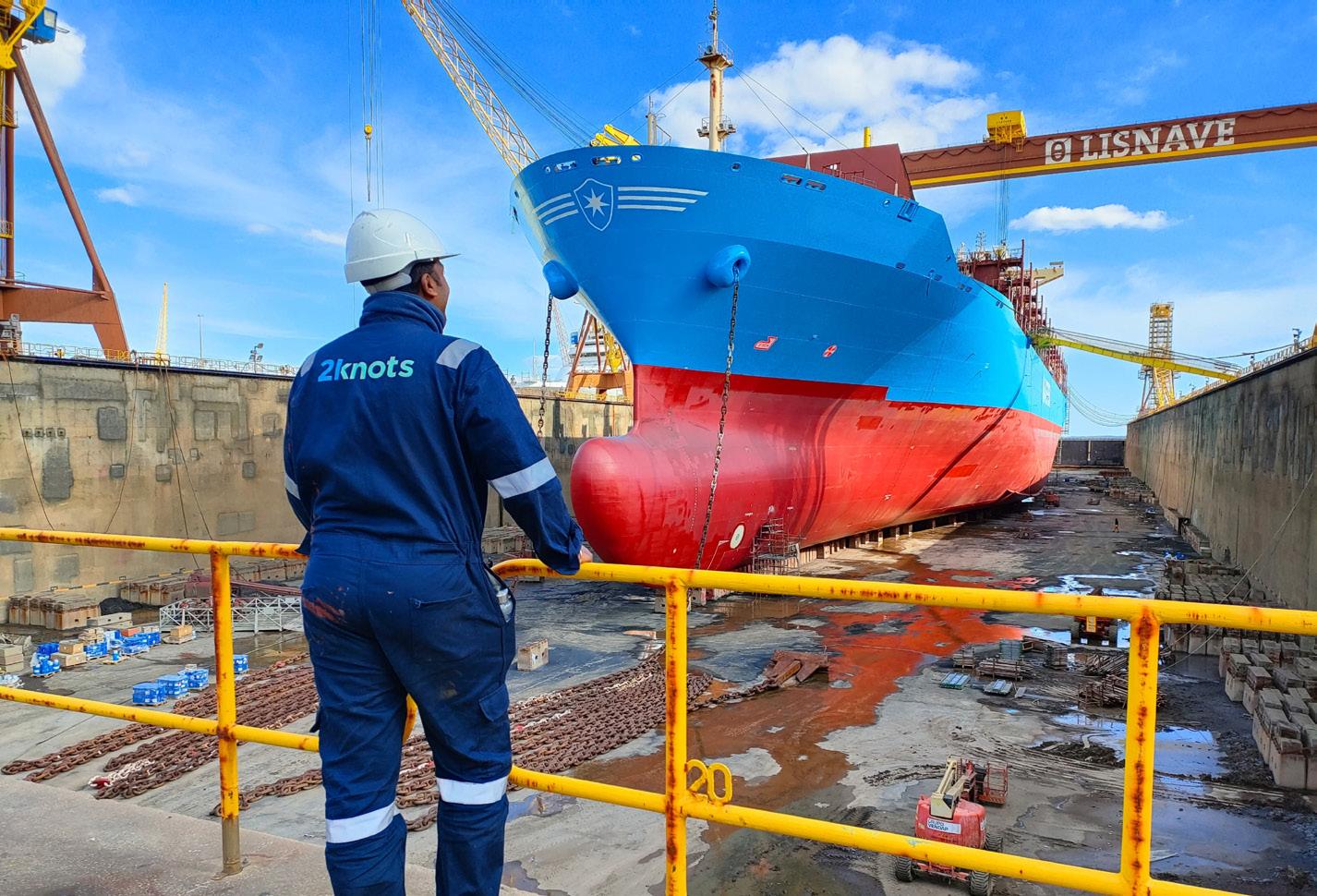
protects asset value, supports regulatory compliance, and provides owners with the flexibility to seize commercial advantages wherever they can find them.
…and for tomorrow
Many of Zeroqu’s clients are leaning towards dual-fuel engines capable of burning liquefied natural gas (LNG) as well as conventional marine gas or heavy fuel oil. For newbuilds, dual-fuel marine gas engines offer a pragmatic bridge: they reduce CO2 and almost eliminate SOX and particulate emissions when running on methane, and they can switch to conventional fuels when gas bunkering is unavailable. The capital expenditure is higher than for a simple diesel installation, and methane slip remains a concern for life-cycle GHG accounting, but it also provides operational flexibility. For trades with established LNG bunkering corridors, dual-fuel newbuilds are a defensible choice that meets near-term regulatory requirements while keeping retrofit options open for future low-carbon fuels.
Ammonia is attracting serious attention for its zero-carbon-at-point-of-use profile when produced from renewable electricity. However, the technology is still immature:
ammonia engines and fuel cells are under development, ammonia bunkering infrastructure is sparse, and there are safety and toxicity considerations that influence ship design and crewing. If your vessels will operate in European waters, this is a strong long-term option – though it’s unlikely to be a viable one soon.
Using truly green methanol is well rewarded under FEUM, and you are likely to be able to monetise any overcompliance you achieve here by selling your credits to other shipowners and operators. Moreover, refuelling logistics are comparable to traditional bunkers. The challenge is the limited availability and higher cost of genuinely renewable methanol. In trades where shore-side supply can be developed at a reasonable cost and you can guarantee its origins, methanol is a solid step towards lower carbon intensity.
Battery-electric and hybrid propulsion clearly suit short-sea services, ferries, and


offshore support vessels, where predictable routes and shore charging make them operationally practical. All-electric ships covered by FEUM also benefit from a zeroGHG intensity rating for on-board energy. For large ocean-going cargo ships, battery-only propulsion is not yet workable. However, hybrid systems – using batteries for peak shaving, hotel-load support, and transient manoeuvring – already deliver tangible fuel savings and emissions reductions, and those benefits will be recognised under FEUM.
Zeroqu’s practical advice, based on my 23+ years as Chief Engineer and former head of Maersk’s vessel performance team, is to run staged retrofit programmes that target the high-impact measures first, while planning to renew the fleet with fuel-flexible newbuilds. This blended approach balances near-term compliance and emissions reductions with long-term strategic positioning.
21 Knots is a design, engineering, and consulting firm providing cutting-edge, excellence-committed services to the global maritime and oil & gas industries, which are constantly changing due to dynamic regulations, economic fluctuations, and climate change mandates. Our daughter company, Zeroqu, is a modern platform for shipowners, operators, fleet managers, and charterers to manage emission compliance & energy performance.

Photo: 21 Knots
Turning the volume down
by Jukka Suvanto, Senior Sales Manager, Elomatic
For the maritime industry, environmental accountability represents one of the most important factors in shipowners’ and operators’ decision-making, the impact of which will resonate for decades to come. Beyond reducing greenhouse gas emissions, shipbuilders, owners, and operators are under increasing pressure to address the environmental impact of their operations, both above and below the waterline. One of the most significant yet under-regulated challenges is underwater radiated noise (URN): persistent, low-frequency noise caused primarily by propellers, engines, and on-board machinery. Studies suggest that 91% of Europe’s oceans are exposed to continuous noise from commercial shipping, making it one of the most widespread human-induced impacts on marine ecosystems.
For marine species, sound is a lifeline, particularly for mammals that rely on it for communication, navigation, hunting, and mating. The result of continuous low-frequency noise disrupts these vital behaviours, where prolonged exposure can trigger disorientation, stress, and even long-term population impacts.
Aside from a ship’s propellers and engines, URN is also generated by sonar, seismic surveys, and offshore construction activities such as piling and dredging.
Uneven
Despite growing awareness of the effects of URN, most of the global fleet continues to operate without significant mitigation measures. While the International Maritime Organization (IMO) updated its Guidelines for the Reduction of URN in 2023, they remain non-mandatory, leaving owners-operators with little incentive to take proactive steps to reduce URN emissions. However, the EU’s Marine Strategy Framework Directive sets regional limits, establishing that no more than 20% of a marine area can be exposed to continuous underwater noise.
Local incentive schemes also highlight what can be achieved in order to help mitigate URN. For instance, the Port of Vancouver rewards vessels that meet specific noise-reduction criteria through port fee reductions, worth up to CA$4,000 (€2,700) per call for large container ships. More recently, in June 2025, following the 3rd UN Ocean Conference, 35 countries launched the High Ambition Coalition for a Quiet Ocean, the first global political alliance dedicated to tackling URN. However, without binding international regulations, the pace of progress remains uneven.
Innovation by design
As regulatory provisions continue to develop, the industry has taken the initiative by developing effective ways to reduce URN within newbuild projects, as well as retrofits, through the use of smarter approaches to design. As part of this effort, Elomatic has partnered with Aalto University to develop a predictive simulation framework capable of estimating a vessel’s noise emissions during the design phase. By anticipating the acoustic impact before a single plate is cut, naval architects can optimise hull forms, propeller
geometry, and machinery placement to minimise cavitation and vibration.
Elomatic’s approach to advanced marine modelling integrates several highly advanced techniques to provide extremely accurate predictions of fluid dynamics, cavitation, and noise. For turbulence, we employ detached eddy simulation (DES), a hybrid computational fluid dynamics (CFD) model that combines the strengths of Reynoldsaveraged Navier-Stokes (RANS) equations and large eddy simulation. DES is particularly effective for simulating complex, turbulent flows around hulls and appendages because it resolves large-scale vortices while numerically modelling small-scale eddies, offering a balance between accuracy and computational efficiency that surpasses RANS-only approaches.
For cavitation, we use the SchnerrSauer model, a numerical method based on a simplified Rayleigh-Plesset equation. This model captures the dynamics of vapor bubbles and mass transfer rates, allowing precise calculation of vapor fractions within propellers, pumps, or other marine equipment. By simulating cavitation in detail, it enables engineers to predict potential performance losses and erosion


risks, leading to better-informed design and operational decisions.
To assess underwater noise, Elomatic applies the Williams-Hawkings (W-H) equation, a widely used tool in both aerospace and marine acoustics. The W-H approach calculates far-field noise, generated by moving or vibrating bodies, based on near-field pressure fluctuations. This makes it essential for analysing and mitigating noise emissions from propellers, rotors, and other machinery, ensuring compliance with regulatory requirements, as well as minimising environmental impact.
By combining DES for turbulence, the Schnerr-Sauer model for cavitation, and the W-H equation for acoustic emissions, Elomatic provides an integrated, highly accurate simulation framework. This allows ship designers and operators to improve the performance of their vessels, reduce the risk of cavitation damage, and proactively manage the advent of URN from the ship’s operations.
Together, these tools provide detailed insight into likely URN emissions, enabling data-driven decision-making that can inform more targeted vessel design,
alongside integrating energy-saving systems. CFD analysis can also be applied to existing vessels to assess where necessary changes can be incorporated to reduce noise emissions, which can then be integrated as part of a retrofit project.
Along with CFD, mitigating the impacts of URN can be achieved through clean technologies as well as improvements in operational efficiency. Energy efficiency measures (such as slow steaming, windassisted propulsion, and air lubrication systems) can reduce both fuel consumption and underwater noise. According to BIMCO, these measures could contribute up to 32% of the industry’s decarbonisation effort by 2050, while delivering 5-10dB reductions in URN.
Beyond hull and propeller design, Elomatic also models noise from mechanical

and piping systems, covering pumps, overboarding jets, propulsion train alignment, and pipe geometries. The goal is to reduce acoustic impact in ways that also support performance, fuel efficiency, and life cycle cost optimisation.
Longer delay = costlier compliance
The combination of regulation, voluntary frameworks, and incentive programmes is building momentum towards global standards. But the longer shipowners delay addressing URN, the more costly compliance will become. By embracing innovation at the design phase, ownersoperators can future-proof their fleets, access incentives, and safeguard marine ecosystems from one of shipping’s most widespread, yet at the same time, solvable environmental impacts.
Elomatic is an international consulting and engineering company that provides top-level expert services, products and turnkey solutions to process, machinery, marine, energy and pharmaceutical industries. We are focused on continuous improvement and sustainable development, and we are committed to design solutions that increase the wellbeing of people and the environment. Established in 1970, Elomatic employs 1,300 professionals, and has customers in more than 80 countries across the globe. Go to elomatic.com to discover more.

Photo: Canva
Interview with Kimmo Naski, CEO & Satamaneuvos | Port Counsellor, the Port
of HaminaKotka
The twists and turns of fate
by Przemysław Myszka
After nearly half a century in the seaport and shipping business, the longstanding chief exec of the Finnish Port of HaminaKotka, one of the country’s distinguished Port Counsellors, and chair of the Baltic Ports Organization – and truly a friend of our journal! – made his mind up to swap meetings for mornings (and other leisure pursuits of the legendary years). We are talking with Kimmo Naski about his feelings towards retirement, what led him to join the world of transport and logistics in the first place, and what lasting legacy he hopes to leave behind. We also put the spotlight on the lessons learned from the HaminaKotka merger, as well as the challenges facing the port sector and how to approach them.
Kimmo, how do you feel now that you’ve decided it is time to retire?
It is an emotional mix when I look back at those 46 years in transport and logistics. I’m crying with one eye while smizing with the other. That said, I’m overall happy because I’ll be leaving HaminaKotka in shipshape, so to speak. A lot of developmental effort has been put into making the two seaports commercially attractive – now and for years to come. According to my CEO agreement, I could have retired when I turned 63. This December, I’ll already be three years in the ‘overtime,’ meaning that I’ve had sufficient time to think it over. I have come to terms with the fact that the right time has arrived to pass the baton in this relay. It is time for others to show their mettle.
I know that several other port CEOs, especially in Sweden, have taken up consultancy jobs right after they put on their retirement shoes. I am very cautious about declaring whether I’ll do the same. These have truly been long days of work throughout many decades, so maybe I’ll commit myself, in the first place, to reading what’s in this unwinding chapter of life. As a case in point, I’ve got a few books waiting for me – classical ones, about nature, crime stories, etc. However, the very first thing on my to-do list will be a trip to Norway to discover the country’s nature via Hurtigruten. It has been my dream for at least two decades to go there in person and marvel at the fjords and icy sea (and also try
the best of Norwegian cuisine, as travelling equals tasting the place in my instance). More quality family time and sports (especially my favourite tennis and padel) will also surely keep me busy daily. Paradoxically, I’m afraid whether I’ll actually have time for all of this! Friends of my age who have already retired are extremely busy – to the point that it’s I, still working full-time, who has to keep track of our game calendar!
What motivated you to join the maritime and port sector, and how did your first roles shape your leadership style?
According to the family history from my father’s side, my ancestors were all pilots on the island of Hogland (formerly Finland, today’s Russia) starting from the year 1500 or so. My father was CEO of the Finnish Port Association for over two decades. Yet, I was never pressured to join the maritime sector (though I did summer docker gigs in my youth), instead being given the freedom to choose my path.
But fate twists and turns! Upon graduation, I found it difficult to find a fixed job (the employment market in Kotka/Finland was not exactly in its best shape back then). My mum showed me a newspaper ad for a language course in Germany, supported by the Finnish government. So I went to the south of the Baltic. The interesting side of learning German on the spot – and portending in my case! – was that you also had to go through
the practical part, which required an internship. My father reached out to his network in Lübeck (and note that there was no LinkedIn in the 1980s!). The port took me on board for two years, after which I landed a job with the German arm of Viking Line. What was meant to be just a complete-the-course time away from homeland turned into 12 years – and my entry into the world of transport and logistics. Then I was entrusted with running the Port of Pori for a few years, after which came Kotka for another decade, and then HaminaKotka up till now. I must have made a positive impact on the port industry as the Finnish president awarded me with the Satamaneuvos, Port Counsellor, title. I am old-school, a person who believes in patience and that wisdom comes with age (though I certainly wouldn’t have asserted this when I was young!). But it also comes through other people, networking, forging bonds that last years if not decades; through respecting different styles of working. The know-it-all genius is a myth – we simply learn from others, hence the virtues of openness and curiosity are of utmost importance. I sincerely hope that this attitude will be remembered (and cultivated!) in HaminaKotka as well as across the Finnish port sector and the wider Baltic community as the style of leadership I did my best to embody. Also, I think the academic part of my life – a doctorate in economics from the University of Rostock on the ownership and organisational structures of Baltic Sea ports

– has helped me a lot in my career. It was extremely helpful while preparing for the merger of Kotka and Hamina as I could transfer my theoretical knowledge into practice. Science can open one’s eyes in a way that feels nothing short of magic!
You have been directing the Port of HaminaKotka since 2011, having earlier managed the seaport in Kotka for a decade. How do you assess the merger from the perspective of the years?
There had been talks about different cooperation possibilities between the two. These went on for four decades and always stumbled over this or that problem. At the same time, the ports saw investments that targeted the same cargo traffic flows, meaning that in a space of about 20 kilometres, money was spent twice on what was essentially one-and-the-same development. Finally, the 2008 crisis happened, striking Finland and its port sector hard. Hamina and Kotka both “solidarily” lost one-third of their freight turnover the year after. That mishap really opened the merger-opportunity window. We were also very fortunate that the political landscape back then was receptive to the idea and ready to shoulder the responsibility.
Two years of hard work later, involving studies and customer feedback, the sign-off moment came. Now, we didn’t know until the very last hour whether the merger would get the green light. The town of Kotka and its council were all in from the very start,

whereas Hamina had mixed feelings. It is perhaps a universal sentiment shared by all places with a port, as the Baltic is far and wide – it’s ‘their’ port above all else. So, it was probably natural to fear that one might lose something. Fast forward to 2025, and nobody would like to go back to the pre-merger times, certainly not the stevedores, shipping lines, forwarders, and other transport & logistics actors; not even the politicians who were against the deal in the past! HaminaKotka is one nowadays, a testimony of the synergistic benefits of working together towards a common goal of port competitiveness.
You have been involved in shaping the seaport industry since 1998, when you joined the Port of Pori. Can you name a few new but also recurring trends that will have the most lasting impact on it –both from within and without?
A seaport can be prepared for the future – but only so far. This business is not only a puzzle but also one with moving pieces. Today’s operating environment is challenging, to say the least. Geopolitics is confusing (just to mention the flurry of tariffs) and violent (the war next door, of course, but also
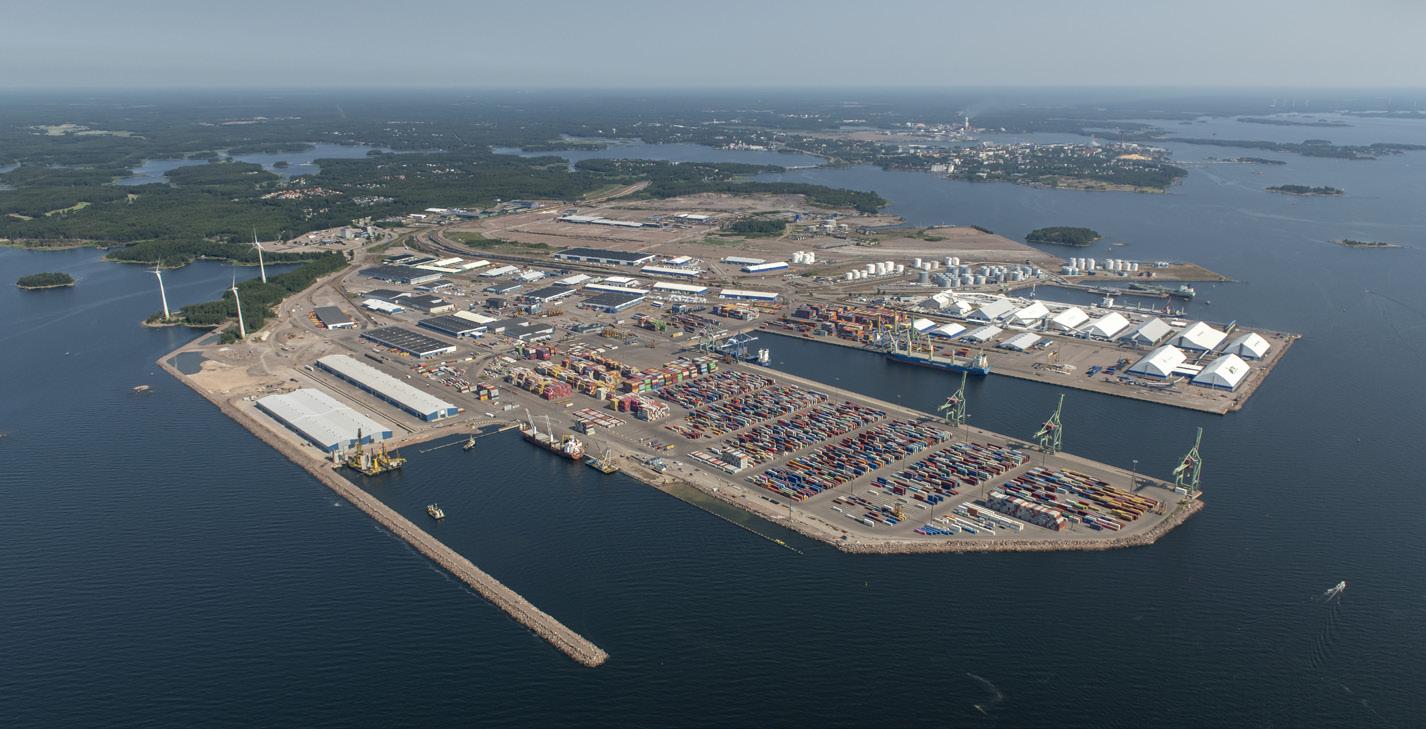

Photos: Port of HaminaKotka

the Houthis attacking merchant vessels and essentially re-routing much of international trade via the Cape of Good Hope; any delay translates into a lack of empty containers for exporters in Finland). Not so long ago, we had to grapple with a global pandemic that reshaped transport and logistics. Besides that, things like economics per se are still there, with the Finnish economy being like a windless sea for many, many years. All that and the country’s spécialités de la maison: docker strikes… Now, that’s something I surely won’t miss! That Finland is an island trade-wise has the side-effect of port closures having an avalanche impact on the entire economy and society at large. Seaports were always easy pickings as a pressure point to leverage certain agendas – even if the desired change wasn’t of a docker trade union’s (like last year when they undertook industrial action for five weeks in support of another group). The problem with port strikes is that we, as port authorities, aren’t a side in the conflict; our employees aren’t the ones on the quayside. But the public eye always falls on the port authority! And here you are in front of a reporter’s camera explaining you’re the victim in the whole mess (and it’s not necessarily conducive, to anything at all, truth be told, to blame the victim…). The 2024 strike failed to achieve its objectives, and there’s a robust political will to curb (excessive) job action. Regardless of that, one remains positive that circumstances will change for the better, though no one knows when. We believe that, for example, Ukraine will see peace one day, resulting in a lot of reconstruction work. This will propel transport and logistics, also through ports, and we need to be ready to accommodate that. To do so, seaports must keep pace with the development of their
customers – the growing vessels, the digitalisation of on- and offshore operations, or the tug-of-war between globalisation and de-globalisation (whether because of protectionist measures or near/friend-shoring ambitions). Other growth avenues are also there. Should you ask ports around the Baltic, one common answer would be: future fuels. There is a lot of investigation into producing ammonia, hydrogen, or methanol in our region. Made-in-Europe/Baltic/Finland batteries are also high on the agenda – and there’s already an investment decision on that in our area. Meanwhile, we’re making hay while the ‘digital’ sun shines. From scrutinising the conceptual use of artificial intelligence (AI), automation, and robotisation in operations, we’ve moved into checking them in practice. While AI is still more of an office thing, automating gate movements or employing autonomous vehicles is becoming daily bread. Data connectivity is key for such solutions, so we’re also seeing the rollout of the 5G network. Technology has also made it possible to improve safety and security.
I wish the EU would take on more of a supportive role in establishing future-fit (port) infrastructure (and the same goes for the government here in Finland). We have received some backing, but most of our development came from within. Sure enough, the EU provides the legal framework; yet, because it’s such a big, oversweeping organisation, the imposed rules sometimes lack granularity. For example, demanding that seaports offer onshore power irrespective of local conditions may be missing the point. Yes, it targets shipping emissions – but what will a port do if shipowners-operators won’t draw electricity from the shore – either because
they don’t have the equipment on board (which is expensive), deem the energy price too high, or just burn green fuel while berthed? A port will be stuck with an “investment” counted in millions of euros (multiplied by the size of one’s container and ferry/ro-ro traffic, even more painful if one of them is a small addition to your operations), plus a yearly bill for being connected to the grid without drawing a single kilowatt hour. The “attractiveness” of investing in cold ironing was further exaggerated by the lack of standards – and there was at least one standardised station in the Baltic that was offline because of ship-shore connector issues. It is not all rosy in the shipping garden, too, with the industry being nudged to pay for electricity or alternative fuels, both with a higher price tag than fossil bunkers. Then again, there are ship companies and ports that have made riding the green wave their business model, with the very first Green Shipping Corridor officially up and running here in the Baltic and its ferry line capitalising on strict EU laws. Again, look for positives! When I visited Ningbo-Zhoushan, the world’s largest seaport, which on its own handles more (between 1.3 and 1.4 billion tonnes) than what the entire Baltic Sea region takes care of yearly. So, while HaminaKotka is big Finland-wise, what could I tell the Chinese sitting with them on the 51st floor of their office, knowing that our freight traffic is but a drop in theirs? I did the calculations and realised that my port handles more cargo per capita than theirs! Seaports make a difference, and it’s the role of the people who run them to pronounce it – whether their port is small or medium or big (or gargantuan).

The new Port Reform Toolkit helps build resilience in uncertain times
A new chapter
by Ewa Kochańska
The Port Reform Toolkit , from the World Bank Group, has been the maritime sector’s reference point since 2001, helping governments, port authorities, and operators modernise and navigate change. Now in its third edition, the Toolkit offers a structured approach to port reform, with practical guidance on governance, regulation, financing, and institutional design. It gives decision-makers a clear road map for reform, ensuring ports remain resilient, competitive, and able to continue driving economic growth. The current issue includes new material on digital transformation, cyber security, environmental & social governance, labour transitions, and the critical role of ports within their communities.
The 2025 Toolkit’s key value lies in providing a consistent framework at a time when ports are under unprecedented ecological, societal, and geopolitical pressures. Global disruptions such as the coronavirus pandemic and armed conflicts have revealed how fragile supply chains can be, while environmental regulation, decarbonisation, and rapid technological change are forcing ports to adapt.
Slowbalisation
& friendshoring
Globalisation has long been a driving force behind the growth of maritime trade. After WWII, and especially during the hyperglobalisation era of the 1990s and early 2000s, growing trade and value chains increased demand for sea transport, with ports acting as gateways. However, recently this trend slowed down, opening a period called slowbalisation with weaker global GDP growth, a decoupling between trade and output, and a gradual shift away from the deep international specialisation in supply chains.
While early globalisation bolstered the power and control of developed nations,
today developing countries import as much, if not more, than they export. This is mostly fuelled by Asia’s demand for commodities such as iron ore and grain, as well as goods needed for production.
Geopolitics is also reshaping trade flows. While the talk of nearshoring has so far produced little change, friendshoring (favouring politically aligned and trusted partners) is gaining traction as companies and governments try to build resilience against sanctions, instability, and supply chain shocks.
Energy trade is also transforming; fossil fuels still make up 40% of maritime volumes, but investment in clean energy now far outpaces fossil fuel spending. Ports will increasingly be expected to handle renewable energy components and to act as transportation, storage, and bunkering hubs for low- or zero-carbon fuels, reshaping their cargo and infrastructure needs.
Meanwhile, shipping routes are lengthening as operators prioritise reliability over speed in the face of droughts and security risks. The effect of these circumstances is a port sector at the centre of changing trade dynamics, where resilience,
adaptability, and planning are becoming especially significant.
Race for scale
The global container shipping industry has also been reshaped over the past three decades by sweeping consolidation, strategic alliances, and the pursuit of economies of scale. For port authorities, this has complicated the task of managing competition and maintaining a balance between the public interest and private power.
Horizontal integration through mergers and acquisitions meant that the top 20 carriers’ share of the market went up from under 50% in the mid-1990s to more than 90% today. The sector is now dominated by a few giants, who control more than half of global container carrying capacity. At the same time, vertical integration erased the boundary between shipping lines and terminal operators as several of the largest carriers are now among the world’s leading terminal operators, competing directly with long-established independent players. Alliances continue to play a major role in the shipping industry, with vessel-sharing

agreements allowing carriers to share the huge costs of running liner services across broader networks. While these partnerships improve (carrier) efficiency, they also raise concerns among regulators and shippers about decreasing competition, rising costs, and the growing leverage carriers hold over ports.
Furthermore, the vessels themselves have undergone a transformation. Container ships that in the past carried 1,500 TEUs now reach over 24,000, forcing ports and other parties (like maritime offices in charge of fairways) to upgrade infrastructure almost continually. This race for scale overextends port capacity, requires deeper channels, longer crane arms, and more flexible labour, while also exposing supply chains to new risks. Incidents like the Ever Given’s grounding in the Suez Canal highlighted the fragility of ever-larger ships. There is a growing debate about whether vessel growth has reached its practical and economic limits, even as jumbo ships continue to enter regional trades.
Fleet composition has shifted as well, with dry bulkers and container ships gaining share at the expense of oil tankers. In the coming years, decarbonisation will continue transforming the tonnage due to ports and shipping lines having to handle new clean energy molecules. This will require new vessels and significant investment in liquid bulk infrastructure, reshaping maritime sector strategies for decades to come.
Reinvention towards resilience
The role of port authorities is also undergoing a key shift. Once seen primarily as landlords, regulators, or operators, their job now is to act as community builders, entrepreneurs, and organisers in response to extra pressures such as climate change, digitalisation, and growing stakeholder scrutiny. They no longer just manage port estates; they also have to balance financial competitiveness with environmental and social responsibilities. Consolidation in the shipping sector, public scepticism about port expansion, and the need for climate resilience have forced port authorities to be more proactive and transparent. They coordinate various stakeholders, from shipping lines and energy providers to local communities, likewise cultivate innovation to attract investment and talent.
Since ports are becoming a bedrock for new trades and energy systems, they have also become the key actors in the transition from fossil fuels to clean energy. Authorities must manage trust and the
validity of their actions, as societal acceptance of port activities is no longer automatic. Regional cooperation among ports, often supported by governments, is also on the rise, reflecting a recognition that ports function as interconnected nodes in global and regional logistics networks.
Over the past three decades, ports worldwide have also changed through privatisation and financialisation. The shift began in the 1990s, when reforms transferred responsibilities from public authorities to private operators, with the landlord model (separating public ownership of land and infrastructure from private management of quay & yard services) becoming dominant. While this boosted efficiency and investment, it also raised concerns about loss of public control, especially when foreign state-backed companies or financial investors gain influence over critical infrastructure/services.
Next, the expansion of global trade and shipping capacity attracted new financial actors, including pension funds, investment banks, and sovereign wealth funds. Their capital increased port growth but also introduced risks, including inflated asset prices and conflicts between shortterm investor goals and long-term national interests. Governments are increasingly scrutinising these investments to balance efficiency gains with sovereignty, resilience, and strategic security.
The last few years have shown just how fragile global supply chains really are and how a single local event can send shock waves across the world. Natural disasters like earthquakes, floods, droughts, and pandemics have become more frequent, while human-made disruptions, such as wars, cyber attacks, labour strikes, and
industrial accidents, have pushed ports to their limits. The epitomic Suez Canal blockage, the COVID-19 pandemic, and most recently the Red Sea vessel attacks have highlighted how quickly crises ripple across trade networks. Resilience has therefore become a strategic necessity. A resilient port must absorb disruptions, restore operations quickly, and adapt to new realities. In practice, resilience is about reducing potential vulnerability while ensuring that ports remain reliable in an increasingly unpredictable world.
Climate outlook
Ports have a serious challenge in meeting global climate change objectives while also maintaining operational efficiency and competitiveness. To meet their obligations, ports have been implementing various decarbonisation strategies based on emissions assessments, low-carbon technologies, and specific policy frameworks. For example, electrification of cargo-handling equipment, providing vessels with shore power, and on-the-spot renewable energy generation through solar and wind installations are becoming standard measures; operational efficiency, supported by digital traffic management and automation, helps minimise idle times and unnecessary fuel use.
Additionally, regulations and policies concerning issues such as carbon pricing, renewable power procurement, or separate port fees for low-emission vessels help with reinforcement. Since the global shipping industry is guided by the International Maritime Organization’s climate strategy (to cut greenhouse gas emissions to net zero by 2050), the ports have to become central to the transition to cleaner fuels. This shift creates new market opportunities for ports in countries

Photo: World Bank Group
Sustainable fuels roadmap to 2050
with renewable energy resources, allowing them to develop export-oriented clean fuel supply chains (or to become increasingly independent from overseas imports).
Ports also have to adapt as they are especially vulnerable to sea-level rise, storm surges, extreme heat, and changing precipitation patterns. Integrating climate resilience into port design through higher construction standards, coastal defences, and improved drainage helps protect assets. Further, additional soft measures, like risk mapping or flexible land-use policies, also help. For example, tools like the IMF-Oxford PortWatch platform now enable authorities to model climate hazards and estimate downtime and infrastructure damage. Ports are now evaluated using ESG frameworks that promote transparency, fair labour practices, and community engagement. By integrating mitigation, adaptation, and accountability, ports can play a pivotal role in the development of a low-carbon economy.
Smart = safe
Digitalisation plays an important role in transforming global supply chains and, more specifically, port operations by reshaping everything from vessel scheduling to cargo handling. Technologies such as the Internet of Things, artificial intelligence, blockchain, and advanced terminal operating systems are included in the shift toward smarter, data-driven port logistics.
Automation has become a defining feature of this change. Since mid-2024, around
71 container terminals (about 8% of the world’s major facilities) have been either fully or partially automated. These systems rely on interconnected sensors, real-time data analytics, and cloud-based management tools to improve efficiency, safety, and environmental performance.
However, this growing interconnectivity of ports has introduced new vulnerabilities, bringing cyber security to the top of the most important safeguards in the maritime industry. Ports now depend on wide digital networks to control many operational aspects such as automated cranes, gate access/visual data-gathering systems, and electronic customs documentation. A single breach in these networks can bring the entire supply chain to a standstill. To minimise these risks, ports have to adopt a top-down, integrated approach to cyber security. According to the World Bank, cyber security should be looked at as a core component of a port’s operational and governance strategy, not simply as an IT function.
The Toolkit highlighted that port leadership must be able to define security priorities, ensure compliance across terminal operators and logistics providers, and allocate resources for constant monitoring, threat detection, and incident response. This can be done by using standardised frameworks across different systems, encryption, access control, and intentional data redundancy. Equally important is developing a culture of cyber
awareness. Regular training, simulation exercises, and clear reporting procedures improve preparedness and resilience. Last but not least, collaborating with governments and global/regional/national organisations also boosts intelligence-sharing and defence coordination.
As ports continue adjusting to their role as trade and green energy hubs, integrating technologies such as digital twins, just-in-time arrival systems, and smart city connectivity will benefit the entire supply chain. At the same time, sustaining cyber security, which is necessary for operational reliability and global trade resilience, depends on maintaining trust, continuity, and data integrity.
Cargo is (still) king – but there’s a (growing) court too
The global port sector has entered a new chapter, written by changing economic conditions, rapid technological progress, and growing environmental & social pressures.
Clearly, ports are no longer just for cargo handling; they have evolved into strategic hubs that must strike a balance between efficiency and resilience, economic growth and sustainability, and traditional operations and digital transformation. To meet these challenges, port authorities need a long-term vision, cooperation, and flexibility as well as a versatile toolkit for monitoring, forecasting and scenario planning to create smarter, more resilient operations for the future.

Fig. 1. Port elements and the potential climate impacts on them
Blue fuels Green fuels
Biofuels
Produced from hydrogen made through electrolysis, using renewable energy.
Produced using fossil fuels, with carbon captured and stored during the fuel production process.
Produced from non-edible crops or natural products such as wood, or agricultural residues.
Evolving maritime leadership in the Baltic Sea region
The right blend
by Irene Rosberg, Programme Director – Blue MBA, Copenhagen Business School
In recent years, the maritime landscape has become increasingly complex, both worldwide and on a regional scale. While many of the challenges facing maritime leadership in the Baltic reflect global trends, the region’s unique environmental sensitivities, strategic geography, and geopolitical pressures have given rise to distinct expectations and responsibilities for those at the helm of its maritime industries.
The impact of the Russian aggression against Ukraine has been among the most profound shifts. This war has introduced a level of disruption that surpasses previous geopolitical challenges, placing considerable strain on maritime leaders operating in and around the Baltic Sea. The conflict has exposed the fragility of trade routes (likewise of underwater infrastructure), affected energy and food security, and amplified the urgency of reducing reliance on Russia’s resources. Maritime leaders must navigate a world of escalating tension and unpredictability, necessitating a more adaptable, well-informed, and strategic leadership approach.
It is no longer sufficient to focus on operational efficiency only. Leaders in this region are expected to develop comprehensive strategies that respond to the wider context in which their organisations operate. This includes a deep understanding of geopolitical risk, a preparedness for crisis scenarios, and the ability to implement adaptive strategies that can guide their teams through instability while maintaining commercial resilience.
Where heritage meets future
The regulatory framework in the Baltic Sea region adds another layer of complexity.
As a designated particularly sensitive sea area under international conventions such as MARPOL and HELCOM, the Baltic is subject to some of the world’s strictest environmental regulations. These include stringent rules on the discharge of pollutants and specific mandates around marine protection, designed to safeguard the region’s fragile ecosystem while enabling continued maritime activity.
For leaders in the Baltic maritime sector, environmental responsibility is not simply an ethical or reputational issue – it is central to how they must operate. This means placing environmental considerations at the forefront of strategic decision-making and investing in technologies and practices that reduce harm and promote sustainability. It also requires collaboration with a wide array of stakeholders, including policymakers, industry partners, and environmental organisations. Effective leadership in this context is inherently collaborative, built on an ability to connect disparate interests and drive progress through partnership.
Meanwhile, the region is grappling with a dual imperative: preserving its rich maritime heritage while modernising in response to digital and technological transformation. Traditional operational knowledge remains highly valued, but it must now also embrace innovation, automation, and data-driven
systems. For many organisations, this means rethinking recruitment, training, and leadership development to ensure that future leaders are equipped with the right blend of experience and forward-thinking skills.
A key challenge is the widening skills gap.
The maritime industry in the Baltic is fully aware that continued progress depends on a workforce that is technologically capable, adaptable, and empowered to think creatively. In some parts of the region, this transition is already well underway. Leaders are integrating new technologies with traditional expertise, promoting a culture where innovation is not only explored but embedded into operational frameworks. In others, progress is slower, but there is a growing consensus that all parts of the region must keep pace if the Baltic is to remain a strong and sustainable maritime hub.
The space to step back (to move forward – collectively & inclusively)
Part of this shift also involves embracing opportunities for leadership education that allow maritime professionals to broaden their outlook, share ideas, and learn from others across the region and beyond. Programmes such as Copenhagen Business School’s Blue Board Leadership Programme and the Blue MBA are proving invaluable, offering experienced professionals the space


to step back from day-to-day operations and engage with wider strategic thinking. As shipping companies navigate regulatory uncertainty, technological disruption, and changing workforce dynamics, the value of leadership platforms that promote collaboration, critical thinking, and cross-border dialogue has never been more evident.
The generational shift in leadership further reflects a deeper change in mindset. A new wave of professionals is entering the sector, bringing with them a digitalfirst approach, an awareness of environmental urgency, and a clear expectation for more inclusive leadership models. Motivated by purpose and progress, these emerging leaders are reshaping maritime culture from within. Many of them benefit from programmes and learning environments that emphasise peer-to-peer engagement and a holistic understanding of the maritime value chain.
Education and leadership development are now viewed as strategic imperatives. Companies across the Baltic are recognising that in order to build resilient organisations, they must invest in equipping their teams with the insight and skills to handle what lies ahead. Initiatives that promote regional leadership collaboration, including the abovementioned ones, also play a key role in encouraging alignment across the Baltic. They help unify thinking around common challenges while sparking
innovation through the exchange of diverse ideas and experience.
Collaboration remains at the heart of this leadership evolution. The challenges facing the Baltic maritime sector, from decarbonisation and workforce shortages to cyber security and data- & tech-led modernisation, are shared across borders. As such, regional partnerships have never been more essential. Stakeholders are aligning across the public and private sectors to develop coordinated strategies, share knowledge, and drive collective progress. These partnerships create space for innovation, reduce duplication of effort, and promote a unified response to challenges that are too large or too interconnected to face alone.
There is also a growing focus on diversity and inclusion. Maritime organisations increasingly understand that attracting and retaining the next generation of talent requires inclusive leadership that reflects the communities it serves. Collaborative, crossborder initiatives that bring together varied backgrounds and perspectives are helping
to shift the leadership profile across the region and create more innovative, resilient teams. European Union-supported projects are contributing to this shift, but so too are smaller, targeted efforts that promote professional growth and cross-cultural understanding through leadership education.
Vision through complexity
The maritime leaders who will shape the future of the Baltic Sea region are those who embrace complexity and lead with vision. They will be defined by their ability to think and act strategically under pressure, to champion environmental sustainability, to build diverse and resilient teams, and to remain open to learning from others.
Programmes that promote cross-sector and cross-national engagement will continue to provide vital support to those navigating this changing landscape. In doing so, they will help ensure that the Baltic maritime sector remains not only competitive but collaborative, connected, and ready for the future.
An alumna of Rice Business, the Jönköping International Business School, California State University-Sacramento, and the Copenhagen Business School, Irene Rosberg has been with the last for over 24 years, currently as the Director of the Executive MBA in Shipping and Logistics, aka the Blue MBA, which won the prestigious Danish Maritime Prize for 2011. “Always in good humour, kind, and co-operative,” Irene takes MBA students “through the challenging two-year programme with her strong passion and dedication,” read Irene’s pupils recommendations.


Photo: Canva
How NemaX grabs gains for VLI – in productivity, maintenance, and safety
A lot of joy
by Fitzwilliam Scott
Years ago, the Port of Pecém in the Brazilian state of Ceará operated two continuous ship unloaders – one for each pier. When VLI took over the logistics from the steel mill nearby, the company realised it could not meet the productivity needed to serve the customer best. Therefore, VLI decided to work with mobile harbour cranes and grabs in combination with hoppers. But not all grabs are created equal, hence the company’s quest to find its perfect match.
“We changed the whole concept of the harbour,” recalls Paulo Ribeiro, Specialist Technician – Port Operations at VLI. “And because we weren’t just looking for a product but a complete solution, we did a lot of market research. We understood that to achieve the highest productivity, we needed to look for a high-quality grab solution that enabled us to use the cranes at their full capacity. With a poorly performing grab, the crane’s potential is lost.”
In the company’s reference shuffle across local and European markets, Nemag was one supplier that came atop the deck.
Looking for the perfect combination
However, the first purchase was not of a Nemag grab but one made by a competitor. After realising that this grab did not meet VLI’s requirements, they purchased the Nemag Clamshell, which exceeded the other’s productivity by 15%.
Nonetheless, the cranes still did not reach their full unloading potential. In addition, maintenance costs were high, and changeover times were long. Changing from ore to coal could take up to two hours (read: hundreds of tonnes sitting there and waiting to be handled) – not to mention the additional workforce and lifting platforms needed to adhere to safety regulations.
After two years, VLI decided to optimise its unloading process further and look for a different grab solution. “Because we had already seen a massive increase in productivity with the Nemag Clamshell and experienced Nemag’s expert support first-hand, we were confident they would be able to help us further along,” says Ribeiro.
VLI had three fundamental requirements for the new purchase. First, productivity should increase by over 15% compared to the competitor’s grab. Second, changing the grab should be faster and easier.
Third, the grab should provide safer working conditions. Enter: NemaX!
“Choosing the NemaX was a no-brainer. References from contacts in the European and Asian markets showed that the NemaX’s productivity is higher than any conventional grab,” shares Ribeiro.
“Secondly, changing the NemaX grab is made 100% easier and faster as the grab opens up completely and lays flat on the ground. Consequently, changing and maintaining the grab is low-risk as there is no need for workers to be working up high on lifting platforms. So at first glance, the NemaX checked all our boxes.” But how did the grab perform in real life?
When it works the best
Compared to the first grab, the NemaX delivers a 20% increase in productivity – and is even more performant when handling

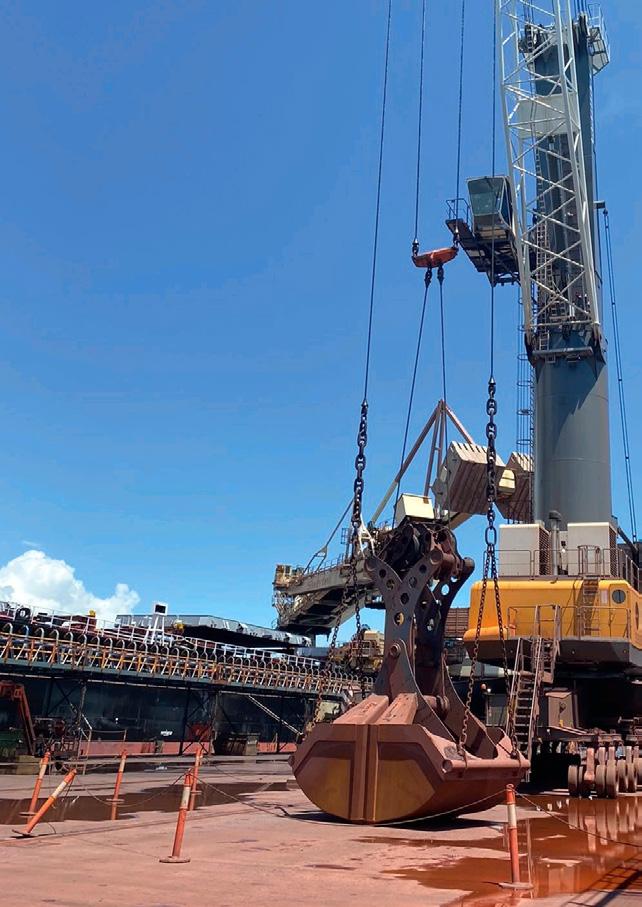


iron pellets. Here, VLI could move 800 tonnes per hour on average without the NemaX. With it, they can move 1,000t/h. “We are already pleased with these results. The thing is, though, we are still in a learning cycle. For example, we still sometimes need to adjust the configuration of the ropes. And the operators need some more time to get used to the grab. I strongly believe we can reach an even better performance with our Nemax, looking towards an average of 1,100 tonnes per hour,” comments Ribeiro.
The NemaX can reach a staggering 1,400t/h during free digging. This is 300t/h more compared to the competitor’s grab and 200t/h above what the Nemag Clamshell does in the free digging stage. Ribeiro adds, “It used to take up to five days to unload a ship. With the Nemag Clamshell and the NemaX side by side, we manage to unload the ships within four days! The savings in demurrage costs are considerable, to say the least!” Moreover, the NemaX has a far greater reach than conventional grabs. “Regarding cleaning out the hatch, the operators will tell me that when the situation at its worst, that’s when the NemaX works the best!” shares Ribeiro.
Then there’s maintenance. The NemaX ensures ‘clean’ work: the grab closes entirely and only starts opening – with zero rocking – when perfectly above the hopper. The relubrication time is reduced by 50%. And any consumable costs, such as steel cables, have been reduced by 30%.
Also, safety gains could not go unnoticed. Ribeiro explains, “Especially in Brazil, safety regulations are stringent, and with reason, of course. No doubt, the NemaX also brings a massive safety advantage. Because the grab can be placed open and flat on the ground, maintenance can easily be done at ground level. Because maintenance of the NemaX is very low-risk, we no longer have to deploy extra resources (staffing, lifting platform, etc.), which is a (cost)advantage in itself!”
And, naturally, other human elements also come into play. “I think it’s important to mention that working with the NemaX has brought the team a lot of joy. They’re happy that they can work under safe conditions, their job is made easier, and, of course, the massive increase in productivity positively impacts us all!”
(Ne)maXing it up
The first grab purchased by VLI for the Pecém site is expected to last another two years. By then, it will be replaced by a new NemaX. “Given the outstanding results, it’s the most logical step. With both cranes operating a NemaX grab, we expect to fully clear a ship in as little as three and a half days. This will reduce costs immensely. Furthermore, we will be able to service our customers even better. At the moment, we can unload 50 freighters per year on average. With both cranes operating with a NemaX grab, we can significantly increase the number of ships,” Ribeiro notes.
He sums up by saying, “Nemag provides first-class equipment with little wear and tear, even in extreme conditions. But perhaps more importantly, Nemag always offers reliable support. The openness to discuss technical improvements showcases their commitment to being a trusted supplier, putting their customers’ needs first. I can’t help but say that I am very satisfied.”

Since Abraham Grootveld developed his first grab and launched Nemag back in 1924, the world has changed significantly. Through constant innovation and by closely listening to and working together with our customers to create optimal solutions, we are proud that we can still convey our founder’s passion for performance to this day. Grab your favourite drink and visit nemag.com to learn more about dry bulk grabs.

Photos: Nemag
How changes in the operating environment have impacted the Finnish port sector
Tolerate uncertainty – go forward
by Janne Kojo, Specialist, Transport System, Finnish Transport Infrastructure Agency, and Marko Mäenpää, Special Advisor, Finnish Transport and Communications Agency
The Finnish maritime industry, including ports, is being influenced by many of the same change factors as elsewhere, but there are also some unique features among them. In maritime transport and its operating environment in Finland – and more broadly across the entire Baltic Sea region – several significant factors of change are currently at play: the energy transition and the required shift in propulsion systems for shipping, fluctuations in cargo flows caused by the COVID-19 pandemic, and Russia’s war of aggression in Ukraine, which continues to reshape the situation. At the same time, offshore wind power development and ice-breaking are major future issues for Finland. In addition, economic uncertainty, global political instability, and the unpredictable US trade policy pose significant challenges for maritime transport and ports.
For Finland, a well-functioning maritime sector is of vital importance. Approximately 55% of the total value of Finland’s foreign trade is carried out through maritime transport in the Baltic Sea. When looking only at goods transport, as much as 95% of foreign cargo tonnage is transported by sea.
For instance, among the many disruptions and measures to accommodate them, Finland has seen a re-balance of ro-ro and container traffic, with the former benefiting at the expense of the latter. The lack of empty boxes available to Finnish exporters, resulting from sudden disruptions or traffic rearrangements (including blank sailings), made ‘trailer shipping’ more attractive (read: predictable).
Climate change & winter navigation
In Finland, almost all ports freeze over for at least part of the winter. Navigating in ice is therefore very familiar, and ice-breaking plays an absolutely central role in ensuring transport runs smoothly year-round. Finland built or designed the majority of the approximately 150 icebreakers currently in use globally, making the country one of the world’s ice-breaking powerhouses. However, the future of winter navigation is challenged by increasingly unpredictable ice conditions (e.g., packed ridged ice) due to climate change, the increase in extreme weather phenomena such as gale-force winds, and, simultaneously, environmental
requirements, the reduction of emissions, and the improvement of vessel energy efficiency. In practice, this often means optimisation for open-water sailing and a decrease in the engine power and power-to-weight ratio of new vessels. Thus, the need for icebreaking assistance will probably increase in the future. As such, global warming does not directly mean easier navigation in the freezing northern parts of the Baltic Sea; quite the opposite.
Future fuels & electrification
The energy transition sweeping through societies is also evident within the maritime sector. For example, changes in fuel transport for energy production are taking place as the shift from fossil-based to bio-based and synthetic raw materials – and possibly hydrogen – progresses, affecting transport flows, modes, and volumes.
As a consequence of Russia’s war of aggression, fossil fuel shipments (mainly oil) that previously arrived in Finland from the east have been replaced by maritime imports from other destinations. In the longer term, this will also reshape global fossil fuel transport flows. Currently, a vast share of global maritime transport still consists of shipments of oil, coal, and natural gas. As these decrease, the volume of port traffic will also decline, requiring new types of business activities. In the meantime, some Finnish seaports have already witnessed the exchange of coal in favour of biomass going over their quays.
A key question also concerns future propulsion systems. Shipping companies are deliberating about the technology for their newbuilds. While full electrification is unrealistic for ocean-going shipping, shorter, regular routes – such as ferry & ro-ro traffic – could be electrified in a feasible way under certain conditions, thus providing an efficient transition path towards fossil-free transport. Electric vessels have even been envisioned for the Helsinki-Tallinn connection, one of the busiest ferry routes in all of Europe. Speaking of which, heavy-duty & longdistance trucking is also being electrified, creating a new task for ports to provide fast-charging stations (and maybe also incentives, like priority serving, to encourage hauliers to go electric).
The transition of vessels to new propulsion systems will also require ports to develop the related fuel distribution infrastructure. For a long time to come, ships are likely to use several energy sources and fuels side by side, which poses challenges for ensuring fuel availability and distribution. The above changes and requirements will demand not only major investments from ports and their operators but also sufficient space, permits, and new expertise.
Wind energy
When new investments are made in wind power, green hydrogen, battery manufacturing, or other emerging energy sources,

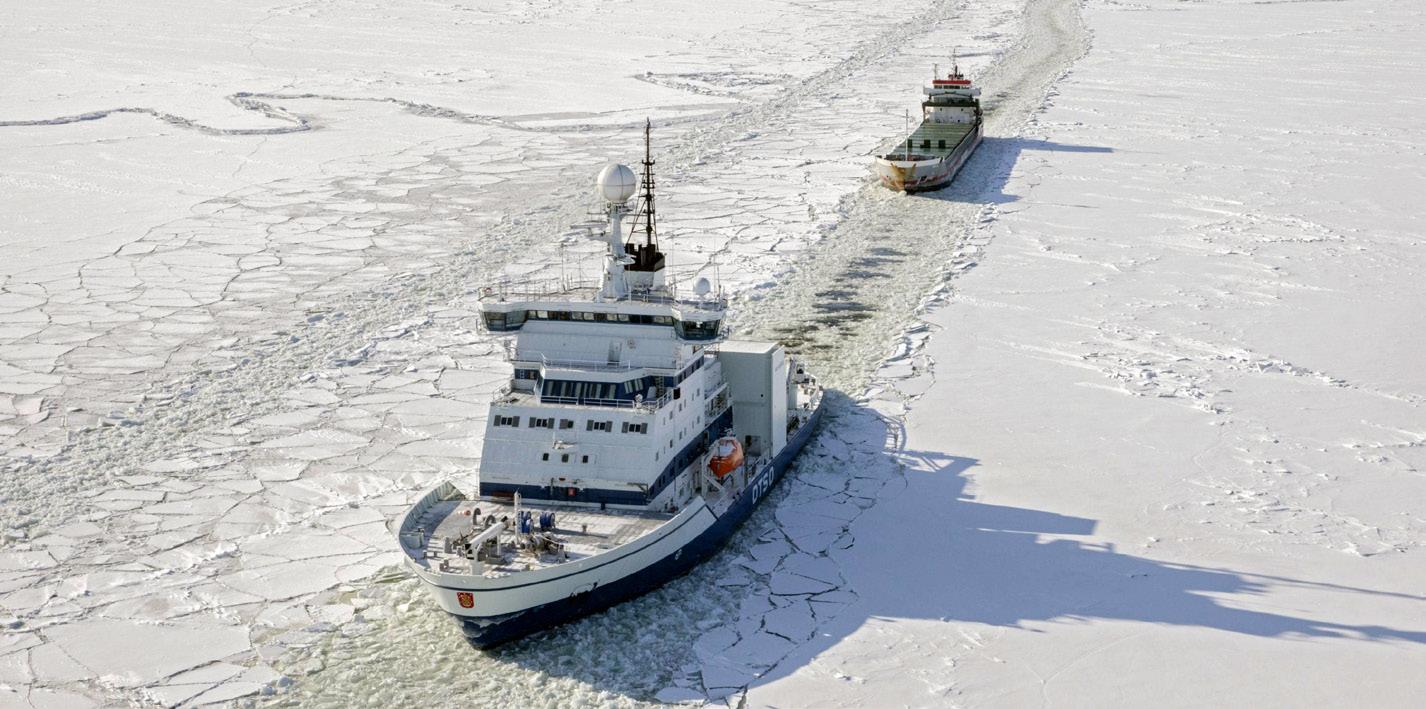
ports in Finland will play a vital role in the logistics and storage chains during both the construction and production phases.
The transition towards more sustainable energy production has meant, for example, a significant increase in wind power. The construction of wind farms in freezing seas, such as the Gulf of Bothnia where several potential projects are underway, requires specific coordination with maritime transport. Extensive offshore wind farms cause changes to the sea areas and shipping lanes. However, winter with its ice dynamics (such as the movement of ice floes) poses the greatest obstacle, which challenges winter navigation (hence working windows for farm erection, maintenance, and decommissioning/upgrading). Not all of the impacts are even known yet.
Also, wind logistics require proper infrastructure – quays with sufficient bearing, large (and clean) storage yards, equipment for taking care of oversized shipments (and personnel who know how to handle that machinery), etc. In short, multi-million investments which, in addition, aren’t put on hold (chicken vs egg) by decision-making delays (either on the wind energy farm investor or the public sector’s side).
Resilience & security
The COVID-19 pandemic highlighted the vulnerability of global logistics chains, which had been stretched to the near limit. The direct impact on ports, however, ultimately remained fairly limited. Challenges arose, for example, in maintaining regular, profitable liner services, as Finland’s foreign trade relies heavily on fixed ferry & ro-ro shipping schedules that combine passenger and cargo traffic on the same vessels to improve service levels. During
the pandemic, passenger traffic nearly came to a complete halt for some time.
In turn, Russia’s war of aggression in Ukraine has led to partial rerouting of vessel traffic across the Baltic Sea, due to sanctions. Cargo flows between Finland and Russia have dried up and have been replaced by new trades, largely by sea. Russian transit traffic through Finnish ports has decreased significantly. These changes have had a powerful impact on certain Finnish ports: some cargo groups and volumes have seen sharp declines, while entirely new flows have emerged. In the end, the war has affected maritime cargo traffic more than the pandemic.
Both the coronavirus and Russia’s war in Ukraine have underscored how rapidly situations can change. Concerns – and preparations for them, whether geopolitical, pandemic-related, regarding imbalances in imports and exports, or sudden changes in customs regulations – feature prominently in interviews with port operators.
The importance of resilience and security (including cyber) has grown for all actors. Maritime safety is continually threatened by GNSS disruptions in the Gulf of Finland; hybrid interference has increased, and there have been multiple submarine cable breaks. From a safety and environmental

perspective, concerns have also arisen as, following the cessation of Russian transport by many Western shipping companies, operations in the Baltic have largely shifted to the ‘shadow’ fleet. Finland works closely with its Danish partners on monitoring, reporting, and intercepting vessels that pose a threat to legitimate shipping, as well as infrastructure and the environment.
The role of ports and maritime transport in the security of supply and military mobility is especially critical in Finland. With the country and Sweden’s NATO memberships, international military exercises in Finland have increased, with several ports playing a key role. As part of these exercises, practices for military mobility and operational needs in potential emergency situations have been developed, along with the coordination structures. While this created a new business line for ports, it also added the challenge of having to reconcile the needs of both civilian traffic and military peacetime operations.
Despite these major challenges in the operating environment, maritime transport and logistics have adapted surprisingly quickly to changes. Challenges, however, continue, meaning that operators (in Finland and beyond) will need to tolerate uncertainty going forward.
The Finnish Transport Infrastructure Agency is responsible for developing and maintaining the state-owned road network, railways, and waterways. Through our tasks, which include maintaining the level of service of transport, we promote well-being in society and competitiveness of Finnish industries. Click vayla.fi/en to learn more.

The Finnish Transport and Communications Agency Traficom ensures smooth, sustainable, safe, and secure transport and communications connections and services, and promotes cyber security in Finland. Check traficom.fi/en for more.

Photo: Arctia
Protecting subsea cables in the Baltic – and beyond
Fragile lifelines
by Iain Grainger, Chief Executive, International Marine Contractors Association (IMCA)
Few people give much thought to the cables and pipelines that run unseen across the seabed. Yet in the Baltic Sea, these silent arteries are every bit as strategic as ports, airports, and railways. They carry the power that drives industry and lights homes, as well as the data that underpins everything from mobile banking to international trade.
Globally, subsea cables carry 99% of international data traffic and support some $50 trillion in annual financial transactions. In the Baltic, they also serve as conduits for cross-border power, linking the grids of neighbouring nations and carrying the renewable electricity essential to Europe’s energy transition.
However, recent events have exposed just how fragile these networks are. Their protection can no longer be treated as a technical afterthought; it must be elevated to the same level as defending a nation’s borders or safeguarding its critical military assets.
Vulnerabilities – exposed
Accidents remain the leading cause of cable failures. Anchors dropped or dragged, fishing gear snagged, and heavy equipment mislaid across buried assets can each sever vital connections. Every day maritime activity can, when compounded by tense geopolitics, become a trigger for wider strategic concern.
In October 2023, the Balticconnector gas pipeline and several data cables were damaged when a Hong Kong-flagged vessel’s anchor was dragged for kilometres along the seabed. Repairs cost tens of millions of euros, causing disruptions to both power flows and internet connectivity.
A year later, in November 2024, Finnish coastguards seized a tanker carrying Russian gasoline after it allegedly cut a subsea power line. That same month, two more internet cables were severed, one linking Sweden to Lithuania, another connecting Finland and Germany.
Sabotage suspicions and the geopolitical backdrop
The Baltic is not just an energy and communications hub. It is also a region of growing strategic friction, bordered by NATO
states and hosting Russia’s Baltic Fleet headquarters in Kaliningrad.
The explosions that destroyed the Nord Stream gas pipelines in 2022 showed how subsea infrastructure can be deliberately targeted. Since then, suspicion has grown that cables and pipelines may also be used as instruments of political intimidation or as a means to probe weaknesses.
Proving intent is difficult. Mechanical failure, human error, or severe weather may be responsible for individual events. But the pattern of repeated disruptions has led governments, militaries, and industry alike to recognise that subsea resilience is now a matter of strategic security.
The Baltic trial that raised global alarms
In mid-2025, the trial in Helsinki of the Eagle S tanker’s captain and officers, accused of serious criminal damage and disruption to telecom infrastructure in late 2024, highlighted this risk on the world stage. Prosecutors alleged that the Cook Islands-flagged vessel dragged its 11-tonne anchor for nearly 90 kilometres, severing the Estlink 2 power interconnector and four telecommunications cables between Finland and Estonia. The result was more than €70 million in immediate damages and days of disruption. NATO raised readiness levels, underscoring how quickly an incident, whether intentional or not, can escalate into a wider crisis. This trial served as a stark reminder that subsea lifelines are both essential and exposed.
What is happening in the Baltic mirrors a wider challenge. In early 2025, multiple cuts to subsea cables in the Red Sea resulted in internet outages spanning from Yemen and the Gulf to India and Pakistan. Disruptions rippled through markets and governments alike, underlining the global interdependence of seabed infrastructure.
Subsea networks are now recognised as critical national infrastructure. When they fail, the consequences are immediate: lost connectivity, financial shocks, and interrupted energy flows.
Strengthening resilience through partnership & preparedness
Here at IMCA, working closely with the European Subsea Cables Association (ESCA), we have consistently urged governments and regulators to take a more strategic approach to preparedness and resilience. Our joint recommendations emphasise the importance of public-private cooperation and sustained investment across the cable repair ecosystem. We believe action should centre on: targeted investment in the telecommunications repair ecosystem serving European and adjacent waters (including vessels, equipment, and critical supporting capabilities); collaboration with subsea power cable owners to identify sector-specific repair solutions; harmonised regulatory processes across jurisdictions to minimise delays; strategic stockpiling of essential spare parts and equipment to enable rapid response; and support for workforce development (among others, funding to upskill personnel and promote high-skill offshore careers).
Engagement between governments and industry through existing EU platforms, including the Cable Security Toolbox, offers a valuable route to build alignment and readiness before the next disruption occurs.
Skills and workforce: maintaining & growing capability
Subsea cable repair depends on a highly specialised workforce, including cable engineers, jointers, and vessel crews. While current capability remains strong, the sector faces an ageing workforce profile, and attracting new entrants has become a clear priority. Without

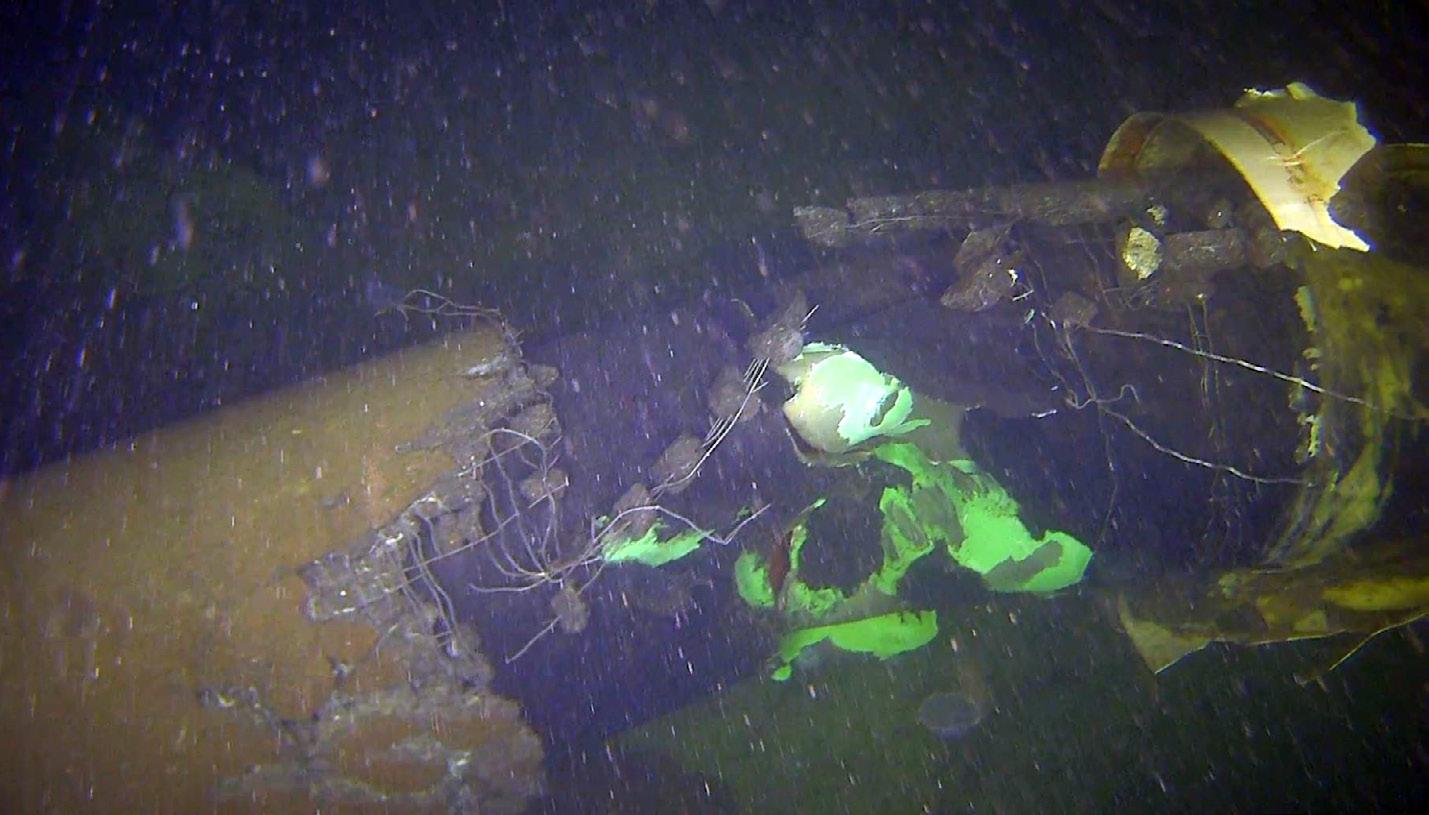
sustained efforts to recruit, train, and retain new talent, workforce shortages could become a bottleneck for repair response.
Here at IMCA, together with ESCA, we recommend: national programmes to train and retain specialist deck officers, marine engineers, and cable jointers; integration of subsea repair roles into national resilience strategies (including cross-training within naval or emergency response frameworks); adequate resourcing of regulators and licensing bodies, ensuring they have the capacity and knowledge to manage permit applications swiftly when urgent repairs are required.
This is not a challenge of capability but of planning, making sure that expertise built over decades is passed on to the next generation.
Policy reform: enabling faster, smarter repair
Regulatory frameworks can either accelerate or obstruct cable repair. Policies designed for other sectors (including but not limited to shipping, environmental protection, or fisheries) can unintentionally create obstacles to rapid response.
Here at IMCA, we believe that effective reform must: adopt fast-track permitting or exemptions across EU Member States, particularly for telecom cable repairs and maintenance; foster international coordination in policy and regulation, recognising that the cable repair fleet and its operations are global in nature; promote cross-border
cooperation that allows regulators and industry to mobilise personnel and vessels rapidly, without administrative delay.
Well-designed exemptions or preapprovals for emergency repair can significantly reduce recovery times and mitigate the economic and security impacts of cable failures.
What resilience should look like
For the Baltic and Europe more broadly, building resilience means: stronger physical protection – deeper burial of cables, protective rock placement, and improved design standards; smarter monitoring – fibre-optic sensing technologies to detect interference or vibration in real-time; shared maintenance capacity – regional pooling of repair resources for power cables, modelled on telecom agreements; closer civil-military coordination – NATO surveillance integrated with industry readiness for faster detection and repair; policy alignment –harmonised regulations across the EU and Baltic states to reduce delays and provide certainty for operators.
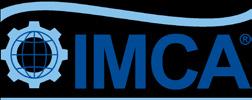
Not (simply) an engineering challenge
As Chief Executive of IMCA, I see daily the capability and commitment of our member companies, who are building and maintaining the offshore energy and communications systems that societies now depend on. But capability alone is not enough. It must be matched with strategic planning, investment, and regulatory support.
The Baltic incidents are not isolated warnings; they are proof that governments and industry must act now. These lifelines may lie hidden beneath the sea; however, their importance is absolute, and they must be defended and maintained with the same urgency and resources devoted to airspace, borders, and defence assets.
Protecting and repairing seabed infrastructure is not simply an engineering challenge. It is vital for the energy transition, and it is a matter of economic security, national defence, and global stability. The Baltic, in this sense, is not simply a regional story. It is a test case for how the world responds to the vulnerabilities hidden beneath the sea.
The International Marine Contractors Association (IMCA) is the global business association for construction and engineering companies working in offshore energy – both wind and oil & gas. Our membership of 700 companies comprises contractors, energy companies, and suppliers in over 65 countries. We have a 50-year history of developing and publishing best-practice technical and operational documents to improve the safety, efficiency, and performance of our industry. Sail to imca-int.com to learn more.

The damaged Balticconnector; photo: Wikimedia Commons
Safeguarding the maritime domain in the Baltic – militarily & commercially
You cannot defend what you cannot see
by John Mustin, President, Saildrone, and retired Vice Admiral, U.S. Navy
Flanked by NATO allies and partners, the Baltic Sea is one of the world’s most strategically important waterways. It is a vital corridor for commerce, a flash point of great-power competition, and home to the undersea pipelines & cables that power Europe’s energy and digital economies. I served nearly three and a half decades in the U.S. Navy – including experiences planning BALTOPS as Deputy Commander of U.S. 2 nd Fleet and later as Commander of Expeditionary Strike Group 2 – during which I witnessed firsthand that a free and stable Baltic is essential to European security. I also observed during military planning sessions that the region was exposed. Its narrow geography, proximity to adversaries, and dependence on critical infrastructure make it acutely vulnerable to disruption.
Today, traditional approaches – periodic patrols and episodic surveillance – no longer deter or defeat the threats facing our NATO partners. Securing the Baltic now demands capabilities that are persistent, adaptive, and intelligent. That belief, shaped by decades at sea and sharpened by today’s evolving threat environment, is what brought me to Saildrone. Persistent and autonomous systems like ours are no longer optional; they are foundational to credible maritime defense. In a region defined by proximity, speed, and complexity, we provide the continuous presence and real-time intelligence needed to close critical gaps. Without it, Europe’s security architecture will remain incomplete.
Spotless awareness + real-time intel + persistent visibility
The Baltic is a dense, contested waterway: a crossroads of constant commercial traffic, unconventional threats, and adversaries eager to exploit any lapse in awareness. Traditional patrols inevitably
leave gaps – and in those gaps, risk grows. That’s why maritime domain awareness is the foundation of security in the region. Baltic nations must maintain a persistent, comprehensive picture of what’s happening on, above, and below the surface. As one regional policymaker put it, “awareness is deterrence,” and that awareness is not a luxury; it is the first layer of defense. Persistent, autonomous, and real-time awareness closes the blind spots that manned fleets cannot. Operating continuously 24/7/365 with mission-tailored sensor packages, Saildrone’s vehicles patrol without crews or refueling, powered by wind and solar energy. Deployed in coordinated fleets, they blanket approaches, sea lanes, and choke points, extending the reach of coast guards & navies and multiplying the impact of limited assets. The result is widearea maritime surveillance, sustained for months on end, turning the Baltic from a patchwork of uncertainty into a domain that can be monitored, understood, and defended around the clock.
But awareness is only the first step. To stay ahead of sophisticated threats, commanders must turn raw data into actionable intelligence; intel that anticipates rather than reacts, revealing hostile behavior, tracking targets across domains, and informing decisions in real time. Adversaries in the region are using irregular tactics: Russian artificial general intelligence operations are expanding, commercial vessels are being weaponized for jamming & spoofing, and the electromagnetic spectrum is being manipulated to hide intent.
To counter that, data collected from our advanced electro-optical, radar, AIS, and acoustic sensors is processed on the edge by potent artificial intelligence algorithms and machine learning models, detecting and prioritizing threats as they emerge. This enables Saildrone to expose hidden, multi-domain activity – including undersea risks – and provide decision-makers with timely, meaningful intel that stays ahead of evolving threats.

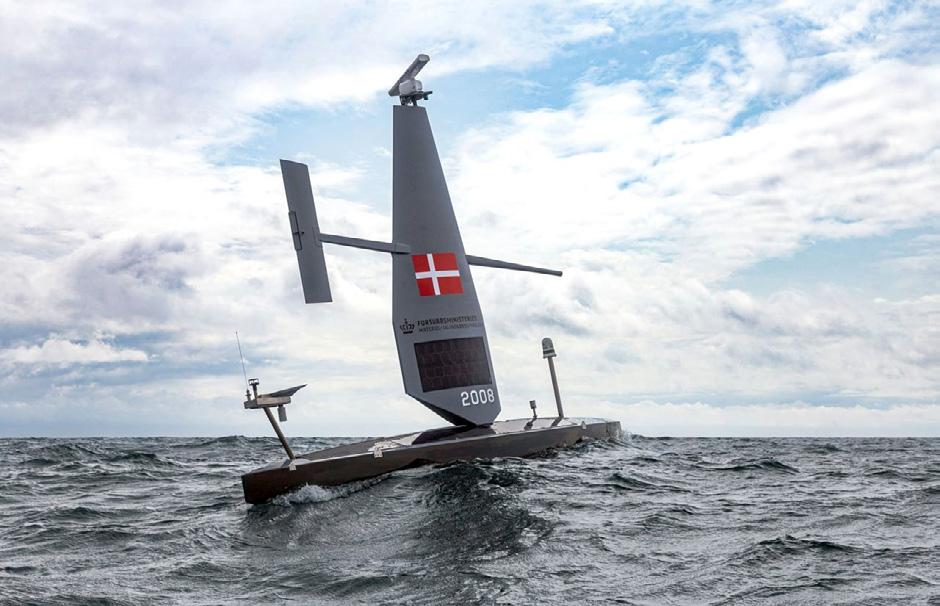

Even with persistent awareness and realtime intelligence, though, the mission is incomplete without securing the most vulnerable part of the maritime battle space: the seabed. Europe’s prosperity and its deterrence credibility depend on critical infrastructure beneath the Baltic’s surface, where pipelines and fiber-optic cables serve as the silent arteries of its economy. Their disruption can devastate energy markets, sever communications, and fracture alliances, as seen with the Nord Stream sabotage and repeated cable interruptions. Yet these networks remain difficult to monitor, while a growing ‘shadow fleet’ manipulates AIS transponders to evade detection. These unseen lifelines need visibility; persistent visibility. Simply put, you cannot defend what you cannot see! Our vehicles patrol critical nodes continuously for months, conduct undersea surveys, detect suspicious activity, and deliver early warning before damage is done.
Farther, longer, and for less
The nature of maritime warfare is changing, and traditional fleets – built for high-end conflict – were never designed for continuous surveillance, infrastructure defense, or gray-zone deterrence. Nations now recognize that the future is hybrid: crewed ships, un-crewed platforms, and advanced sensors working together.
With over a decade of operational experience and 60,000+ cumulative days at

sea, we’ve proven our ability to go farther, last longer, and deliver the intelligence advantage needed to defend sovereignty and secure vital infrastructure. And with a variety of business models available to support our customers, Saildrone delivers this capability at a fraction of the cost of crewed assets. Rear Admiral Carlos Sardiello, Commander of the U.S. Navy’s 4 th Fleet, shared an important Center of Naval Analysis study in his September 2025 U.S. Naval Institute article, Develop the Hybrid Fleet in Southcom , concluding Saildrone’s cost per nautical mile of surveillance is less than 5% of that of a guided missile destroyer. By providing an unmatched range, precision, endurance, and affordability, we multiply the effectiveness of allied fleets, freeing crewed ships for high-end missions only humans can perform while delivering the persistent surveillance and domain awareness modern deterrence demands.
Baltic (at & under) sea power
Persistent, autonomous intelligencesurveillance-reconnaissance is no longer optional – it’s the backbone of modern maritime defense. Without it, the Baltic will remain a tapestry of exploitable gaps. With it, the region can be monitored, defended, and secured. By augmenting existing fleets and surveillance networks, our platforms provide actionable intelligence where and when it matters most: helping to defend sovereignty, secure commerce, and protect the infrastructure underwriting European strength.
In an era of heightened tension and gray-zone threats, Baltic nations need partners who can deliver intelligence dominance at sea. Our company’s rugged, wind- and solar-powered un-crewed surface vehicles have already sailed over two million nautical miles, from the North Sea to the Southern Ocean, proving their endurance and resilience in the harshest conditions. Now, we are ready to scale that proven capability and deliver the persistent maritime advantage the region’s security demands.
A former U.S. Navy Vice Admiral and C-suite technology entrepreneur, John Mustin brings to Saildrone over three decades of experience at the intersection of national security, emerging technology, team development, and enterprise growth. A frequent speaker, published author, early-stage start-up investor, and advisory board member, he has led large, global enterprises and managed multi-billion-dollar budgets. With a BSc in Systems Engineering from the United States Naval Academy, a Master’s in Operations Research from the Naval Postgraduate School, and an MBA from Babson College, he is an advocate for military & veteran causes, and speaks & writes regularly on national security topics & post-military service hiring practices.

Photo: Saildrone
Photo: Center for Naval Analyses
Rethinking retrofit execution for high-demand vessels
Quality – wherever the work takes us
by Matteo Di Maio, Co-founder and Director, Bluestone Group
As shipping faces the twin pressures of decarbonisation and maintaining commerciality, retrofit strategies are becoming a defining factor in competitiveness. Regulatory frameworks such as FuelEU Maritime and the EU Emissions Trading System have set hard deadlines for emissions reduction, yet many operators are struggling to align compliance requirements with operational realities.
The challenge is not just one of technology, but timing. Lloyd’s Register has estimated that global shipyard capacity can currently handle around 465 retrofits a year, compared with a projected demand of over 1,000. Further modelling from ABS and MSI suggests that even under moderate growth scenarios, capacity shortfalls will emerge before 2030, while Drewry’s market outlook points to a sharp rise in repair-yard days as retrofit activity accelerates. Together, these findings highlight a systemic capacity gap that will only intensify as regulatory deadlines approach.
For operators of high-demand assets (such as cruise ships, offshore support vessels, and cable- and pipe-layers), lengthy yard stays are not only commercially costly but often incompatible with normal operational schedules. This constraint is forcing operators to rethink the way they approach retrofit execution. Retrofitting can no longer be treated as a periodic, one-off intervention; rather, it must be embedded into operational strategy, delivered with minimal disruption, and closely planned across the life-cycle of the vessel.
Finding the right rhythm
The traditional shipyard-centric model is showing its limitations. Extended yard stays tie up capacity, increase the risk of non-compliance, and impose substantial opportunity costs from lost trading days. In contrast, on-voyage or in-port retrofits, supported by meticulous pre-engineering, prefabrication, and supply chain planning, enable upgrades to be carried out in parallel with operations.
This approach has already proven effective. Over the past few years, Bluestone has executed more than 1,000 retrofit projects globally. One example is the replacement of air-conditioning chillers on large cruise ships. These systems are among the most energy-intensive consumers on board, second only to propulsion. By replacing
outdated chillers with modern units driven by frequency converters, electrical consumption is dramatically reduced. On vessels where each HVAC unit can weigh up to 45 tonnes, we have developed methods to replace units in less than 72 hours – a critical capability when off-hire translates directly into lost passenger revenue.
Air lubrication systems are also in high demand. By creating a carpet of bubbles along the hull, these systems reduce friction and can deliver fuel savings of up to 10%. For a major cruise operator, Bluestone installed compressors, piping, and on-board cabling while vessels remained operational, leaving only final external works to be completed during a short dry-dock visit. The programme spanned Italy, Singapore, and the Netherlands, involving 21,000+ workerhours and 8,000 metres of cabling.
Advanced wastewater treatment has been another major area of activity. On a cruise ship of 113,000 gross tonnage, we converted freshwater tanks into bioreactors, installed 1,400 metres of piping and 9,000 metres of cabling – all within a confined, operating engine room. The team worked aboard for six months, maximising the scope of work completed in service to reduce time spent in yard to finalise integration.
Each of these projects demonstrates that with the right preparation, large-scale upgrades can be completed without prolonged downtime. The lesson is clear: retrofitting is no longer about waiting for the next dry-docking slot but about integrating technical upgrades into the operational rhythm of the vessel.
Working like a ghost
Environmental deadlines compress timeframes even further. Retrofitting for efficiency, emissions reduction, or fuel readiness is no longer optional – it is a regulatory obligation. Owners who delay risk not only
higher fuel costs and lost charter opportunities but also penalties for non-compliance.
The complication is that many retrofits require multi-system integration across electrical, piping, structural, and automation disciplines – often in parallel. Without rigorous planning and coordination, a project that should take days can quickly extend into weeks. Dry-dock intervals are also shortening. Where major overhauls were once carried out every 4-5 years, many vessels, especially cruisers, are now visiting every 2-3 years, largely driven by rising passenger expectations and new technologies. This has created additional pressure to complete more work in less time, increasing the value of partners who can prepare thoroughly in advance and execute quickly when the opportunity arises.
For this reason, forward-looking operators are increasingly treating retrofits as part of a vessel’s life-cycle strategy. This reduces compliance risk by anticipating requirements early, preserves revenue by minimising off-hire, and ensures global consistency across fleets. A quality delivery model must ensure the same engineering standards are applied wherever a vessel is operating, which is becoming essential as operators manage fleets that span multiple regions. This consistency is achieved at Bluestone through centralised front-end engineering, a vetted global supply chain, and the deployment of our own multidisciplinary teams under the oversight of dedicated project managers. The result is the same technical precision, safety discipline, and reporting quality wherever the work takes us.
Life-cycle alignment also means scheduling retrofits around natural operational pauses. For passenger ships, cabin availability must be carefully managed to avoid lost revenue. For offshore assets, work is often integrated with project schedules. Enter ghost mode, an operational approach that minimises disruption, respects on-board protocols, and leaves


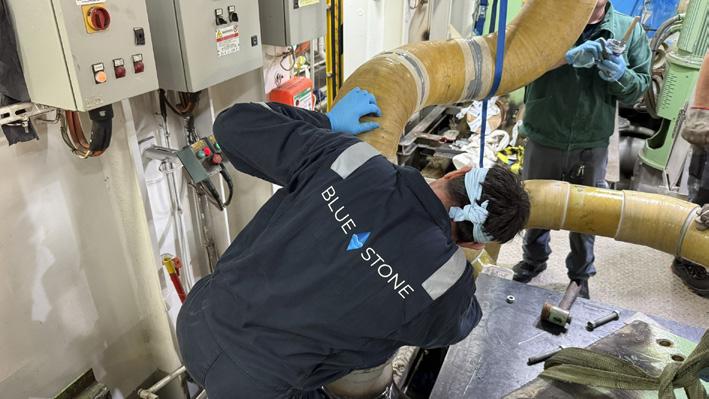
spaces clean and ready for immediate use. In this way, retrofitting is not just about installing technology but about preserving uptime, ensuring safety, and keeping assets competitive throughout their service life.
Retrofit challenges
– both technical and logistical
The growing complexity of retrofit execution is clear from recent projects. On a pipe-layer vessel in the offshore industry, we delivered a complex electrical installation that involved pulling and installing both medium- and low-voltage power systems, integrating switchboards and automation interfaces – with commissioning under pandemic restrictions. The work had to be carried out in confined spaces, at height, and in coordination with other maintenance activities running in parallel. Despite these challenges, the project was delivered on time and on budget. This example underlines the fact that retrofit execution now requires as much project management and safety planning as engineering skill.
Other projects highlight a similar trend. On a Princess Cruises vessel, cooling pumps critical to ship function were replaced during active operations with
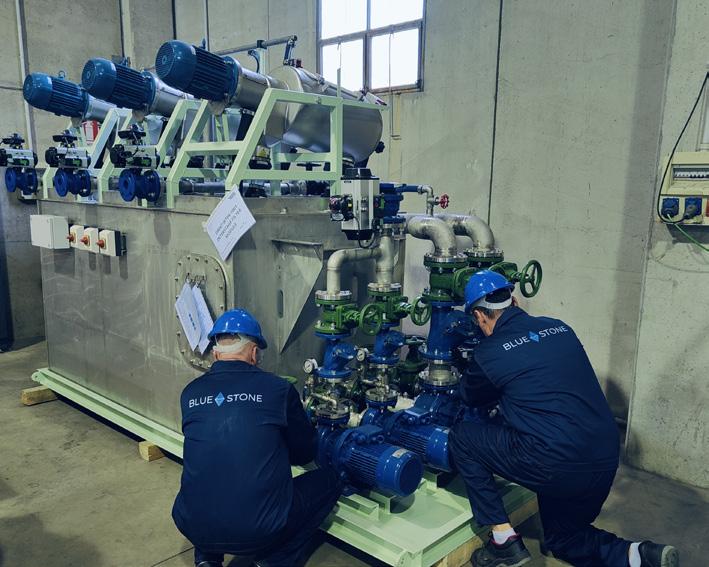

only a two-hour window available. The upgrade required coordination across the electrical, piping, and steelwork disciplines, leaving no margin for error. Meanwhile, a fleet-wide decarbonisation programme with Corsica Linea involved propeller reblading, hull modifications, coatings, and exhaust system upgrades across multiple ferries. Bluestone supported projects in France, Tunisia, and Türkiye, ensuring consistent execution and continuity across regions. The outcome was improved efficiency and environmental performance across the fleet, showing the value of a single trusted partner when multiple vessels require complex upgrades.
Together, these cases underline that retrofit challenges are both technical and logistical. Success depends on robust planning, coordination across disciplines and geographies, and the ability to adapt quickly when schedules shift or unexpected issues arise.

At sea, at speed, at scale
The retrofit pipeline will only intensify. Upcoming fuel-readiness retrofits for methanol, ammonia, and hybridisation are already more complex than current projects, requiring precise multidisciplinary integration and execution capacity at a global scale.
Digital tools will help manage this complexity, supporting simulation, prefabrication, and real-time reporting – but technical know-how and hands-on experience remain vital. Owners need partners who can not only install equipment but also model return on investment, anticipate supply chain risks, and deliver consistent outcomes across diverse fleets.
In an environment defined by regulatory pressure, scarce yard space, and unrelenting commercial schedules, retrofits can no longer be delayed until conditions are convenient. They must be delivered at sea, at speed, and at scale.
The Bluestone Group is a global provider of technical services to the maritime and offshore energy sectors. Specialising in retrofits, newbuildings, and life-cycle asset management, the company delivers engineering-led solutions that combine sustainability, operational continuity, and digital innovation – including on-voyage interventions and minimal off-hire clean-tech integrations. Go to bluestone-group.com/service/retrofits to learn more.

Photos: Bluestone Group
Baltic ports gathered in Gdańsk to define the future of regional maritime cooperation
by Monika Rogo, Communication Manager, BPO
The 2025 edition of the Baltic Ports Conference (BPC), organised by the Baltic Ports Organization (BPO) and hosted this time around by the Port of Gdańsk, was held during the 23 rd International Maritime and Military Fair BALTEXPO in Gdańsk on 6-8 October. The event tackled some of the most topical issues faced by the port & shipping industries: developmental prospects in times of uncertainty, handling regulatory pressures (especially on the environmental side), and safety. Also, BPO penned a Memorandum of Cooperation with the Ukrainian Sea Ports Administration (USPA) and bid a hearty farewell to the Port of HaminaKotka’s Kimmo Naski, its Chair for the past seven years, concurrently warmly welcoming the Port of Gdańsk’s Alan Aleksandrowicz at the helm.
This year’s BPC started unofficially with an evening welcome reception at the Vidokova Restaurant in the Museum of the Second World War in Gdańsk. The following two days included substantive sessions, key internal meetings for BPO, and many networking opportunities.
Kimmo Naski, Arkadiusz Marchewka, Secretary of State at the Ministry of
Infrastructure of Poland, Piotr Grzelak, Deputy Mayor for Sustainable Development and Economy at the City of Gdańsk, and Alan Aleksandrowicz, Vice-President of the Management Board for Finance and




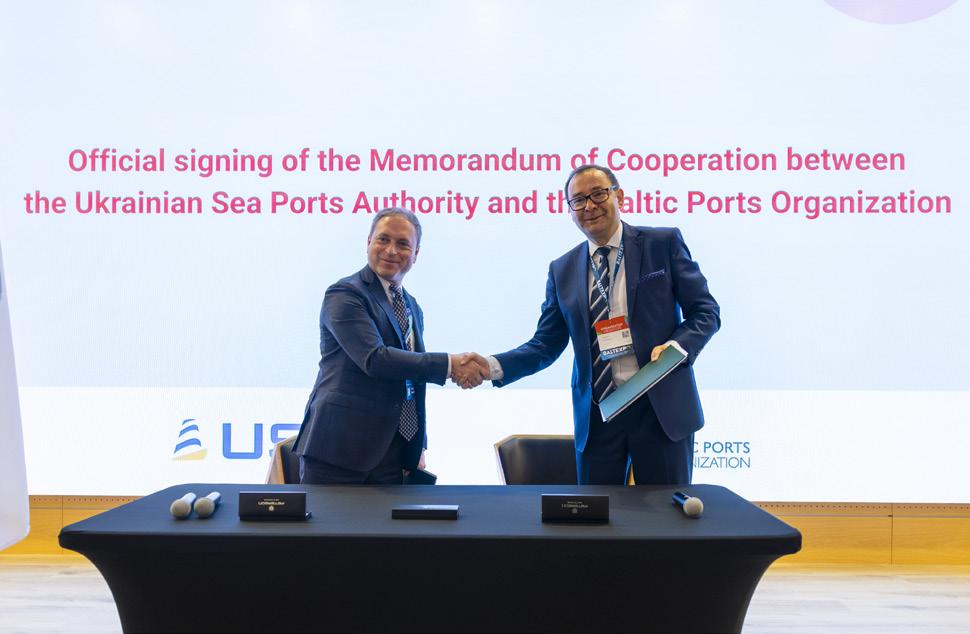
Security at the Port of Gdańsk Authority, opened the conference.
The first day was devoted to putting the finger on where the region’s seaports are right now – also charting a growth course in these times of unpeace and trade fluctuations. Participants learned about innovative approaches to the green transformation, including investments in port & ship decarbonisation (some of them cuttingedge and truly world’s first).
After session I, the BPO-USPA partnership was signed & sealed by Vitalii Vaidych, Head of the Investments and Public-Private Partnership Department of the Head Office of USPA, and Bogdan Ołdakowski, BPO’s Secretary-General, the overarching aim of which is to develop cooperation between the two organisations and their members (among others, exchanging experiences and best practices in port management; attracting
hard- & software investments; working together on environmental policy and ‘green port’ initiatives; developing logistics, new supply chains, and trades; promoting professional development, and providing assistance and support in restoring and rebuilding post-war port infrastructure).
After session II, Ewelina Ziajka, Senior Key Account Specialist at the Port of Gdynia, invited BPC participants to attend the Baltic Ports for Climate Conference hosted by her seaport on 19-20 November 2025.
In the afternoon, after the concluding session III, participants could partake in the BALTEXPO tour, while the BPO General Assembly took place. During the vote, a new BPO Chairman was elected in the person of Alan Aleksandrowicz. Day 1 ended with the official gala dinner, the Salmon Evening, featuring the titular fish in many shapes and forms.

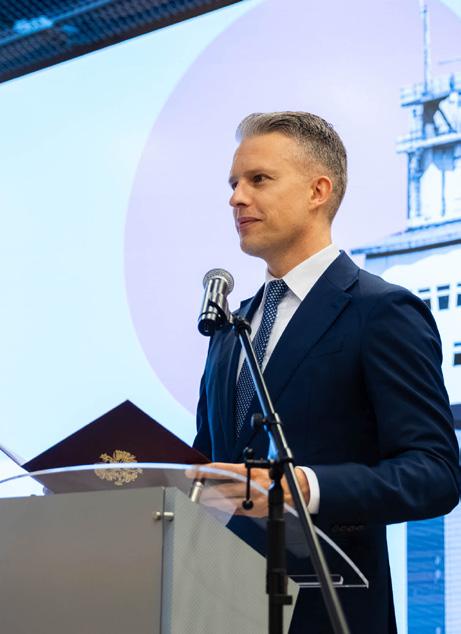
Day 2 of the BPC focused on the security and resilience of ports in the face of global threats and challenges. Experts discussed risk management strategies, military mobility, and how modern vessel traffic systems do their best to ensure safe and smooth navigation.
After session I, there was an official farewell to the outgoing Chairman of the BPO, honoured with a witty laudation and a commemorative gift. This was followed by introducing the organisation’s new helmsman. Session II ended with an official handover of the BPO flag to the host of BPC 2026, the Port of Turku. The conference concluded with a somewhat rainy, but notwithstanding the soggy weather, merry boat tour around Gdańsk’s Inner Port.
See you on the Finnish southwestern coast from the 2nd to the 4th of September 2026, at the next edition of the Baltic Ports Conference! Kippis!

Photos: GospodarkaMorska
Tech & regulatory developments towards nuclear ship propulsion
The (zero-emission) prize at the end of the (long) race
by Alexa Ivy
Nuclear-powered vessels have a long history in naval and icebreaker applications, though atom-freighters did not leave the demonstration-project period of 1962-72 (with one still working since the late 1980s exception). That said, the emergence of the 4th generation small modular reactors (SMR) is opening the way for using this emission-free technology also in commercial shipping. But any race towards a nuclearpowered commercial maritime future will require a marathon-like rather than a sprint commitment.
In September 2025, ABB signed a memorandum of understanding with Blykalla, a Swedish nuclear energy company, to support and accelerate the deployment of small modular leadcooled reactors to the maritime industry. The agreement builds on the terms of a 2024 deal between the two, which targets developing SMR technology to support Sweden’s clean energy requirements.
Blykalla’s Swedish Advanced Lead Reactor (SEALER) is a highly compact, passively safe reactor with inherent safety features ensuring stability even without external control. SEALER is also one of the three reactors identified in the Nuclear Propulsion for Merchant Ships I (NuProShip I) project, which aims to adapt a gen-IV SMR to the requirements of maritime vessels – in particular, larger ships. “With our compact reactor design, we see a unique opportunity to lead the way in maritime nuclear propulsion – a solution uniquely positioned to meet the sector’s demand for clean energy,” commented Jacob Stedman, CEO at Blykalla. “Realising this vision will require an ecosystem of committed partners, and this collaboration is a critical building block.”
ABB’s expertise in system integration as well as in power distribution, control,
and automation technologies will be key to ensuring the successful deployment of the SMR as a shipboard solution. Once put on a vessel, an SMR would require little or no refuelling at all. “We look forward to advancing the viability of SMRs in maritime applications. Next-generation SMRs will enable innovative ship designs that can help to reduce emissions compared to vessels powered by carbon-based fuels,” said Samuli Hänninen, Segment Manager, Icebreaking ships, ABB Marine & Ports.
Nuclear intervention
The expansion of the agreement’s terms is certainly timely. This October, the International Maritime Organization (IMO) is set to adopt the Net-Zero Framework to make it legally binding to reduce ship greenhouse gas emissions to net-zero by 2050 (with entry into force due in 2027).
Many in the maritime industry are expressing doubts over the availability of alternatives to heavy fuel oil and liquefied natural gas so far proposed. Stakeholders hold different views on the extent to which biofuels, methanol, ammonia, batteries, and fuel cells can get the ‘net zero’ job done, considering the size of the affected ship fleet, with some suggesting that
– even in the best-case scenario – “all of the above” will be needed.
In early 2024, the European Commission announced the launch of the European Industrial Alliance on SMRs, which aims to facilitate and speed up the development, demonstration, and deployment of SMRs in Europe by the early 2030s. The case for nuclear ship propulsion was also distilled by the EU’s closest neighbour when Torbjørn Lie, OSM Thome’s Business Development Manager, earlier this year introduced Norway’s Green Shipping Program’s Advanced Nuclear in Maritime Report. He commented, “In the pilot, the aspect of insurance has been particularly interesting to learn more about, including the challenges, possible solutions, and seeing that the Norwegian marine insurance industry is an active and inquisitive party that wants to contribute to the success of the maritime industry’s green ambitions.” Skuld’s Decarbonisation and Transition Risk Lead, Matias Bøe Olsen, added accordingly, “Nuclear is an interesting zero-emission option that can meet IMO ambitions for 2050, support energy demand, and be a viable technological possibility. As insurance excludes nuclear fuels and lacks international conventions to change this,

we welcome insight and a new debate on the topic. The pilot project allows us to get a basic insight into the risks associated with nuclear fuel. We have to mature as an industry to allow the industry to discuss nuclear as one of the many options for reducing emissions.” With appropriate investments and regulatory support, nuclear propulsion would contribute strongly to maritime decarbonisation, “especially since 85% of the one billion tonnes of carbon emissions we are supposed to eliminate by 2050 comes from deep sea ships of above 5.0-megawatts,” Lie added.
Patience will be instrumental to realise the full potential of nuclear ship propulsion, according to Markus Virtasalo, Solution Manager, Electric Solutions, ABB Marine & Ports. “From ABB’s perspective, we have been empowered to make an early start on nuclear ship propulsion, which puts us in a strong position to accommodate any surprises that we’ll meet along the way. But the prize is a reliable source of ship power that generates zero emissions – even at high vessel speed – works independently of any external decarbonisation device or fuel supply chain issue, and needs little or no refuelling at all. That is certainly a marathon worth running!”
Getting those regulations in shipshape
Stamina for the long game will also be needed to align with the timeline of regulators as they reframe maritime legislation to accommodate nuclear-powered ship propulsion.
Formally, the IMO adopted the Convention on the Liability of Operators of Nuclear Ships in 1962 (the year when States Marine Lines started operating NS Savannah), but the instrument was never ratified. Even though the Code of Safety for Nuclear Merchant Ships was adopted by the IMO Resolution A.491.XII in 1981 into the Safety of Life at Sea Convention, there is currently no marine liability convention applicable to commercial vessels using nuclear power for propulsion.
In June this year, IMO’s Maritime Safety Committee (MSC110) agreed to begin updating legacy regulations governing nuclear-powered ships, tasking the Sub-Committee on Ship Design and Construction to start work on a framework to bring nuclear propulsion into the mix to achieve net-zero emissions by (around) 2050. Critically, the updated Code of Safety for Nuclear Merchant Ships will look beyond pressurised water reactor (PWR) systems with direct steam cycle propulsion to incorporate the 4th generation nuclear technology innovations.
Soon after, in July 2025, the IMO gave NGO status to the Nuclear Energy Maritime Organization (NEMO), in what must be seen as a rapid acceptance of a grouping established only last year. NEMO – whose members include, among others, shipowners, shipyards, classification societies, insurers, legal companies, and port authorities – focuses on developing the fine detail of regulatory frameworks for SMRs and floating nuclear power systems to bring to the IMO recommendations for port calls.
Other regulators are proving comparably receptive: the International Atomic Energy Agency is developing ATLAS (Atomic Technologies Licensed for Applications at Sea), a set of regulatory structures for nuclear propulsion and floating nuclear power facilities. Class (Lloyd’s Register, ABS, RINA, and DNV) are also making strong efforts to support the nuclear option. Last year, for example, Maersk joined a nuclear-powered container ship feasibility study, working with Lloyd’s Register and Core Power. In September 2025, Samsung Heavy Industries and the Korea Atomic Energy Research Institute, in co-op with ABS and the Flag of Liberia, jointly developed a concept for an SMRpowered LNG carrier design. Elsewhere, an SMR-powered 15,000-TEU container ship design from South Korea’s HD Korea Shipbuilding & Offshore Engineering has already secured approval in principle from ABS (with a HAZMAT study also underway with DNV).
Festina lente
Today, the concept design work carried out by ABB Marine & Ports includes engineering the systems needed to convert thermal energy to electricity and propulsion. “From the naval architect’s perspective, work to interface a nuclear reactor with a versatile ‘steam-electric’ power plant and to integrate it with electric motor-driven shaft lines or Azipod propulsion involves familiar thought processes, and practical knowledge of the flexibility of steam-electric

power as a suitable solution across diverse vessel types,” said Hänninen. He furthers, “Currently, it is possible to work on generic system solutions, leaving reactor-specific interface work until later.”
Pre-dating the recent Blykalla announcement, ABB’s work on nuclear power has already included concepts like a shuttle tanker and a container vessel. While the timeline for market readiness of the maritime SMR remains elusive, it is closely monitored, and plans are updated accordingly. Blykalla foresees its first nuclear reactor reaching criticality in the early 2030s.
Nuclear propulsion went truly mainstream at this year’s London International Shipping Week, as the headline topic at four seminars and a frequent discussion point for financiers, owners, consultants, insurers, reinsurers, and others at general fuel events. Virtasalo is taking a pragmatic position towards the recent increase in interest in maritime nuclear. “Now is a good moment to assess main goals and principles as we approach overall system design, while applicable rules for commercial nuclear ship installations are not yet available. Reviewing the old rules written for 3rd generation PWR technology and evaluating which parts of those will remain and which parts will be updated to cover 4th generation SMR technology will take due time to process,” he said.
First on-board nuclear solutions could be pilot projects with pioneering shipowners or unique vessel types (like power plant barges). First marine-SMR adoptions could also be seen in special trades or in dedicated green corridors that are subject to bilateral agreements, Virtasalo thinks. He sums up by cautioning, “Patience will be critical. Nuclear-powered ship concept design work will involve collaboration with more stakeholders and more thorough documentation than conventional vessels and may thus take a longer time. Design schedules are also linked to SMR developers’ roadmaps for developing reactors of different sizes and types.”
A global technology leader in electrification and automation, enabling a more sustainable and resource-efficient future. By connecting its engineering and digitalisation expertise, the company helps industries –including the maritime (ports & shipping) sector – run at high performance, while becoming more efficient, productive, and sustainable so they outperform. Sail to global.abb to discover more.

A Swedish developer of advanced small modular reactors (SMR), commercialising lead-cooled fast reactors for industrial use. Based on 20+ years of research, their SEALER technology is a compact 55MWe unit designed to offer a safe, efficient, and scalable power solution. The company aims to deliver Europe’s first advanced SMR, providing reliable and sustainable baseload energy to power AI and clean industries. Head to blykalla.com to learn more.

A call for rigorously scrutinising the green credentials of future fuels
Cure worse than illness?
by Rob Mortimer, CEO, Fuelre4m
The global conversation around decarbonisation has reached a fever pitch, with the International Maritime Organization (IMO) even failing to reach a decision on the Net-zero Framework during the autumn meeting of the Marine Environment Protection Committee – the vote delaying the decision for a year. Policymakers, NGOs, and industry leaders line up to hail new technologies as the silver bullet that will deliver a clean future. Hydrogen, ammonia, synthetic fuels, electrification, you-name-it – the list is long and growing. Projections estimate that 2050 Baltic international shipping CO2 emissions (for IMO-registered ships) will be ~48% lower than 2008 levels. Each new announcement is made with a sense of inevitability, as if the mere fact that an alternative exists means fossil fuels should be discarded immediately. But the uncomfortable truth is this: we cannot yet answer the most important question. Better than what?
Until that question is answered with evidence, data, and accountability, there is a real risk that in rushing to embrace the new, we may create something worse than the old. If the cure proves more damaging than the illness, nothing has been achieved. The world deserves honesty – not slogans –and this is where the maritime sector must take a firmer, more disciplined stance.
The mirage
In every cycle of innovation, there is a temptation to believe in miracles; in the Next Big Thing that will send the competition to the ash heap of history. The shipping industry has seen this before with liquefied natural gas (LNG). Heralded as the clean (transition) fuel of its era, it was rolled out at speed across fleets without a full grasp of the life-cycle of
methane slip that undermines much of its environmental benefit.
The lesson is painful but vital. Simply switching fuels or technologies without holistic measurement can replace one set of problems with another. Today, hydrogen, ammonia, and synthetic fuels are being elevated in the same way… and before we fully understand the safety implications, the production emissions, and the infrastructure realities.
The maritime sector cannot afford to repeat the LNG experience. We need innovation, sure enough, but we need it grounded in rigorous measurement, not marketing.
The unfashionable but unavoidable reality
It has become politically incorrect to say this, but fossil fuels remain the backbone of global transport. More than 90%
of world trade moves by sea, and almost all of it depends on oil-based fuels. No amount of ambition alters the scale of that reality.
This is not a defence of the status quo. Fossil fuels will – must – decline. But in the interim, until viable large-scale alternatives are ready, the world will continue to consume more barrels a day. Millions more. The question is whether those barrels are burned wastefully or optimised to deliver every possible unit of efficiency.
That is the space where companies like Fuelre4m are working: not to defend fossil fuels indefinitely but to ensure that each drop is used with maximum efficiency, minimum waste, and a measurable reduction in emissions. Optimisation is not glamorous, but it is measurable, immediate, and available today.
Optimising existing fuels is not an excuse for delay. It is the pragmatic bridge


between aspiration and reality. Every percentage point of efficiency gained in existing operations reduces emissions right now, without waiting for infrastructure, regulation, or technology to catch up. In practical terms, that means extending the useful life of existing assets while making them cleaner. Zero retrofit – or limited technology addition. Reducing waste and inefficiency that needlessly add to emissions. Delivering verifiable data that can be audited – not simply promised.
Our company’s work in maritime is built on this philosophy. By focusing on real-world optimisation of fossil fuels in use today, the industry can buy the time and space to develop tomorrow’s fuels properly – without forcing immature solutions into the market.
Accountability for all
If fossil fuels are to be scrutinised and regulated to the last decimal point of emissions, then new fuels must be subject to the same discipline. Yet too often, new solutions are exempt from critical questioning simply because they are new.
The message must be consistent: any fuel or technology must prove that it is better – both demonstrably and measurably better, across its whole life cycle. That includes: production emissions and energy intensity; supply chain safety and scalability; end-use efficiency and pollutant profile; and real-world performance in maritime conditions.
Without such accountability, we risk sleepwalking into new dependencies that are no more sustainable than the ones we are leaving behind. A fuel that
looks ‘green’ in theory but creates larger upstream emissions in practice does not solve the problem.
Progress through discipline
The scale of maritime decarbonisation is almost unimaginable. To replace oilbased fuels at scale would require trillions in investment, new global infrastructure, and radical redesigns of ship technologies. It will happen over decades, not years.
That long horizon creates risk. If industry abandons fossil fuels prematurely, without fully functional alternatives, the result will be disruption to trade, higher costs, and potentially higher emissions elsewhere in the value chain. If industry clings to fossil fuels indefinitely, we lock in unacceptable levels of warming.
The only rational path is a dual approach: squeeze every possible drop of efficiency from current fuels while developing and testing new alternatives under the most rigorous conditions. This is not caution. It is discipline. It is what genuine progress looks like.
As such, “better than what?” should be the first question-test applied to any decarbonisation pathway. It should be asked relentlessly of every new technology and each optimisation claim. Without that benchmark, the conversation is

reduced to aspiration and marketing spin. Take hydrogen. Is it better than fossil fuels produced under optimised, measured conditions? Only if its production is decarbonised, its distribution made safe, and its life-cycle emissions proven lower in practice. Ammonia, methanol, biofuels, and electrification must pass the same test.
The industry must demand hard evidence, not theoretical models. And until that evidence is robust, fossil fuels optimised to their maximum potential remain not just necessary but responsible.
Fuelre4m has been working with partners across the industry to apply this thinking in practice. Optimisation technologies, when deployed across fleets, demonstrate that immediate emission reductions are achievable without waiting for new fuels to mature. This is not an abstract argument. It is measurable, verifiable, and already delivering results. Partnerships are essential because no single company or solution will solve the decarbonisation challenge alone. By working across the supply chain, shipowners, fuel suppliers, technology providers, regulators – the industry at large – can ensure that progress is made on multiple fronts, with accountability embedded at every stage.
Realism without defeatism
The shipping industry is at a crossroads, with the debate polarised between climate urgency and industrial reality. Either we must decarbonise overnight, or we are accused of dragging our feet. The truth lies in the middle. Urgency without realism leads to failure. Realism without urgency leads to complacency. The maritime industry cannot afford either.
Decarbonisation is not a beauty contest of new ideas. It is a battlefield where reason can sharpen itself to the benefit of transport & logistics and all those who rely on it (you and me and pretty much everybody else on the third rock from the Sun). It should ask ‘why?’ instead of wowing the high shine of the polished surface.
If we hold ourselves accountable at every step, the shipping industry can transition with integrity – and ensure that the next era of fuels is truly worthy of replacing the last.
Fuelre4m empowers businesses to operate more sustainably by revolutionising the use of fossil fuels. The company’s product range, Re4mx, is a powerful, completely organic, fossil fuel reforming nanobiotechnology that enhances the combustion process in engines. By breaking down impurities and complex hydrocarbons in liquid fossil fuels, the tech ensures a more efficient and cleaner burn, resulting in increased power output, lower fuel consumption, and a significant reduction in harmful emissions. Visit fuelre4m.com to learn more.

Photo: Fuelre4m
The new (car) world order?
by Przemysław Myszka
The annual autumn gathering of the Association of European Vehicle Logistics (ECG) brought this time around 600 people to Amsterdam to assess the state of the industry. While the conference’s official theme-banner flew ‘Changing Technology in a Changing World. The Power of Efficiency Through Innovation in FVL,’ other prominent topics were vying for the audience’s attention, with China’s growing dominance in car manufacturing taking centre stage.
ECG President Wolfgang Göbel traditionally orchestrated the opening with a few words about the present (market, investment, and regulatory) condition of the sector tasked with moving vehicles around the globe. The market has been flat for a long time, with no sign of either appreciable growth or a striking decrease. Europe-wise, only Poland and Spain are faring well (the latter because, among others, it’s catching the electric vehicle transition wave only now). As such, logistics players are rather cautious regarding their investment in fleet renewal. On the other hand, interest in buying e-trucks for carrying vehicles remains noticeable. Here, ECG is investing in its Green Cost Calculator, a tool meant to empower potential e-lorry buyers with cost-investmentsversus-emissions-savings data that clarifies when opting for an e-truck is truly a greener option than picking a diesel one. Other internal ECG work included setting up a new working group on high & heavy cargo, an area that will also encompass military logistics. Here Göbel shared that working with the armed forces proved to be a challenge with a completely different flavour. For instance, procurement doesn’t work like in the commercial sphere, something the industry will have to wrap its head around if it wants to tap into military mobility (and the EU funds designated for it).
Policrisis
Speaking of which, the first keynote speech was delivered by Major General Ulf Häussler, Director of the Operations and Planning Division at NATO Headquarters. His address was all about deterrence – and the Alliance’s budget for it. Russia recognised as the primary threat, with Eastern Sentry and Baltic Sentry missions already underway, NATO Members have pledged to up military spending to 5.0% of their GDPs, including even 1.5% on militaryrelated activities (crucially important, logistics). Asked during the later press conference about the reason for putting the military on the agenda, Göbel answered that it was for raising awareness. Further probed about the industry’s willingness to work with the army, he said that FVL is ready to be part of the future military deterrence solution (though maybe
not exactly by hosting anti-aircraft gear in their compounds or terminals).
Next was Colin Couchman, Executive Director, Global Light Vehicle Sales Forecast, S&P Global Mobility. In his market update, he shared the factors making the present economic foundation unstable: tariffs, the return of inflation, and higher interest rates. Couchman also pointed to increased regulatory pressure around decarbonisation in Europe (with other parts of the world seeing other paths to electrifying the vehicle market – or the absence thereof). He then focused on the dynamic expansion of Chinese OEMs, underscoring that the country’s internal market, already the world’s largest, is home to some 100 manufacturers and around 150 brands (with the likes of MG that might ring a bell in a European ear). These companies, accustomed to fierce domestic competition, are now entering other markets at the expense of car producers from Europe, Japan, and the US. Certain markets seem unreachable for the Chinese for different reasons, including cultural, like in Japan and South Korea, protectionist in India, or of scandalous nature when it was discovered that workers setting up a Chinese plant in Brazil lived in slave-like conditions. That said, Europe – which in the meantime shifted from being a net-exporter to a net-importer of cars – is witnessing the localisation of Chinese manufacturing on its soil, among others, by recycling inviable plants. OEMs from China have already dominated other markets, like Russia’s (following its war of aggression against Ukraine and the cessation of imports & manufacturing of Western brands in the country).
Session 1 was concluded by Klaus Zellmer, CEO, Škoda Auto, who talked about the ‘policrisis’ driven by decarbonisation, drivetrain transformation, and digitalisation. Interestingly, he noted that while it’s the EU having an upcoming ban on internal combustion engines (by 2035), it’s China that’s leading the battery-electric market. Europe’s struggle to move forward is due to a number of factors: the charging point density is still small, with the electricity price remaining high; the earning margin for an e-car made-in-Europe vs ICE is close to zero; the Europeans are losing the Chinese market; and the regulatory burden
is similar to running with a rucksack full of stones on one’s back. With the European market flat (and with an increasing share of OEMs from China), Zellmer sees potential in overseas expansion to India and Vietnam. This, however, requires a mental shift. To sell cars in India, Škoda’s chief exec underlined, one needs to produce ‘local for local.’
China speed
Chris Zuo, Executive Vice President, China Automotive Logistics Association, opening Session 2, couldn’t pronounce the country’s rise to (vehicle) power more. ‘China speed’ of growth in this field was illustrated with the number of owned cars on the domestic market – from 16 million in 2000 to 281m today. Furthermore, two out of every three e-cars sold worldwide stay in China. The country also managed to reconquer its domestic market. At the break of 2022 and 2023, over 50% of it belonged to Chinese brands (this is also because OEMs from China have started putting together increasingly luxurious cars). Apart from the mentioned plans to ramp up Chinese vehicle manufacturing outside the state, the country is also investing in logistics by ordering car carriers to meet the forecasted export demand. On the former topic, Zuo’s presentation curiously still included Stellantis’ plant in the Polish Tychy (known for producing Fiats, Jeeps, and Alfa Romeos), which after a year ceased putting together T03, a fairly small & pocket-friendly e-car of Leapmotor for the European market…
Christof Klitz, Special Advisor on Transport Policy, FIPRA (a Brussels-based “public affairs agency at the intersection of business, politics, and policy”), set Europe’s situation against global trends. Geopolitical confrontations, compounded by the crisis of confidence in democracy, are writing globalisation off, with the EU slow to adapt to the new reality. Whereas the bloc is somewhat turning its attention from greening towards competitiveness and ‘strategic autonomy,’ Klitz stressed that just 11% of the recommendations put forward in the landmark Draghi report were implemented after one year since its publication. Klitz also cast doubt over the concept of becoming more competitive by putting in place protectionist




measures like more regulations against China’s expansion. Whereas in the past it was the Westerners who were afraid of the Chinese stealing their intellectual property, now it’s the latter guarding their IP. And if the future is to be electric, at least concerning the automotive sector, then who already has the upper hand in tech & expertise (not only access to rare-earth elements needed for battery production but also the idea of the software-defined vehicle)?
The subsequent panel – where Göbel, Couchman, and Klitz were joined by Andreas Klugescheid, Chief Strategic Foresight and Engagement Officer, European Automobile Manufacturers Association – continued the “Chinese” theme. Andreas also mentioned the Draghi report, its update stating that after one year, the conditions for strengthening the EU’s competitiveness actually worsened. He, too, noted the bloc’s floppiness in keeping pace with a world that seems to pivot every few weeks. Couchman added that it’s the Chinese who are dealing the cards now in car manufacturing – and we don’t even know what their ‘planning department’ has fully in store. Göbel reiterated that the European market is stable; it is its composition that is changing. Europe’s problem lies, he continued, in failing to translate analysis into action. On that note,


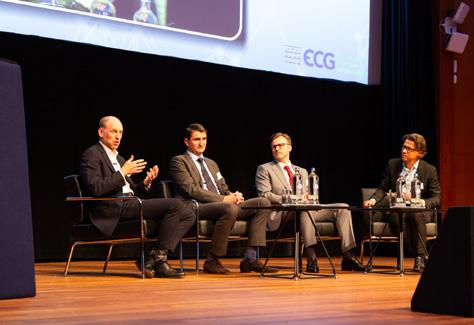
Klitz said that maybe external pressure is exactly what the EU needs to speed things up.
If it works – scale; if it doesn’t – scrap
Session 3 put politics aside, focusing on all-things-tech. First was Peter Hörndlein, Managing Director, Vehicle Logistics, Volkswagen Konzernlogistik, who explained the difference between autonomous and automated driving, the latter being a bridging step towards the former. He then detailed the Auto Log project, in which vehicles are driven by external sensors for yard management (receiving & parking vehicles from different modes of transport). If successful, the concept will be rolled out to ship loading.
François Prince, General Manager Vehicles Logistics Engineering, Renault, shared the lessons learned from having to deal with multiple crises, including the coronavirus pandemic, global supply chain headaches, and others (and new ones yet to come).
He said that the automotive sector, OEMs included, nowadays needs to deliver more than previously, while concurrently having to deal with less predictability. Renault’s answer to this is total visibility through digitalisation.
Prince’s team has developed so-called control towers that gather data to map the supply
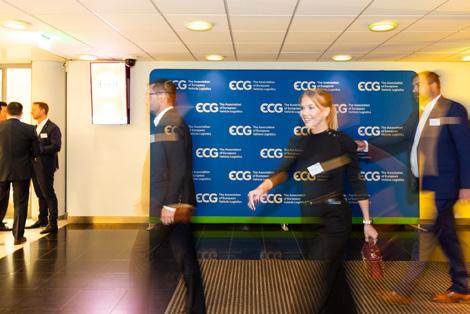

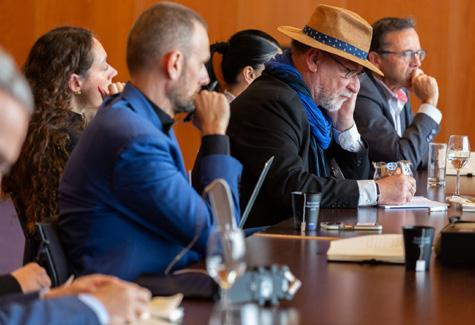
chain across all tiers to react accordingly if something happens.
Having mentioned data, it was the main ‘hero’ of the closing debate, Hörndlein and Prince sharing the stage with Karol Niznik, SVP Production, Logistics & Procurement, AUTO1. Niznik’s perspective was unique not only because his company deals with the used car market (“no tariffs!” he highlighted smilingly), but also as it’s a digital enterprise, with visibility, tracking, and notifications – part and parcel for the modern way of delivering those ‘secondhands’ from one corner of Europe to another. What is more, Niznik’s company also developed a technology to evaluate a car’s condition –within just five seconds of scanning the vehicle. The panellists also pointed to a profound change in tech development. Pilot-to-scale-up projects took the place of big sweeping business model changes. If a solution works in one place, there are chances it’ll do fine in others. If it doesn’t work, it can be scrapped quickly without generating exorbitant costs.
Before the 2026 edition of ECG Conference, 15-16 October in Copenhagen, the Association’s General Assembly & Spring Congress will welcome its members, partners, and friends to İstanbul on 4-5 June 2026. Boğaz kıyısında görüşmek üzere!

Photos: ECG


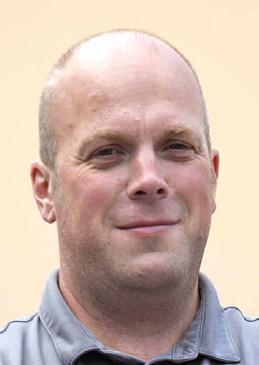
JEROEN EIJSINK
CEO, HHLA
Eijsink, who studied Business Administration at Erasmus University Rotterdam, has 25+ years of international experience in the logistics & transport industry. Starting his career at Siemens (in what was then the digitalisation division) he then filled various management roles at Deutsche Post DHL, including CEO of DHL Freight Germany and of the Benelux & UK chapter. In 2015, he joined C.H. Robinson. In August 2023, Eijsink became CEO of the Girteka Group.
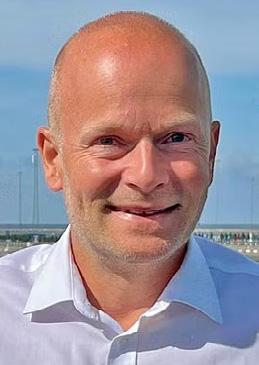
NOORA HIHNALA
HSQE Specialist, Port of Kokkola
Hihnala, who holds a Bachelor of Engineering in Industrial Management from the Central Ostrobothnia Polytechnic, has joined the Finnish seaport from KATI. During her 15 years at the company specialising in mineral exploration, she worked in several positions, from Quality and Environmental Manager to HSEQ Manager, and most recently, Administration Director. Apart from traditional HSQE areas, Hihnala will also tackle data protection and cyber-security matters in her new role.

PATRIK KNUTAR
Technical Manager, Port of Kokkola
With a Bachelor of Engineering in Construction Engineering from the Novia University of Applied Sciences, Knutar is no stranger to the Finnish seaport, where he worked as a Maintenance Supervisor from 2011 to 2016. Afterwards, he served as Technical Director for the municipalities of Kaustinen and Veteli, as well as Managing Director of Kokkolan Autoilijat and of Esari. “The sea called me back,” Knutar commented on his new appointment.
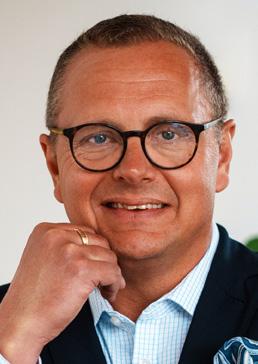
DAVID WALLGREN
Business Unit Manager, Hogia Ports & Shipping
The newly established unit, comprising Hogia Ferry Systems and Hogia Terminal Systems (some 50 employees in Finland & Sweden), will be led by, until now, Gothenburg RoRo Terminal’s Business Development Manager. Wallgren began his career as a docker at the Port of Gothenburg. Since then, he has held operational, commercial, and strategic positions in both port and shipping companies, including DFDS (Manager Operations Industry & Special Cargo).
ERIK ESKLING HANSEN
Business Developer, the Port of Trelleborg
Hansen switched from one seaport in southern Sweden (Ystad, where he held the same post) to another. Before joining the port business, he handled business development at the Swedish rail freight haulier Hector Rail. Earlier, Hansen worked for, among others, CMA CGM, Samskip, Maersk Sweden, Thor Jörgensen, and Transgroup Worldwide Logistics. Hansen is an alumnus of the Copenhagen Business School in Shipping and Maritime Law.
BJÖRN KNUTAR
CEO, Blomberg Stevedoring
Knutar has been promoted from the position of Sales Director to oversee the company that’s active in the Finnish ports of Vaasa, Kalajoki, Kristiinankaupunki, and Kemi. Knutar joined Blomberg Stevedoring in 2020 by taking up the role of Sales Manager in Vaasa. Earlier, he was Cargo Manager with Wasaline and Product Manager Trading as well as Export Sales Manager EMEA at Mirka. Knutar holds an MBA from the Haaga-Helia University of Applied Sciences.


FREDRIK RÖNNQVIST
Regional Manager – Southeast Asia, Fogmarker International
Rönnqvist, until recently the company’s Key Account Manager in charge of the Material Handling segment, will join Fogmarker’s representative office in Bangkok. Previously, he worked for Volvo Penta as Business Development Manager, Konecranes Lifttrucks as International Sales Manager, and Robert Bosch as Sales Engineer.
PER ZANDRÉN CEO, Lakeway Link
The ro-ro JV of Wallenius och Greencarrier is now led by the former CEO of Aditro Logistics (where Zandrén started as COO). Holder of a master’s degree in Engineering in Logistics from the Chalmers University of Technology, Zandrén had been working for DHL Supply Chain for many years, including as Managing Director –Norway & Sweden North. He was also Head of the Swedish Bus Division at Transdev Sweden and a consultant for the Swedish Trade Council.

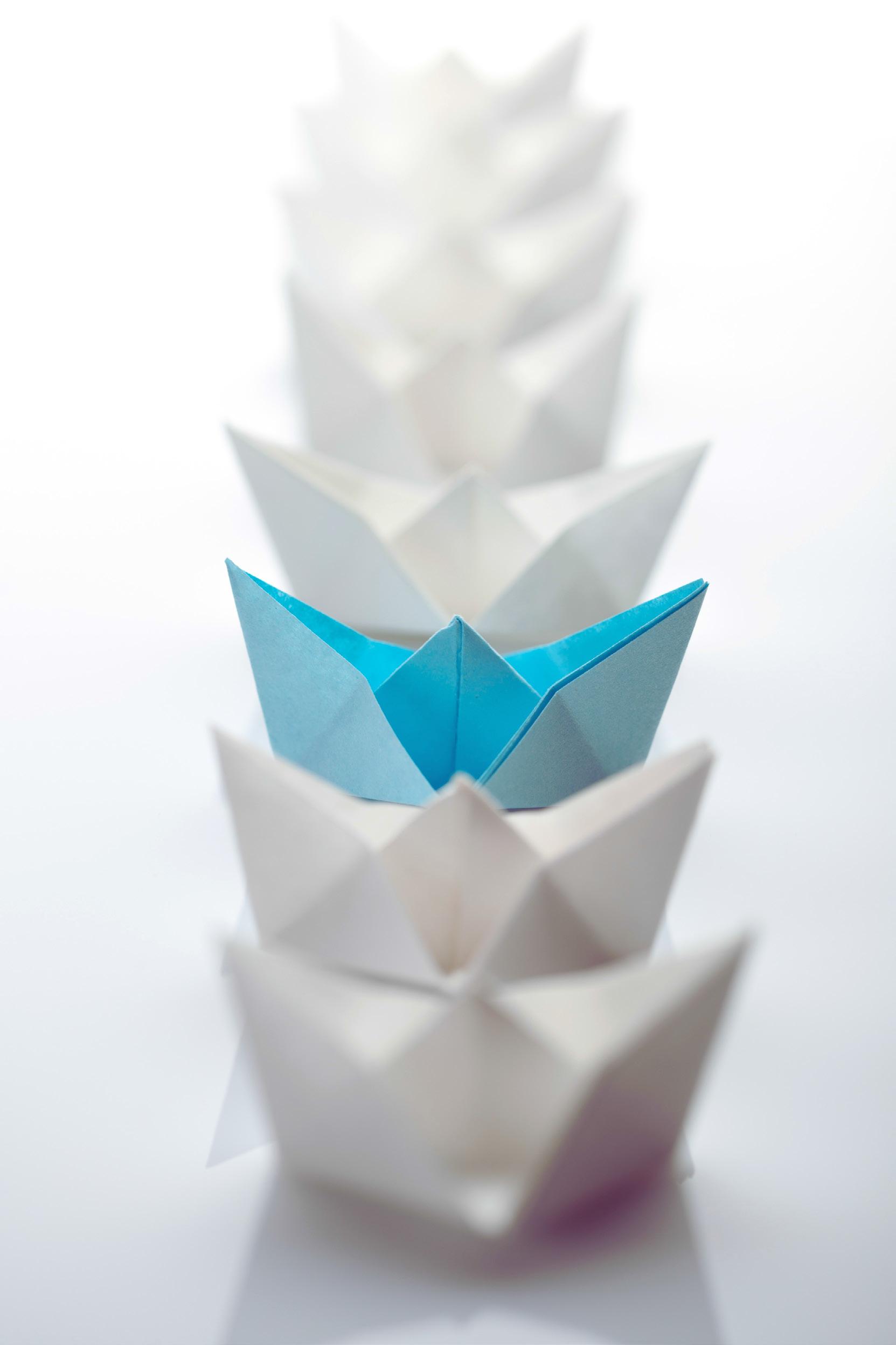


BALTIC GREEN MAP 2025

Overview of products, infrastructure, Overview of products, infrastructure, services, and many more greenstuff services, and many more greenstuff in one place – on your wall, in one place – on your wall, computer, or phone! Plus the digital or phone! Plus the digital BALTIC GREEN MAP BALTIC GREEN MAP CATALOGUE with plenty of with plenty of wholesome details! wholesome details!



